The Project Gutenberg EBook of History of the United States, Volume 3 (of
6), by E. Benjamin Andrews
This eBook is for the use of anyone anywhere at no cost and with
almost no restrictions whatsoever. You may copy it, give it away or
re-use it under the terms of the Project Gutenberg License included
with this eBook or online at www.gutenberg.org
Title: History of the United States, Volume 3 (of 6)
Author: E. Benjamin Andrews
Release Date: December 5, 2007 [EBook #23748]
Language: English
Character set encoding: ISO-8859-1
*** START OF THIS PROJECT GUTENBERG EBOOK HISTORY OF THE UNITED STATES ***
Produced by Don Kostuch
[Transcriber's Notes]
Text has been moved to avoid fragmentation of sentences and paragraphs.
The other five texts in this series were obtained from the 1912 edition
of original books. Volume 3 was missing from the set.
This text, Volume 3, is derived from a PDF image file of the 1896
edition
on the Internet Archive at
http://www.archive.org/details/histusearliest03andrrich
[End Transcriber's Notes]
HISTORY OF THE UNITED STATES
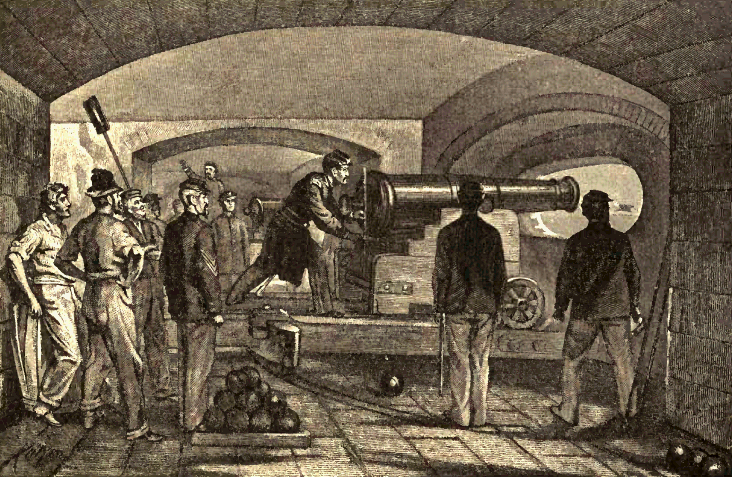
The First Gun Fired from Fort Sumter
HISTORY OF THE UNITED STATES
FROM THE EARLIEST DISCOVERY
OF AMERICA TO THE PRESENT DAY
BY
E. BENJAMIN ANDREWS
PRESIDENT OF BROWN UNIVERSITY
WITH 400 ILLUSTRATION AND MAPS
VOLUME III
NEW YORK
CHARLES SCRIBNER'S SONS
1896
COPYRIGHT, 1894, BY
CHARLES SCRIBNER'S SONS
Press of J. J. Little & Co.
Astor Place. New York
CONTENTS
PERIOD II
WHIGS AND DEMOCRATS TILL THE
DOMINANCE OF THE SLAVERY CONTROVERSY
1814--1840
CHAPTER I. THE WHIG PARTY AND ITS MISSION.
The Word "Whig."
Republican Prestige.
Schism.
Adams's Election.
Five Doctrines of Whiggism.
I. Broad Construction of the Constitution.
II. The Bank.
Death of Old and Birth of New.
Opposition by Jackson.
III. The Tariff of 1816.
Its Object.
IV. Land.
Whig versus Democratic Policy.
V. Internal Improvements
Rivers and Harbors.
Need of Better Inland Communication.
Contention between the Parties.
Whig Characteristics.
Adams.
Webster.
His Political Attitude.
Clay.
His Power, as an Orator.
His Duel with Randolph.
His Wit.
His Influence.
CHAPTER II. FLORIDA AND THE MONROE DOCTRINE.
Florida's Disputed Boundary.
West Florida Occupied.
Jackson Seizes East Florida.
Puts to Death Ambrister and Arbuthnot.
His Excuse.
Defended by Adams.
Sale of Florida.
Revolt of Spanish America.
Monroe's Declaration.
Its Origin.
CHAPTER III. THE MISSOURI COMPROMISE.
Missouri Wishes Statehood.
Early History of Slavery.
Hostility to it.
First Abolitionist Societies.
Ordinance of 1787.
Slavery in the North.
In the South.
Pleas for its Existence.
Missouri Compromise.
Pro-slavery Arguments.
The Policy Men.
Anti-slavery Opinions.
Difficulties of the Case.
The Anti-slavery Side Ignores these.
CHAPTER IV. THE GREAT NULLIFICATION.
Rise of Tariff Rates after 1816.
Relations of Parties and Sections to the Tariff.
Minimum Principle.
Tariff of Abominations Adopted.
Harmful to the South.
Nullification Project.
Calhoun's Life and Pet Political Theory.
South Carolina Recedes.
Compromise Tariff.
State Rights and Central Government.
Webster's Plea.
CHAPTER V. MINOR PUBLIC QUESTIONS OF JACKSON'S "REIGN."
Jackson's Life.
Mistaken Ideas.
Civil Service Reform.
Perfecting of Party
Organization in the Country.
Jackson and the United States Bank.
His Popularity.
Revival of West Indian Trade.
French Spoliation Claims.
Paid.
Our Gold and Silver Coinage.
Gold Bill.
Increased Circulation of Gold.
Specie Circular.
CHAPTER VI. THE FIRST WHIG TRIUMPH.
Election of Harrison in 1840.
Causes.
Jackson's Violence.
Sub-treasury Policy.
Panic of 1837.
Decrease of Revenue.
Whig Opposition to Slavery.
Seminole War.
Amistad Case.
Texan Question.
"Tippecanoe and Tyler too."
CHAPTER VII. LIFE AND MANNERS IN THE FOURTH DECADE.
Population and Area.
The West.
The East.
An American Literature.
Newspaper
Enterprise, Mails, Eleemosynary Institutions.
American Character.
Temperance Reform.
The Land of the Free.
Religion.
Anti-masonic Movement.
Banking Craze.
Moon Hoax.
Party Spirit.
Jackson as a Knight Errant.
His Self-will.
Enmity between Adams and Jackson.
Costumes.
CHAPTER VIII. INDUSTRIAL ADVANCE BY 1840.
F. C. Lowell and his Waltham Power-loom.
Growth of Factory System.
New Corporation Laws.
Gas, Coal, and Other Industries.
The Same Continued.
The National Road.
Stages and Canals.
Ocean Lines.
Beginning of Railroads.
Opposition.
First Locomotive.
Multiplication of Railroads.
PERIOD III
THE YEARS OF SLAVERY CONTROVERSY
1840-1860
CHAPTER I. SLAVERY AFTER THE MISSOURI COMPROMISE.
Cotton and Slavery.
Evils of Slavery: Social, Economic.
Slave Insurrections.
Turner's Rebellion.
Abolition in Virginia.
Black Laws.
Lull in Anti-slavery
Agitation.
Colonization Society.
Fugitive Slave Laws.
Prigg's Case.
Personal Liberty
Laws in the North.
Kidnapping Expeditions.
Domestic Slave-trade.
Non-emancipation Laws.
Business Relations between North and South.
CHAPTER II. "IMMEDIATE ABOLITION."
Renewed Hostility to Slavery.
Lundy.
Garrison.
Affiliations of this Movement.
The New England Anti-slave Society.
Significance, Purpose, Work.
Methods of Abolitionists.
Southern Opposition.
Northern.
Anti-abolitionist Riots at the North.
Murder of Lovejoy.
Outrages against Northern Blacks.
Colored Schools Closed.
Schism among the Abolitionists.
The Liberty Party.
Ultra-abolitionists' Unreason.
Why Abolitionism Spread.
Ambiguity of the Constitution.
Seizure of Black Seamen.
Grievances on both Sides.
CHAPTER III. THE MEXICAN WAR.
Texas Declares her Independence.
Battle of San Jacinto.
The Democracy Favors
Annexation.
Calhoun's Purpose.
Opposition of Clay and the Whigs.
Texas Admitted to the Union.
Causes of the War.
The Nueces vs. the Rio Grande.
Preliminary Operations.
Battle of Palo Alto.
Declaration of War.
Monterey Captured.
Santa Anna again President.
Buena Vista.
Taylor's Victory.
Scott Appointed to Chief Command.
Capture of Vera Cruz.
Cerro Gordo.
Jalapa.
Re-enforced by Pierce.
On to the City of Mexico.
Contreras.
Churubusco.
Molino del Rey.
Storming of Chapultepec.
Capture of the Capital.
Treaty of Guadalupe Hidalgo.
Its Conditions.
The Oregon Question.
CHAPTER IV. CALIFORNIA AND THE COMPROMISE OF 1850.
Invasion of New Mexico.
Exploration and Seizure of California.
Discovery of Gold.
Resulting Excitement.
Increase of Population.
Gold Yield.
Early Law and Government.
Slavery's Victory.
The Wilmot Proviso.
Taylor President.
Application by California for Admission to the Union.
Clay's Omnibus Bill.
Webster Superseded by Sumner.
Passage of the Omnibus Compromise.
California a State.
Enlargement of Texas.
New Fugitive Slave Law.
Revival of Abolitionism.
Underground Railroad.
Rendition of Anthony Burns.
Other Cases.
CHAPTER V. THE FIGHT FOR KANSAS.
Plot against the Missouri Compromise.
Pierce's Election.
The Kansas-Nebraska Bill.
Abrogation of the Missouri Compromise.
Squatter Sovereignty.
Anti-slavery Emigration to Kansas.
Political Jobbery by the Slavocracy.
Topeka Convention.
Kansas Riots.
Lecompton Constitution.
Opposed by Free-State Men.
Kansas Admitted to the Union.
Assault upon Sumner.
Southern Repudiation of the Douglas Theory.
Dred Scott Decision.
Startling Assumption of the Supreme Court.
Effect.
Counter-theory.
CHAPTER VI. SLAVERY AND THE OLD PARTIES.
Democracy and Whiggism.
Ambiguous Attitude of the Latter toward Slavery.
The Creole Case.
Giddings's Resolutions.
Quincy Adams as an Abolitionist.
The First Gag Law.
Adams's Opposition.
The Second and Third.
Their Repeal.
Pro-slavery Whigs.
Submission to Slavocracy.
Its Insolent Demands.
Death of Whiggism.
Americanism.
The Know-Nothings.
Revolt from the Democracy at the North.
CHAPTER VII. THE CRISIS.
Consolidation of Anti-slavery Men.
Worse Black Laws.
Schemes for Foreign Conquest.
Lopez's and Walker's Expedition.
Ostend Manifesto.
Supremacy of Slavery.
Rise of Free-soilers.
Incipient Republicanism.
Republican Doctrine.
John Brown's Raid.
Schism between the Northern and the Southern Democrats.
Nomination of Douglas.
Breckenridge and Lane.
Bell and Everett.
Lincoln and Hamlin.
Lincoln's Popularity.
His Election to the Presidency.
CHAPTER VIII. MATERIAL PROGRESS
Population and Economic Prosperity.
Growth of the West.
Indian Outbreaks.
Improvements farther East.
Canals and Railroads.
The Steam Horse in the West.
Morse's Telegraph.
Ocean Cables.
Minor Inventions.
Petroleum.
Financial Crisis of 1857.
PERIOD IV
CIVIL WAR AND RECONSTRUCTION
1860-1868
CHAPTER I. CAUSES OF THE WAR.
An "Irrepressible Conflict."
Growth of North.
Influence of Missouri Compromise Repeal.
Slavery as Viewed by the South.
Stephens.
Anti-Democratic Habits of Thought.
Compact Theory of the Union.
State Consciousness, South.
Argument for the Calhoun Theory.
Secession not Justifiable by this.
Moderates and Fire-eaters.
Northern Grievances.
Do not Excuse Secession.
Lincoln's Election.
Patriotic and Philanthropic Considerations Ignored.
Prudence also.
Resources of South and of North.
CHAPTER II. SECESSION
Threats of Secession before 1860.
By New England.
By the South in 1856.
Governor Wise.
The 1860 Campaign.
Attitude of South Carolina.
Of the Gulf States.
Georgia, North Carolina, Louisiana.
Election of Lincoln.
South Carolina will Secede.
Judge Magrath.
The Palmetto State Goes.
Enthusiasm.
The State Plays Nation.
Effect upon Other States.
Mississippi, Florida, Alabama, Georgia, Louisiana.
and Texas Follow.
Strong Union Spirit Still.
Vain.
Georgia and Secession.
The Question in Louisiana, Kentucky, Tennessee,
Virginia, Missouri, Arkansas, North Carolina.
Seizure of United States Property.
Floyd's Theft.
Fort Moultrie Evacuated for Sumter.
Fort Pickens.
New Orleans Mint.
Twiggs's Surrender.
Theory of Seceding States as to Property Seized.
Southern Confederacy.
Davis President.
His History.
Inaugural Address.
Powers.
Confederate Government and Constitution.
Slavery.
State Sovereignty.
Tariff.
Good Features.
Bright Prospects of the New Power.
CHAPTER III. THE NORTH IN THE WINTER OF 1860-61.
Apathy.
Disbelief in South's Seriousness.
Divided Opinion.
Suggestions toward Compromise.
Anti-coercion.
Convention at Albany.
Mayor Wood of New York.
Buchanan's Vacillation.
Treason all about Him.
Star of the West Fired on.
Inaction of Congress.
Crittenden's Compromise Lost.
Washington Peace Congress.
Vain.
Earnestness of South.
Lincoln Inaugurated.
His Address.
How Received.
His Difficult Task.
Plight of Army, Navy, Treasury.
Sumter Fired on.
Defended.
Evacuated.
Effect at North.
War Spirit.
75,000 Volunteers.
The Sixth Massachusetts in Baltimore.
Washington in Danger.
General Scott's Measures.
March of the Massachusetts Eighth and the New York Seventh.
Their Arrival in Washington.
CHAPTER IV. WAR BEGUN
Both Sides Expect a Brief Struggle.
South's Advantages.
Call for Three Years' Men.
Butler in Baltimore.
Maryland Saved to the Union.
Alexandria and Arlington
Heights Occupied.
Ellsworth's Death.
Each Side Concentrates Armies in Virginia.
Fight at Big Bethel.
At Vienna.
The Struggle in Missouri.
Lyon and Price.
Battle of Wilson's Creek.
Lyon's Death.
Fremont, Hunter, and Halleck in Missouri.
The Contest in Kentucky.
The State becomes Unionist.
In West Virginia.
Lee and McClellan.
Brilliant Campaign of the Latter.
West Virginia Made a State.
Beauregard at Manassas.
Patterson's Advance.
Harper's Ferry Taken.
"On to Richmond."
Battle of Bull Run.
Union Defeat and Retreat.
Losses.
Comments.
Depression at the North, followed by New Resolution.
McClellan.
Army of Potomac Organized.
The Capital Safe.
Affair of Ball's Bluff.
The South Hopeful.
And with Reason.
LIST OF ILLUSTRATIONS
THE FIRST GUN FIRED FROM FORT SUMTER.
WEBSTER'S HOME AT MARSHFIELD, MASS.
DANIEL WEBSTER.
(From a picture by Healy at the State Department, Washington).
THE HOUSE IN WHICH HENRY CLAY WAS BORN.
THE SCHOOL-HOUSE OF THE SLASHES.
HENRY CLAY. (From a photograph by Rockwood of an old daguerreotype).
JOHN RANDOLPH.
(From a picture by Jarvis in 1811, at the New York Historical Society).
JAMES MONROE.
(From a painting by Gilbert Stuart--now the property of T. Jefferson
Coolidge).
JOHN QUINCY ADAMS. (From a picture by Gilbert Stuart).
JOHN C. CALHOUN. (From a picture by King at the Corcoran Art Gallery).
CALHOUN'S LIBRARY AND OFFICE.
ANDREW JACKSON (From a photograph by Brady).
ROGER B. TANEY.
MARTIN VAN BUREN. (From a photograph by Brady).
GENERAL WILLIAM J. WORTH.
WILLIAM HENRY HARRISON.
(From a copy at the Corcoran Art Gallery of a painting by Beard in
1840).
JOHN TYLER. (From a photograph by Brady).
A PONY EXPRESS.
THURLOW WEED. (From an unpublished photograph by Disderi,
Paris, in 1861. In the possession of Thurlow Weed Barnes).
FROM AN OLD TIME-TABLE.
(Furnished by the ABC Pathfinder Railway Guide).
TRIAL BETWEEN PETER COOPER'S LOCOMOTIVE "TOM THUMB" AND ONE OF
STOCKTON'S AND STOKES' HORSE CARS. (From "History of the First
Locomotives in America").
PETER COOPER'S LOCOMOTIVE.
OBVERSE AND REVERSE OF A TICKET USED IN 1838 ON THE
NEW YORK & HARLEM RAILROAD.
BALTIMORE & OHIO RAILROAD, 1830.
OLD BOSTON & WORCESTER RAILWAY TICKET (ABOUT 1837).
THE "SOUTH CAROLINA," 1831, AND PLAN OF ITS RUNNING GEAR.
BOSTON & WORCESTER RAILROAD, 1835.
THE DISCOVERY OF NAT TURNER.
JOHN G. WHITTIER.
WM. LLOYD GARRISON.
WENDELL PHILLIPS.
FACSIMILE OF HEADING OF THE "LIBERATOR."
GENERAL SAM. HOUSTON.
GENERAL SANTA ANNA.
JAMES K. POLK. (After a photograph by Brady).
GENERAL WINFIELD SCOTT.
THE PLAZA OF THE CITY OF MEXICO.
ZACHARY TAYLOR. (After a photograph by Brady).
THE SITE OF SAN FRANCISCO IN 1848.
SUTTER'S MILL, CALIFORNIA, WHERE GOLD WAS FIRST DISCOVERED.
MILLARD FILLMORE.
(From a painting by Carpenter in 1853. at the City Hall, New York).
THE RENDITION OF ANTHONY BURNS IN BOSTON.
FRANKLIN PIERCE.
(From a painting by Healy, in 1852, at the Corcoran Art Gallery).
STEPHEN A. DOUGLAS.
CHARLES SUMNER.
THOMAS H. BENTON.
ABRAHAM LINCOLN. (After a rare photograph in the possession of Noah
Brooks. Only five copies of this photograph were printed).
JOHN BROWN.
WILLIAM H. SEWARD. (From a photograph by Brady).
ELIAS HOWE.
THE VANDALIA. THE PIONEER PROPELLER ON THE LAKES.
OLD STONE TOWERS OF THE NIAGARA SUSPENSION BRIDGE.
THE NEW IRON TOWERS OF THE NIAGARA BRIDGE.
BIRTHPLACE OF S. F. B. MORSE, AT CHARLESTOWN, MASS. BUILT 1775.
S. F. B. MORSE.
THE FIRST TELEGRAPHIC INSTRUMENT, AS EXHIBITED IN 1837 BY MORSE.
CALENDERS HEATED INTERNALLY BY STEAM, FOR SPREADING INDIA RUBBER INTO
SHEETS OR UPON CLOTH, CALLED THE "CHAFFEE MACHINE."
THE GREAT EASTERN LAYING THE ATLANTIC CABLE.
SOUNDING MACHINE USED BY A CABLE EXPEDITION.
CYRUS W. FIELD.
PAYING OUT CABLE GEAR. FROM CHART HOUSE.
SHORE END OF CABLE--EXACT SIZE.
BARNACLES ON CABLE.
JAMES BUCHANAN. (From a photograph by Brady).
STREET BANNER IN CHARLESTON.
MAJOR ROBERT ANDERSON.
MAJOR ANDERSON REMOVING HIS FORCES FROM FORT MOULTRIE TO FORT SUMTER,
DECEMBER 26, 1861.
JEFFERSON DAVIS.
ALEXANDER H. STEPHENS.
SCENE OF THE FIRST BLOODSHED, AT BALTIMORE.
CAPTAIN NATHANIEL LYON.
GENERAL JOHN C. FREMONT.
GENERAL IRVIN McDOWELL.
GENERAL SAMUEL P. HEINTZELMAN.
GENERAL JOSEPH E. JOHNSTON.
GENERAL GEORGE B. McCLELLAN.
LIST OF MAPS
THE UNITED STATES AFTER THE ADMISSION OF ARKANSAS, 1836.
PLAN OF THE BATTLE OF BUENA VISTA, MORNING 23D FEBRUARY, 1847.
ROUTE OF THE SIXTH MASSACHUSETTS TROOPS THROUGH BALTIMORE.
THE ROUTES OF APPROACH TO WASHINGTON.
THE SOUTHERN CONFEDERACY.
BULL RUN--THE FIELD OF STRATEGY.
BULL RUN--BATTLE OF THE FORENOON.
BULL RUN--BATTLE OF THE AFTERNOON.
PERIOD II.
WHIGS AND DEMOCRATS TILL THE DOMINANCE OF THE SLAVERY CONTROVERSY.
1814-1840
CHAPTER I.
THE WHIG PARTY AND ITS MISSION
[1820]
The term "whig" is of Scotch origin. During the bloody conflict of the
Covenanters with Charles II. nearly all the country people of Scotland
sided against the king. As these peasants drove into Edinburgh to
market, they were observed to make great use of the word "whiggam" in
talking to their horses. Abbreviated to "whig," it speedily became, and
has in England and Scotland ever since remained, a name for the
opponents of royal power. It was so employed in America in our
Revolutionary days. Sinking out of hearing after Independence, it
reappeared for fresh use when schism came in the overgrown Democratic
Party.
The republican predominance after 1800, so complete, bidding so fair to
be permanent, drew all the more fickle Federalists speedily to that
side. Since it was evident that the new party was quite as national in
spirit as the ruling element of the old, the Adams Federalists, those
most patriotic, least swayed in their politics by commercial motives,
including Marshall, the War Federalists, and the recruits enlisted at
the South during Adams's administration, also went over, in sympathy if
not in name, to Republicanism. The fortunate issue of the war silenced
every carper, and the ten years following have been well named the "era
of good feeling."
But though for long very harmonious, yet, so soon as Federalists began
swelling their ranks, the Republicans ceased to be a strictly
homogeneous party. Incipient schism appeared by 1812, at once announced
and widened by the creation of the protective system and the new United
States Bank in 1816, and the attempted launching of an internal
improvements regime in 1821, all three the plain marks of federalist
survival, however men might shun that name. Republicans like Clay,
Calhoun in his early years, and Quincy Adams, while somewhat more
obsequious to the people, as to political theory differed from old
Federalists in little but name. The same is true of Clinton, candidate
against Madison for the Presidency in 1812, and of many who supported
him.
[1825]
But to drive home fatally the wedge between "democratic" and "national"
Republicans, required Jackson's quarrel with Adams and Clay in 1825,
when, the election being thrown into the House, although Jackson had
ninety-nine electoral votes to Adams's eighty-four, Crawford's
forty-one, and Clay's thirty-seven, Clay's supporters, by a "corrupt
bargain," as Old Hickory alleged, voted for Adams and made him
President. Hickory's idea--an untenable one--was that the House was
bound to elect according to the tenor of the popular and the electoral
vote. After all this, however, so potent the charm of the old party, the
avowal of a purpose to build up a new one did not work well, Clay
polling in 1832 hardly half the electoral vote of Adams in 1828. This
democratic gain was partly owing, it is true, to Jackson's popularity,
to the belief that he had been wronged in 1825, and to the widening of
the franchise which had long been going on in the nation. Calhoun's
election as Vice-President in 1828, by a large majority, shows that
party crystallization was then far from complete. From about 1834, the
new political body thus gradually evolved was regularly called the
Whigs, though the name had been heard ever since 1825.
[1830-1833]
The doctrines characteristic of Whiggism were chiefly five:
I. Broad Construction of the Constitution.
This has been sufficiently explained in the chapter on Federalism and
Anti-Federalism, and need not be dwelt upon. The whig attitude upon it
appears in all that follows.
II. The Bank.
The First United States Bank had perished by the expiration of its
charter in 1811. It had been very useful, indeed almost indispensable,
in managing the national finances, and its decease, with the consequent
financial disorder, was a most terrible drawback in the war. Recharter
was, however, by a very small majority, refused. The evils flowing from
this perverse step manifesting themselves day by day, a new Bank of the
United States, modelled closely after the first, was chartered on April
10, 1816, Clay, Calhoun, and Webster being its chief champions.
Republican opponents, Madison among them, were brought around by the
plea that war had proved a national bank a necessary and hence a
constitutional helper of the Government in its appointed work.
In the management of this second bank there were disorder and
dishonesty, which greatly limited its usefulness. This, notwithstanding,
was considerable. The credit of the nation was restored and its treasury
resumed specie payments. But confidence in the institution was shaken.
We shall see how it met with President Jackson's opposition on every
possible occasion. In 1832 he vetoed a bill for the renewal of its
charter, to expire in 1836, and in 1833 caused all the Government's
deposits in it, amounting to ten million dollars, to be removed. These
blows were fatal to the bank, though it secured a charter from
Pennsylvania and existed, languishing, till 1839.
III. The Tariff.
Until the War of 1812 the main purpose of our tariff policy had been
revenue, with protection only as an incident. During the war
manufacturing became largely developed, partly through our own embargo,
partly through the armed hostilities. Manufacture had grown to be an
extensive interest, comparing in importance with agriculture and
commerce. Therefore, in the new tariff of 1816, the old relation was
reversed, protection being made the main aim and revenue the incident.
It is curious to note that this first protective tariff was championed
and passed by the Republicans and bitterly opposed by the Federalists
and incipient Whigs. Webster argued and inveighed vehemently against it,
appealing to the curse of commercial restriction and of governmental
interference with trade, and to the low character of manufacturing
populations.
But very soon the tables were turned: the Whigs became the high-tariff
party, the Democrats more and more opposing this policy in favor of a
low or a revenue tariff. It should be marked that even now the idea of
protection in its modern form was not the only one which went to make a
high tariff popular. There were, besides, the wish to be prepared for
war by the home production of war material, and also the spirit of
commercial retortion, paying back in her own coin England's burdensome
tax upon our exports to her shores.
IV. Land.
What may not improperly be styled the whig land policy sprung from the
whig sentiment for large customs duties. Cheap public lands, offering
each poor man a home for the taking, constantly tended to neutralize the
effect of duties, by raising wages in the manufacturing sections, people
needing a goodly bribe to enter mills in the East when an abundant
living was theirs without money and without price on removing west. As a
rule, therefore, though this question did not divide the two parties so
crisply as the others, the Whigs opposed the free sale of government
land, while the Democrats favored that policy. In spite of this,
however, eastern people who moved westward--and they constituted the
West's main population--quite commonly retained their whig politics even
upon the tariff question itself.
V. Internal Improvements.
It has always been admitted that Congress may lay taxes to build and
improve light-houses, public docks, and all such properties whereof the
United States is to hold the title. The general improvement of harbors,
on the other hand, the Constitution meant to leave to the States,
allowing each to cover the expense by levying tonnage duties. The
practice for years corresponded with this. The inland commonwealths,
however, as they were admitted, justly regarded this unfair unless
offset by Government's aid to them in the construction of roads, canals,
and river ways.
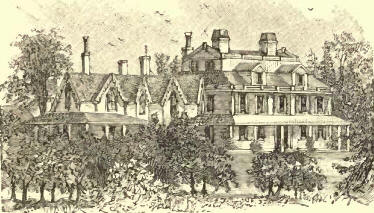
Webster's Home at Marshfield. Mass.
The War of 1812 revealed the need of better means for direct
communication with the remote sections of the Union. Transportation to
Detroit had cost fifty cents per pound of ammunition, sixty dollars per
barrel of flour. All admitted that improved internal routes were
necessary. The question was whether the general Government had a right
to construct them without amendment to the Constitution.
The Whigs, like the old Federalists, affirmed such right, appealing to
Congress's power to establish post-roads, wage war, supervise
inter-state trade, and conserve the common defence and general welfare.
As a rule, the Democrats, being strict constructionists, denied such
right. Some of them justified outlay upon national rivers and commercial
harbors under the congressional power of raising revenue and regulating
commerce. Others conceded the rightfulness of subsidies to States even
for bettering inland routes. Treasury surplus at times, and the many
appropriations which, by common consent, had been made under Monroe and
later for the old National Road, encouraged the whig contention; but the
whig policy had never met general approval down to the time when the
whole question was taken out of politics by the rise of the railroad
system after 1832. The National Road, meantime, extending across Ohio
and Indiana on its way to St. Louis, was made over in 1830 to the States
through which it passed.
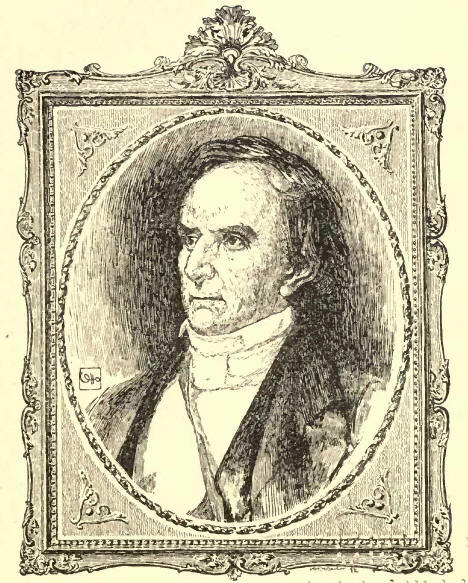
Daniel Webster. From a picture by Healy at the State Department,
Washington.
The Whig Party deserves great praise as the especial repository, through
several decades, of the spirit of nationality in our country. It
cherished this, and with the utmost boldness proclaimed doctrines
springing from it, at a time when the Democracy, for no other reason
than that it had begun as a state rights party, foolishly combated
these. Yet Whiggism was mightier in theories than in deeds, in political
cunning than in statesmanship. It was far too fearful, on the whole,
lest the country should not be sufficiently governed. To secure power it
allied itself now with the Anti-Masons, strong after 1826 in New
England, New York, and Pennsylvania; and again with the Nullifiers of
South Carolina, Georgia, and Tennessee, led by Calhoun, Troup, and
White. It did the latter by making Tyler, an out-and-out Nullifier, its
Vice-President in 1840.
A leading Whig during nearly all his political career was John Quincy
Adams, one of the ablest, most patriotic, and most successful presidents
this country has ever had. He possessed a thorough education, mainly
acquired abroad, where, sojourning with his distinguished father, he had
enjoyed while still a youth better opportunities for diplomatic training
than many of our diplomatists have known in a lifetime. He went to the
United States Senate in 1803 as a Federalist. Disgusted with that party,
he turned Republican, losing his place. From 1806 to 1809 he was
professor in Harvard College. In the latter year Madison sent him
Minister to St. Petersburg. He was commissioner at Ghent, then Minister
to England, then Monroe's Secretary of State, then President.
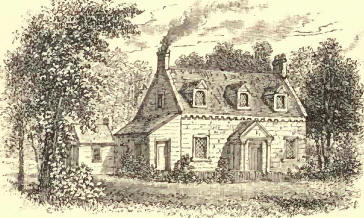
The House in which Henry Clay was Born.
But Mr. Adams's best work was done in the House of Representatives after
he was elected to that body in 1830. He sat in the House until his
death, in 1848--its acknowledged leader in ability, in activity, and in
debate. Friend and foe hailed him as the "Old Man Eloquent," nor were
any there anxious to be pitted against him. He spoke upon almost every
great national question, each time displaying general knowledge; legal
lore, and keenness of analysis surpassed by no American of his or any
age.
Webster was, however, the great orator of the party. Reared upon a farm
and educated at Dartmouth College, he went to Congress from New
Hampshire as a Federalist in 1813. Removing to Boston, he soon entered
Congress from Massachusetts, first as representative, then as senator,
and from 1827 was in the Senate almost continuously till 1850. He was
Secretary of State under Harrison and Tyler, and again in the
Taylor-Fillmore cabinet from 1850.
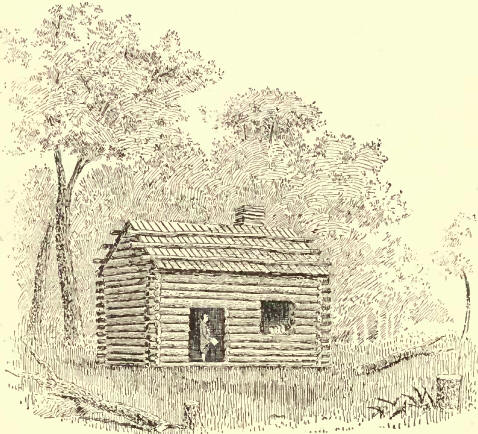
The School-house of the Slashes.
As an orator Webster had no peer in his time, nor have the years since
evoked his peer. He was an influential party leader, and repeatedly
thought of for President, though too prominent ever to be nominated. On
two momentous questions, the tariff and slavery, he vacillated, his
dubious action concerning the latter costing him his popularity in New
England.
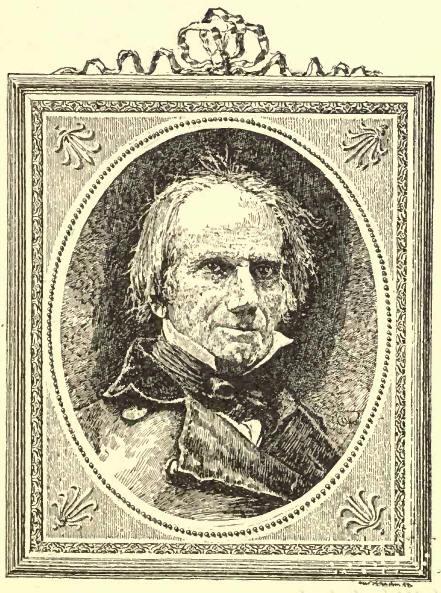
Henry Clay. From a photograph by Rockwood of an old daguerreotype.
Yet in many respects the most interesting figure in the party was Henry
Clay. He was born amid the swamps of Hanover County, Va., and had grown
up in most adverse surroundings. His father, a Baptist clergyman, died
while he was an infant, leaving him destitute. In "The Slashes," as the
neighborhood where Clay passed his childhood was called, he might often
have been seen astride a sorry horse with a rope bridle and no saddle,
carrying his bag of grain to the mill. He had attended only district
schools. After obtaining the rudiments of a legal education in Richmond
by service as a lawyer's clerk, he removed to Kentucky. He was soon
famous as a criminal lawyer, and a little later as a politician. The
rest of his life was spent in Congress or cabinet.
Clay's speeches read ill, but were powerful in their delivery. He spoke
directly to the heart. As he proceeded, his tall and awkward form swayed
with passion. His voice was sweet and winsome. Once Tom Marshall was to
face him in joint debate over a salary grab for which Clay had voted.
Clay had the first word, and as he warmed to his work Marshall slunk
away through the crowd in despair. "Come back," said Clay's haters to
him; "you can answer every point." "Of course," replied Marshall, "but I
can't get up there and do it now." The common people shouted for Clay as
they shouted for neither Webster nor Adams. He had infinite fund of
anecdote, remembered everyone he had ever seen, and was kindly to all.
John Tyler is said to have wept when Clay failed of the Presidential
nomination in the Whig Convention of 1839.
[1840]
Clay's vices and inconsistencies were readily forgiven. He had denounced
duelling as barbarous, yet when sharp-tongued John Randolph referred to
him and Adams as having, in 1825, formed "the coalition of Blifil and
Black George, the combination of the Puritan and the blackleg"--for Clay
gambled--Clay challenged him. They met, the diminutive Randolph being in
his dressing-gown. Neither was hurt, as Randolph fired in air and Clay
was no shot. Being asked why he did not kill Randolph, Clay said: "I
aimed at the part of his gown where I thought he was, but when the
bullet got there he had moved." In 1842, when Lord Ashburton was in
Washington, there was a famous whist game, my lord, with Mr. Crittenden,
playing against Clay and the Russian Minister, Count Bodisco, while
Webster looked on. "What shall the stake be?" asked his lordship. "Out
of deference to Her Majesty," said Clay, "we will make it a sovereign."
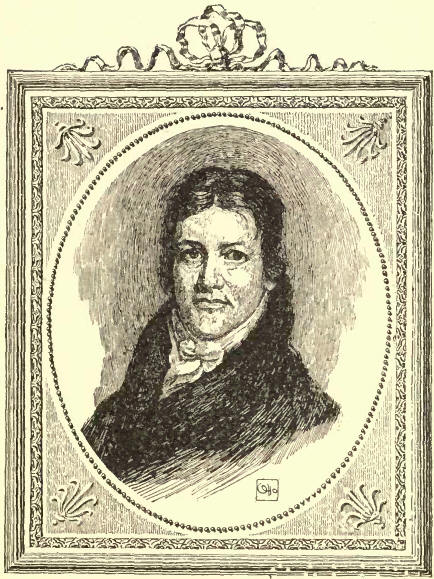
John Randolph.
From a picture by Jarvis in 1811, at the New York Historical Society.
Emphatically patriotic, super-eminent in debate, ambitious, adventurous
in political diplomacy, a hard worker, incessant in activity for his
party, temperate upon the slavery question, whole-souled in every
measure or policy calculated to advance nationality, this versatile man
may be put down as foremost among the leaders of the Whig Party from its
origin till his death.
CHAPTER II.
FLORIDA AND THE MONROE DOCTRINE
[1816]
It was a delicate question after the Louisiana purchase how much
territory it embraced east of the Mississippi. Louisiana had under
France, till 1762, reached the Perdido, Florida's western boundary at
present, and was "retroceded" by Spain to France in 1800 "with the same
extent that it had when France possessed it." The United States of
course succeeded to whatever France thus recovered. Spain claimed still
to own West Florida, the name given by Great Britain on receiving it
from France in 1763 to the part of Louisiana between the Perdido and the
Mississippi. Spain had never acquired the district from France, but
obtained it by conquest from Great Britain during our Revolution.
This claim by Spain, based only on the "retro" in the treaty of 1800,
our Government viewed as fanciful, regarding West Florida undoubtedly
ours through the Louisiana purchase. Spain was intractable, first of
herself, later still more so through Napoleon's dictation. Hence our
offer, in Jefferson's time, to avoid war, of a lump sum for the two
Floridas was spurned by her. In 1810 and 1811, to save it from
anarchy--also to save it from Great Britain or France, now in the
whitest heat of their contest for Spain--we occupied West Florida, as
certainly entitled to it against those powers, yet with no view of
precluding further negotiations with Spain. When in 1812 Louisiana
became a State, its eastern boundary ran as now, including a goodly
portion of the region in debate.
[1817]
The necessity of acquiring East Florida, too, was more and more
apparent. That country was without rule, full of filibusterers,
privateers, hostile refugee Creeks and runaway negroes, of whose
services the English had availed themselves freely during the war of
1812, when Spaniards and English made Florida a perpetual base for
hostile raids into our territory. A fort then built by the
English on
the Appalachicola and left intact at the peace with some arms and
ammunition, had been occupied by the negroes, who, from this retreat,
menaced the peace beyond the line. Spain could not preserve law and
order here. This was perhaps a sufficient excuse for the act of General
Gaines in crossing into Florida and bombarding the negro fort, July 27,
1816. Amelia Island, on the Florida coast, a nest of lawless men from
every nation, was in 1817 also seized by the United States with the same
propriety. Knowledge that Spain resented these acts encouraged the
Floridians. Collisions continually occurred all along the line, finally
growing into general hostility. Such was the origin of the First
Seminole War.
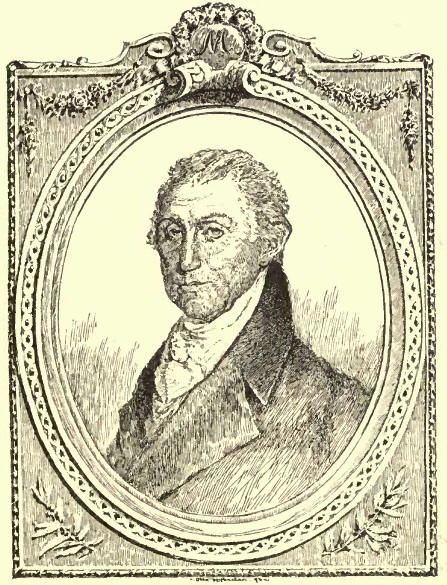
James Monroe. From a painting by Gilbert Stuart--now the property of T.
Jefferson Coolidge.
[1818]
December, 1817, Jackson was placed in command in Georgia. To clear out
the filibusterers, the chief source of the Indians' discontent ever
since before the Creek War, the hero of New Orleans, mistakenly
supposing himself to be fortified by his Government's concurrence,
boldly took forcible possession of all East Florida. Ambrister and
Arbuthnot, two officious English subjects found there, he put to death.
This procedure was quite characteristic of Old Hickory. He acted upon
the theory that by the law of nations any citizen of one land making war
upon another land, the two being at peace, becomes an outlaw.
International law has no such doctrine, and most likely the maxim
occurred to Jackson rather as an excuse after the act than in the way of
forethought. Nor was it ever proved that the two victims were guilty as
Jackson alleged. With him this probably made little difference. Having
undertaken to quiet the Floridian outbreaks he was determined to
accomplish his end, whatever the consequences of some of his means.
With the country the New Orleans victor, who had now dared to hang a
British subject, was ten times a hero, but the deed confused and
troubled Monroe's cabinet not a little. Calhoun wished General Jackson
censured, while all his cabinet colleagues disapproved his high-handed
acts and stood ready to disavow them with reparation. On this occasion
Jackson owed much to one whom he subsequently hated and denounced, viz.,
Quincy Adams, by whose bold and acute defence of his doubtful doings,
managed with a fineness of argument and diplomacy which no then American
but Adams could command, he was formally vindicated before both his own
Government and the Governments of England and Spain.
The posts seized had of course to be given up, yet our bold invasion had
rendered Spain willing at last to sell Florida, while Great Britain,
wishing our countenance in her opposition to the anti-progressive,
misnamed Holy Alliance of continental monarchs, concurred. Spain after
all got the better of the bargain, as we surrendered all claim to Texas,
which the Louisiana purchase had really made ours.
[1823]
The Florida imbroglio nursed to its first public utterance a sentiment
which has ever since been spontaneously taken as a principle of American
public policy, almost as if it were a part of our law itself. Spain's
American dependencies had been sensible enough to avail themselves of
that land's distraction in Napoleon's time, to set up as states on their
own account. She naturally wanted them back. Ferdinand VII. withheld
till 1820 his signature of the treaty ceding Florida, in order to
prevent--which, after all, it did not--our recognition of these
revolted provinces as independent nations. Backed by the powerful
Austrian minister, Metternich, and by the Holy Alliance, France, having
aided Ferdinand to suppress at home the liberal rebellion of 1820-23,
began to moot plans for subduing the new Spanish-American States. Great
Britain opposed this, out of motives partly commercial, partly
philanthropic, partly relating to international law, yet was unwilling
so early to recognize the independence of those nations as the United
States had done.
Assured at least of England's moral support, President Monroe in his
message of December, 1823, declared that we should consider any attempt
on the part of the allied monarchs "to extend their system to any
portion of this hemisphere as dangerous to our peace and safety," and
any interposition by them to oppress the young republics or to control
their destiny, "as a manifestation of an unfriendly disposition toward
the United States." This, in kernel, is the first part of Monroe's
doctrine.
The second part added: "The American continents, by the free and
independent condition which they have assumed and maintain, are
henceforth not to be considered as subjects for future colonization by
any European powers." The meaning of this was that the mere hap of first
occupancy on the continent by the citizens of any country would not any
longer be recognized by us as giving that country a title to the spot
occupied.
These important doctrines--for though akin in principle they are really
two--were no sudden creation of individual thought, but the result
rather of slow processes in the public mind. Germs of the first are
traceable to Washington; express statements of both, yet not essentially
detracting from Monroe's originality, to Jefferson. Both were put in
form by Quincy Adams, Monroe's Secretary of State. Especially Monroe's,
we believe, is the second, a resolution to which Russia's advance down
the Pacific coast, and more still the recent vexations from the
proximity of Spain in Florida, had pushed him.
CHAPTER III.
THE MISSOURI COMPROMISE
Louisiana having become a State in 1812, that portion of the purchase
north of the thirty-third degree took the name of the Missouri
Territory. St. Louis was its centre of population and of influence.
[1818]
Being found in this extensive domain at the purchase, slavery had never
been hindered in its growth. It had therefore taken firm root and was
popular. The application, early in 1818, of the densest part of Missouri
Territory for admission into the Union as a slave State, called
attention to this threatening status of slavery beyond the Mississippi,
and occasioned in Congress a prolonged, able, angry, and momentous
debate. Jefferson, still alive, wrote, "The Missouri question is the
most portentous which has ever threatened the Union. In the gloomiest
hour of the Revolutionary War I never had apprehensions equal to those
which I feel from this source."
To see the bearing of the tremendous question thus raised, we have need
of a retrospect. Property in man is older than history and has been
nearly universal. It cannot be doubted that in an early stage of human
development slavery is a means of furthering civilization. Negro slavery
originated in Africa, spread to Spain before the discovery of America,
to America soon after, and from the Spanish colonies to the English. The
first notice we have of it in English America is that in
1619 a Dutch ship landed twenty blacks at Jamestown for sale. The Dutch
West India Company began importing slaves into Manhattan in 1626. There
were slaves in New England by 1637. Newport was subsequently a great
harbor for slavers. Georgia offered the strongest resistance to the
introduction of the system, but it was soon overcome. Till about 1700,
Virginia had a smaller proportion of slave population than some northern
colonies, and the change later was mostly due to considerations not of
morality but of profit. Anti-slavery cries were indeed heard from an
early period, but they were few and faint. Penn held slaves, though
ordering their emancipation at his death. Whitfield thought slavery to
be of God. But its most culpable abettor was the English Government,
moved by the profits of the slave trade. A Royal African Company, with
the Duke of York, afterward James II., for some time its president, was
formed to monopolize this business, which monarchs and ministries
furthered to the utmost of their power.
Thus the Revolution found slavery in all the colonies, north as well as
south. But it was then, so far south as Virginia, thought to be an evil.
That commonwealth had passed many laws to restrain it, but the King had
commanded the Governor not to assent to any of them. The Legislature,
replying, stigmatized the traffic as inhuman and a threat to the very
existence of the colony. Hostility extended from the trade to slavery
itself. Jefferson was for emancipation with deportation, and trembled
for his country as he reflected upon the wrong of slavery and the
justice of God. Patrick Henry, George Mason, Peyton Randolph,
Washington, Madison, in a word all the great Virginians of the time held
similar views.
The Quakers of Pennsylvania were, however, the most aggressive of
slavery's foes. So early as 1775 a society, the first in America if not
in the world for promoting its abolition, was formed in Pennsylvania. In
1789 it was incorporated, with Franklin for president. Similar
organizations soon rose in several northern States, numbering among
their members many of the most eminent men in the land. The British
Abolition Society, formed in 1787, and the labors of Wilberforce,
Clarkson, and Zachary Macaulay against the slave trade in the West
Indies, had influence here, as had still more the French Assembly's bold
proclamation of the Rights of Man.
The Ordinance of 1787 for the Northwest Territory marked a most decisive
point in the history of slavery. By its decree, in Jefferson's language,
there was never to be either slavery or involuntary servitude in the
said territory otherwise than in punishment for crimes. It is to the
everlasting honor of the southern members then in the Continental
Congress that they all voted for this inhibition. Virginia, whose assent
as a State was necessary to its validity, she having at this time rights
over much of the domain in question, also concurred. Whatever the
strictly legal weight of this prohibition over the immense Louisiana
purchase, it certainly aided much in confirming freedom as the
presupposition and maxim of our law over all our national territory.
Vermont had never recognized slavery save to prohibit it in its first
constitution. In New Hampshire it existed but nominally. The
Massachusetts constitution of 1780 virtually ended it in that State.
Gradual abolition statutes passed in Pennsylvania in 1780, in Rhode
Island and Connecticut in 1784. The constitution made it possible to
forbid the importation of slaves in 1808. A national law to that effect
was passed in 1807, making the trade illegal and affixing to it heavy
penalties. The American Colonization Society was formed in 1816 for the
purpose of negro deportation. It did little of this, but rendered some
service toward carrying out the act against slave importation. A new law
in 1820, which made this traffic piracy, punishable with death, was
partly due to its influence. Also many, like Birney, Gerrit Smith and
the Tappans, who began as colonizationists, subsequently became
abolitionists.
Notwithstanding all these influences slavery increased in strength every
year. South Carolina and Georgia were finding it exceedingly profitable
for cotton and rice culture, and the income from slave traffic into the
vast opening lands of Tennessee and Kentucky constituted an irresistible
temptation. In spite of the law of 1807 and of the indescribable horrors
of the business, even the foreign slave trade went on. The institution
found many defenders in the Federal Convention of 1787, and in the first
and subsequent Congresses. The pleas began to be raised, so current
later, that the negro was an inferior being, slavery God's ordinance, a
blessing to slaves and masters alike, and emancipation a folly. Now
began also that policy of bravado by which, for sixty years, the friends
of slavery bullied their opponents into shameful inaction upon that
accursed thing politically as well as morally, which was so nearly to
cost the nation its life. Thus stood matters when the Missouri
Compromise was mooted in the national Legislature.
We hardly need say that this strife ended in a compromise. Missouri was
created a slave State, balanced by Maine as a free State, but at the
same time slavery was to be excluded forever from all the remainder of
the Louisiana purchase north of 36 degrees 30 minutes, the
southern
line of Virginia and Kentucky as well as of Missouri itself. The land
between Missouri and Louisiana had been in 1819 erected into the
"Territory of Arkansaw."
In the memorable discussion over this issue, involving the country as
well as Congress, two sorts of argumentation were heard in favor of the
suit of Missouri. The genuine pro-slavery men urged the sacredness of
property as such, and the special sacredness of property-right in slaves
as tacitly guaranteed by the Constitution. They also made much of the
third article of the Louisiana purchase treaty. This read as follows:
"The inhabitants of the ceded territory shall be incorporated in the
Union of the United States and admitted as soon as possible, according
to the principles of the Federal Constitution, to the enjoyment of all
the rights, advantages, and immunities of citizens of the United States;
and in the meantime they shall be maintained and protected in the free
enjoyment of their liberty, property, and the religion which they
profess."
There were with these, men who acted from mere policy, thinking it best
to admit the slave State because of the difficulty and also the danger
to the Union of suppressing slavery there. They appealed as well to the
sacred compromises in the Constitution, meaning the permission at first
to import slaves, the three-fifths rule for slave representation in
Congress, and the fugitive slave clause. They spoke much of the
necessity of preserving the balance of power within the Union, and of
Congress's inaction as to slavery in the Louisiana purchase hitherto,
and also in Florida. These arguments won many professed foes of slavery,
as Jefferson, Madison, Monroe and Quincy Adams. In all Congress Clay was
the most earnest pleader for the compromise.
To all these arguments the unbending friends of free soil replied that
property right was subordinate to the national good, and that Congress
had full power over territorial institutions and should never have
permitted slavery to curse the domain in question. If it had committed
error in the past, that could not excuse continuance in error. The terms
of the Louisiana purchase, it was further urged, could not, even if they
had been meant to do so, which was not true, detract from this sovereign
power. It was pointed out that in every case in which a State had been
admitted thus far, Congress had prescribed conditions. It was boldly
said, still further, that if slavery threatened disunion unless allowed
its way, it ought all the more to be denied its way.
The chief strength of slavery in this crisis lay in the distressing
practical difficulty, if the prayer of Missouri were refused, of dealing
with slaves and slave proprietorship there, and of quieting a numerous
and spirited population bent upon statehood and slavery together. The
more decided foes of slavery did not sufficiently consider these
complications. Nor did they duly reflect upon the sweeping triumph which
freedom had withal secured in the pledge that the vast bulk of the
Louisiana purchase should be forever free. The pledge was indeed broken
in 1854, but not until such a sense of its sacredness had been impressed
upon the country that the breach availed slavery nothing.
CHAPTER IV.
THE GREAT NULLIFICATION
[1816-1828]
The tariff rates of 1816 on cottons and woollens were to be twenty-five
per cent. for three years, after that twenty. Instead of this the cotton
tariff was in 1824 replaced at twenty-five per cent., the same as that
upon woollens costing thirty-three and a third cents or less per square
yard; woollens over this price bearing thirty per cent. Wool, which by
the tariff of 1816 was free, now bore, some grades fifteen, some twenty,
some thirty per cent. Iron duties were put up in 1818 and again in 1824,
from which date for ten years they ranged between forty and one hundred
per cent. The whole tendency of tariff rates was strongly upward. The
duty upon all dutiables averaged between 1816 and 1824 only twenty-four
and a half per cent; from 1824 to 1828 the average was thirty-two and a
half per cent. Importation remained copious, notwithstanding, which made
the cry for protection louder than ever.
[1828]
From Quincy Adams's presidency the tariff question becomes on the one
hand political, dividing Whigs from Democrats about exactly, which had
never been the case before, and on the other, sectional, the West, the
Centre, and now also the East, pitted against the solid South, except
Louisiana. The year 1824 heard Webster's last speech for free trade and
saw Calhoun's and Jackson's last vote for protection. However, so strong
was the protectionist sentiment in the XXth Congress, though democratic,
that free-traders could hope to defeat the new tariff bill of 1828 only
by rendering it odious to New England. They therefore conspired to make
prohibitive its rates for Smyrna wool, and nearly so those on iron,
hemp, and cordage for ship-building; also on molasses, the raw material
for rum, whereon no drawback was longer to be allowed if it was
exported.
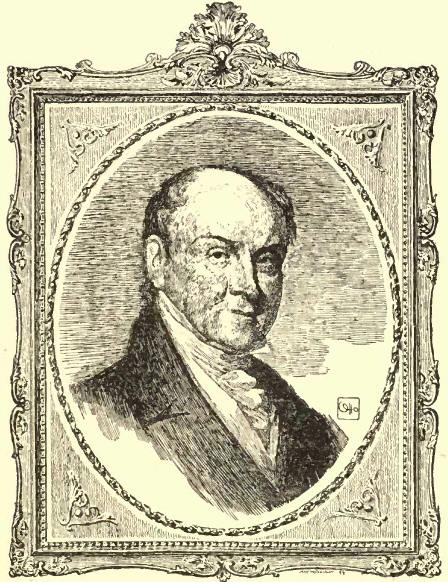
John Quincy Adams. From a picture by Gilbert Stuart.
The Whigs had arranged, to be now passed, a series of minimum rates on
woollens, by which all costing over fifty cents a square yard were to
pay as if costing $2.50, and all over this as if costing $4.00. The rate
was to be forty per cent. the first year, forty-five the second, and
fifty thereafter.
This illustrates the famous "minimum principle," which has played such a
figure in all our tariff history since 1816, its effect being always to
make the tariff much higher than it seems. Thus in the case before us,
most of the woollens then imported cost about ninety cents. If based on
this price, the tariff would be thirty-six per cent., but if based on
$2.50 as the price, it would mount up to one hundred and ten per cent.
To prevent this and to render the bill still more unpalatable to the
Whigs, the Democrats introduced a dollar "minimum," so that the tariff
on the bulk of our imported woollens, costing, as just stated, about
ninety cents, would come in at forty-four and four-tenths per cent.
But as this was after all more vigorous protection than woollens had
before received, amounting, through minima, in some cases to over one
hundred per cent., sixteen out of the thirty-nine New England members,
led by Webster, accepted this universally odious tariff bill--the Tariff
of Abominations, it was called--as the preferable evil, and, aided by a
few Democrats in each house, made it a law. The average duty on
dutiables was now about forty-three and a third per cent.
No one can question that this high tariff worked injustice to the South.
It forced from her an undue share of the national taxes, as well as
extensive tribute to northern manufacturers. But in resenting the evil
she exaggerated it, mistakenly referring all the relative decrease in
her prosperity to tariff legislation, when a great part of it was due
simply to slavery. The South complained that selfishness and political
ambition, not patriotism or reason, determined the dominant policy, and
there was of course some truth in this. Moreover, as New England now
favored it, this policy bade fair to become permanent, and since the
tariff bills did not announce protection as their purpose, the
constitutionality of them could not be gotten before the courts.
[1830]
Nearly all the southern Legislatures consequently denounced the tariff
as unjust and as hostile to our fundamental law. Most of them were,
however, prudent enough to suggest no illegal remedies. Not so with
fiery South Carolina, where a large party, inspired by Calhoun, proposed
a bold nullification of the tariff act, virtually amounting to
secession. At a dinner in this interest at Washington, April 13, 1830,
Calhoun offered the toast: "The Union; next to our liberty the most
dear; only to be preserved by respecting the rights of the States."
[1832]
John C. Calhoun was now, except, perhaps, Clay, the ablest and most
influential politician in all the South. Born in South Carolina in 1782,
of Irish-Presbyterian parentage, though poor and in youth ill-educated
like Clay and Jackson, his energy carried him through Yale College, and
through a course of legal study at Litchfield, Conn., where stood the
only law school then in America. November, 1811, found him a member of
Congress, on fire for war with Britain. Monroe's Secretary of War for
seven years from 1817, he was in 1825 elected Vice-President, and
reelected in 1828. He had meantime turned an ardent free-trader, and
seeing the North's predominance in the Union steadily increasing, had
built up a nullification theory based upon that of the Virginia and
Kentucky resolutions and the Hartford Convention, and upon the history
of the formation of our Constitution. He had worked out to his own
satisfaction the untenable view that each State had the right, not in
the way of revolution but under the Constitution itself--as a contract
between parties that had no superior referee--to veto national laws upon
its own judgment of their unconstitutionality.
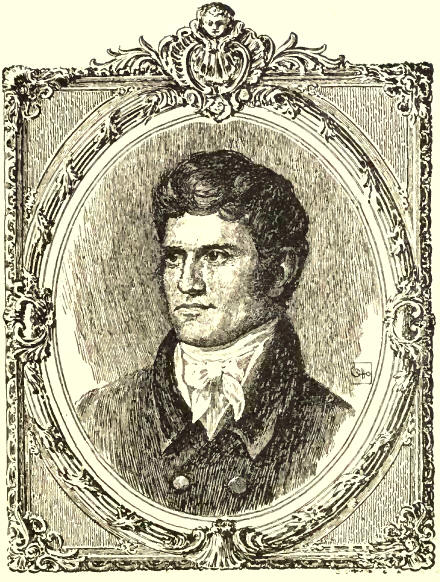
John C. Calhoun
From a picture by King at the Corcoran Art Gallery.
On this doctrine South Carolina presently proceeded to act. November 24,
1832, the convention of that State passed its nullification ordinance,
declaring the tariff acts of 1828 and 1832 "null, void, and no law,"
defying Congress to execute them there, and agreeing, upon the first use
of force for this purpose, to form a separate government.
This was the quintessence of folly even had good theory been behind it.
The tone of the proceeding was too hasty and peremptory. The decided
turn of public opinion and of congressional action in favor of large
reduction in duties was ignored. But the theory appealed to was clearly
wrong, and along with its advocates was sure to be reprobated by the
nation. A precious opportunity effectively to redress the evil
complained of was wantonly thrown away. Worst of all, from a tactical
point of view, South Carolina had miscalculated the spirit of President
Jackson. At the dinner referred to, his toast had been the memorable
words: "Our Federal Union; it must be preserved." Men now saw that Old
Hickory was in earnest. General Scott, with troops and warships, was
ordered to Charleston.
The nullifiers receded, a course made easier by Clay's "compromise
tariff" of 1833, gradually reducing duties for the next ten
years, and
enlarging the free list. From all duties of over twenty per cent. by the
act of 1832, one-tenth of the excess was to be stricken off on September
30, 1835, and another tenth every other year till 1841. Then one-half
the excess remaining was to fall, and in 1842 the rest, so that the end
of the last named year should find no duty over twenty per cent.
This episode, threatening as it was for a time, drew in its train
results the most happy, revealing with unprecedented vividness to most,
both the original nature of the Constitution as not a compact, and also
the might which national sentiment had attained since the War of 1812.
The doctrine of state rights was seen to have gradually lost, over the
greater part of the country, all its old vitality. Nearly every State
Legislature condemned the South Carolina pretensions, Democrats as
hearty in this as Whigs. Jackson's proclamation against them--impressive
and unanswerable--ran thus: "The Constitution of the United States
forms a government, not a league; and whether it be formed by compact
between the States, or in any other manner, its character is the same
. . . . I consider the power to annul a law of the United States
incompatible with the existence of the Union, contradicted expressly by
the letter of the Constitution, and destructive of the great object for
which it was formed. . . . Our Constitution does not contain the
absurdity of giving power to make laws, and another power to resist
them. To say that any State may at pleasure secede from the Union is to
say that the United States are not a nation."
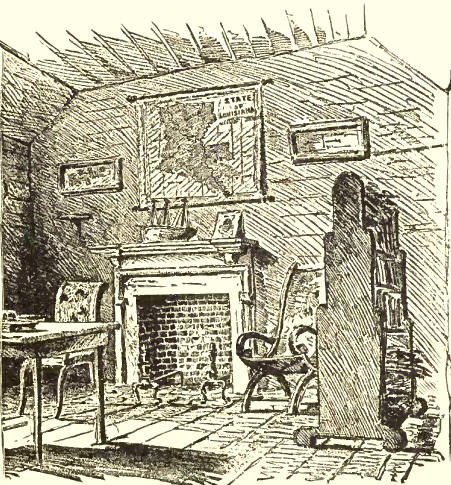
Calhoun's Library and Office.
The congressional debates which the nullification question evoked, among
the ablest in our parliamentary history, held the like high national
tenor. Calhoun's idea, though advocated by him with consummate skill,
was shown to be wholly chimerical. The doughty South Carolinian, from
this moment a waning force in American politics, was supported by Hayne
almost alone, the arguments of both melting into air before Webster's
masterful handling of constitutional history and law. Not questioning
the right of revolution, admitting the general government to be one of
"strictly limited," even of "enumerated, specified, and particularized
powers," the Massachusetts orator made it convincingly apparent that the
Calhoun programme could lead to nothing but anarchy. It was seen that
general and state governments emanate from the people with equal
immediacy, and that the language of the clause, "the Constitution and
the laws of the United States made in pursuance thereof" are "the
supreme law of the land, anything in the constitution or laws of any
State to the contrary notwithstanding," means precisely what it says. To
this language little attention had apparently been paid till this time.
CHAPTER V.
MINOR PUBLIC QUESTIONS OF JACKSON'S "REIGN"
[1828]
Andrew Jackson was born March 15, 1767. His parents had come from
Carrick-fergus, Ireland, two years before. He was without any education
worthy the name. As a boy, he went into the War for Independence, and
was for a time a British prisoner. He studied law in North Carolina,
moved west, and began legal practice at Nashville. He was one of the
framers of the Tennessee constitution in 1796. In 1797 he was a senator
from that State, and subsequently he was a judge on its supreme bench.
His exploits in the Creek War, the War of 1812, and the Seminole War are
already familiar. They had brought him so prominently and favorably
before the country that in 1824 his vote, both popular and electoral,
was larger than that of any other candidate. As we have seen, he himself
and multitudes throughout the country thought him wronged by the
election over him of John Quincy Adams. This contributed largely to his
popularity later, and in 1828 he was elected by a popular vote of
647,231, against 509,097 for Adams. Four years later he was reelected
against Clay by a still larger majority. Nor did his popularity to any
extent wane during his double administration, notwithstanding his many
violent and indiscreet acts as President.
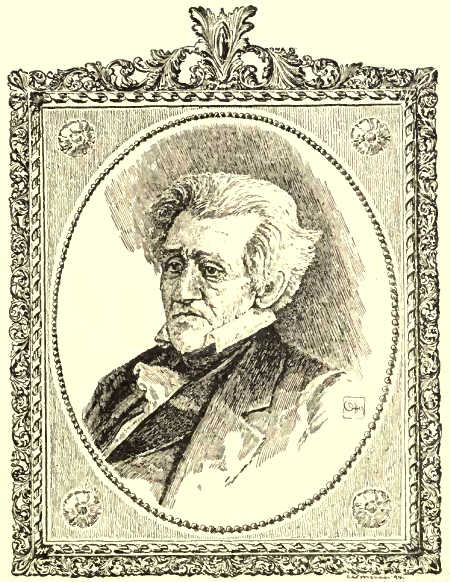
Andrew Jackson. From a photograph by Brady.
Much of Jackson's arbitrariness sprung from a foolish whim of his,
taking his election as equivalent to the enactment of all his peculiar
ideas into law. Ours is a government of the people, he said; the people
had spoken in his election, and had willed so and so. Woe to any senator
or representative who opposed! This was, of course, to mistake entirely
the nature of constitutional government.
After all, Jackson was by no means the ignorant and passionate old man,
controlled in everything by Van Buren, that many people, especially in
New England, have been accustomed to think him. Illiterate he certainly
was, though Adams exaggerated in calling him "a barbarian who could not
write a sentence of grammar and could hardly spell his own name." He was
never popular in the federalist section of the Union. Yet with all his
mistakes and self-will, often inexcusable, he was one of the most
patriotic and clear-headed men who ever administered a government. If he
resorted to unheard-of methods within the law, very careful was he never
to transgress the law.
The most just criticism of Jackson in his time and later related to the
civil service. It was during his administration that the cry, "turn the
rascals out," first arose, and it is well known that, adopting the
policy of New York and Pennsylvania politicians in vogue since 1800, he
made nearly a clean sweep of his political opponents from the offices at
his disposal. This was the more shameful from being so in contrast with
the policy of preceding presidents. Washington removed but two men from
office, one of these a defaulter; Adams ten, one of these also a
defaulter; Jefferson but thirty-nine; Madison five, three of them
defaulters; and Monroe nine. The younger Adams removed but two, both of
them for cause.
[1830]
Yet of Jackson's procedure in this matter it can be said, in partial
excuse, so bitter had been the opposition to him by officeholders as
well as others, that many removals were undoubtedly indispensable in
order to the efficiency of the public service. It is not at all
necessary for the rank and file of the civil service to be of the same
party with the Chief Magistrate, but it is necessary that they should
not be so utterly opposed to him as to feel bound in conscience to be
working for his defeat.
The fine art of party organization, semi-military in form, has come to
us from Jackson and his workers. Before his time, candidates for high
state offices had usually been nominated by legislative caucuses, and
those for national posts by congressional caucuses. State party
conventions had been held in Pennsylvania and New York. Soon after 1830
such a device for national nominations began to be thought of, and the
history of national party conventions may be said to begin with the
campaign of 1832.
[1832]
Jackson's dearest foe while in office was the United States Bank.
Magnifying the dishonesty which had, as everyone knew, disgraced its
management, he attacked it as a monster, an engine of the moneyed
classes for grinding the face of the poor. Like Jefferson, like Madison
at first, he disbelieved in its constitutionality. In his first message
and continually in his official utterances he inveighed against it as a
public danger, using its funds and patronage for party ends. This made
him unpopular with many who had been his friends, so that in the
campaign of 1832 Clay forced the bank question to the front as one on
which Jackson's attitude would greatly advantage the whig cause. He
accepted Clay's challenge with pleasure, and from this moment gave the
bank no quarter. We may call the contest of this year a pitched battle
between Jackson and the bank.
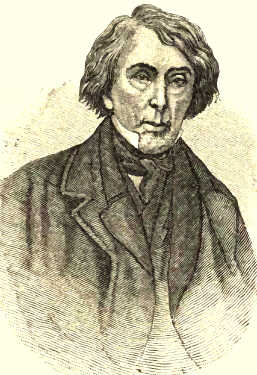
Roger B. Taney.
[1833]
In 1832 he vetoed a bill for a renewal of its charter, which was to
expire in 1836, and in 1833 he proceeded to break it by removing the
United States deposits which it held. Such removal was by law within the
power of the Secretary of the Treasury. Secretary McLane refused to
execute Jackson's will. He was removed and Duane appointed. Then Duane
was removed and Roger B. Taney appointed, who obeyed the President's
behest. The bank was emptied by checking out the public money as wanted,
at the same time depositing no more, the funds being instead placed in
"pet" state banks, as they were called because of the government favor
thus shown them.
The financial distress rightly or wrongly ascribed to this measure
throughout the country, instead of injuring Jackson, probably, on the
whole, made him still more popular, as showing the power of the bank.
When Congress met in 1833, the Senate passed a vote of censure upon him
for what he had done. Rancorous wranglings and debates pervaded Congress
and the whole land. After persistent effort by Jackson's bosom friend,
Senator Benton, of Missouri, this censure-vote was expunged by the
XXIVth Congress, second session, January 16, 1837. This was before
Jackson left office, and he accounted it the greatest triumph of his
public life.
[1830]
Jackson was somehow fortunate in dealing with foreign nations. It was he
who recovered for American ships that British West Indian trade which
had been so long denied. Negotiations were opened with Great Britain,
which, in 1830, had the result of placing American vessels in the
British West Indian ports at an equal advantage with British vessels
sailing thither from the United States--terms which, through the
contiguity of those islands to us, gave us a trade there better than
that of any other nation. This diplomacy brought the administration much
applause.
When Jackson became President, France was still in our debt on account
of her spoliations upon American commerce after the settlement of 1803.
The matter had been in negotiation ever since 1815, but hitherto in
vain. Jackson took it up with zeal, but with his usual apparent
recklessness. A treaty had been concluded in 1831, as a final settlement
between the two countries, binding France to pay twenty-five million
francs and the United States to pay one and one-half million. The first
instalment from France became due February 2, 1833, but was not paid.
Jackson's message to Congress in 1834, not an instalment having yet been
received, contained a distinct threat of war should not payment begin
forthwith. He also bade Edward Livingston, minister at Paris, in the
same contingency to demand his passports and leave Paris for London.
[1835]
Most public men, even those in his cabinet, thought this action
foolhardy and useless; but Quincy Adams, neither expecting nor receiving
any thanks for it, just as in the Seminole War difficulty, nobly stood
up for the President. A telling speech by him in the House led to its
unanimous resolution, March 2, 1835, that the execution of the treaty
should be insisted on. The French ministry blustered, and for a time
diplomatic relations between the two countries were entirely ruptured.
But France, affecting to see in the message of 1835, though voiced in
precisely the same tone as its predecessor, some apology for the menace
contained in that, began its payments. This money, as also all due from
the other states included in Napoleon's continental system, was paid
during Jackson's administration, a result which brought him and his
party great praise, not more for the money than for the respect and
consideration secured to the United States by insistence upon its
rights. The President's message to Congress in 1835 announced the entire
extinguishment of the public debt--the first and the last time this has
occurred in all our national history.
An important measure touching the hard-money system of our country was
passed in large part through the influence of President Jackson. By the
Mint Law of 1792 our silver dollar was made to contain three hundred and
seventy-one and a quarter grains of fine silver, or four hundred and
sixteen of standard silver. The amount of pure silver in this venerable
coin has remained unchanged ever since; only, in 1837, by a reduction of
the alloy fraction to exactly one-tenth, the total weight of the coin
became what it now is, four hundred and twelve and a half grains,
nine-tenths fine. The same law of 1792 had given the gold dollar just
one-fifteenth the weight of the silver dollar. This proportion, which
Hamilton had arrived at after careful investigation characteristic of
the man, was exactly correct at the time, but within a year, as is now
known, on account of increase in the relative value of gold, the gold
dollar at fifteen to one became more valuable than its silver mate. The
consequence was that the gold brought to the United States mint for
coinage fell off year by year, until some of the years between 1820 and
1830 it had been almost zero. Gold money had nearly ceased to circulate.
[1834-1836]
Jackson resolved to restore the yellow metal to daily use. In this he
was opposed by many Whigs, who, so zealous were they for the United
States Bank, had become paper money men. The so-called Gold Bill was
carried through Congress in 1834, changing the proportion of silver to
gold in our currency from fifteen to one to sixteen to one. It should
have been fifteen and a half to one. Now gold in its turn was
over-valued, so that silver gradually ceased to circulate, as gold had
almost ceased before. This result was made worse after 1848, when there
was a still further appreciation of silver through the discovery of gold
in California and Australia. Silver dollars did not again circulate
freely in the country until 1878, though they were full legal tender
till 1873. Gold, on the other hand, was everywhere seen after 1834,
though not abundant in circulation, owing to the large amounts of paper
money then in use.
In 1836 the President ordered his Secretary of the Treasury to put forth
the famous Specie Circular, declaring that only gold, silver, or land
scrip should be received in payment for public lands. The occasion of
this was that while land sales were very rapidly increasing, the
receipts hitherto had consisted largely in the notes of insolvent banks.
Land speculators would organize a bank, procure for it, if they could,
the favor of being a "pet" bank, issue notes, borrow these as
individuals and buy land with them. The notes were deposited, when they
would borrow them again to buy land with, and so on. As there was little
specie in the West, the circular broke up many a fine plan, and evoked
much ill-feeling. Gold was drawn from the East, where, as many of the
banks had none too much, the drain caused not a few of them to collapse.
The condition of business at this time was generally unsound, and this
westward movement of gold was all that was needed to precipitate a
crisis. A crisis accordingly came on soon after, painfully severe. It is
unfair, however, to arraign Jackson's order as wholly responsible for
the evils which accompanied this monetary cataclysm. It was rather an
occasion than the cause.
CHAPTER VI.
THE FIRST WHIG TRIUMPH
[1837]
Partly Jackson's personal influence, partly his able aides, partly
favoring circumstances had, during his administrations, brought the
Democracy into excellent condition, patriotic, national in general
spirit, with a creed that, however imperfect--close construction being
its integrating idea--was, after all, definite, consistent, and
thoughtful. Yet in 1840 the Democrats, who four years before had chosen
Van Buren by an electoral vote of 170 to 73, had to surrender, with the
same Van Buren for candidate, to the Whigs by a majority of 234
electoral votes to 60; only five States, and but two of them northern,
going for the democratic candidate.
There were several causes for this defeat. Jackson had made many enemies
as well as many friends, some of these within his own party, while the
entire opposition to him was indescribably bitter on account of the
personal element entering into the struggle. The commendably national
spirit of the Whig Party told well in its favor. Upon this point its
attitude proved far more in accord with the best sentiment of the nation
than that of the Democracy, sound as the latter was at the core and
nobly as its chief had behaved in the nullification crisis.
More influential still was the financial predicament into which on
Jackson's retirement his successor and the country were plunged. The
commercial distress which seemed to spring from Jackson's measures was
now first fully realized. Anger and pain from the death of the bank had
not abated. Ardent hatred prevailed toward the "pet" banks, extending to
the party whose darlings they were, while the Specie Circular was held
to have ruined most of the others. The subsequent legislation for
distributing the treasury surplus among the States, by removing the
deposits from the pet banks, destroyed many of these as well. They had
been using this government money for the discount of loans to business
men, and were not in condition instantly to pay it back. Hence the panic
of 1837. First the New York City banks suspended, soon followed by the
others throughout that State, all sustained in their course by an act of
the Legislature. Suspension presently occurred everywhere else. The
financial pressure continued through the entire summer of 1837, banks,
corporations, and business men going to the wall, and all values greatly
sinking. Boston suffered one hundred and sixty-eight business failures
in six months.
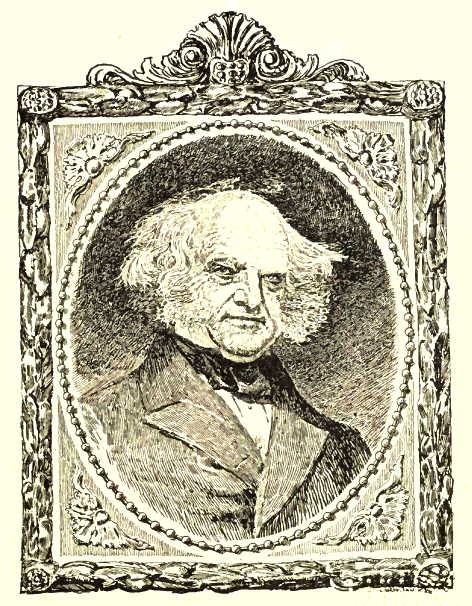
Martin Van Buren.
From a photograph by Brady.
One of Van Buren's earliest acts after assuming office was to call an
extra session of Congress for September 4, 1837, to consider the
financial condition of the country. When it convened, an increase of the
whig vote was apparent, though the Democrats were still in the majority.
On the President's recommendation, agitation now began in favor of the
sub-treasury or independent treasury plan, still in use to-day, of
keeping the government moneys. This had been first broached in 1834-35
by Whigs. The Democrats then opposed it; but now they took it up as a
means of counteracting the whig purpose to revive a national bank.
There was soon less need of any such special arrangement, as the
treasury was swiftly running dry. In June of the preceding year, 1836,
both parties concurring, an act had passed providing that after January
1, 1837, all surplus revenue should be distributed to the States in
proportion to their electoral votes. It was meant to be a loan, to be
recalled, however, only by vote of Congress, but it proved a donation.
Twenty-eight millions were thus paid in all, never to return. Such a
disposition of the revenue had now to be stopped and reverse action
instituted. Importers called for time on their revenue bonds, which had
to be allowed, and this checked income. This special session was needed
to authorize an issue of ten millions in treasury notes to tide the
Government over the crisis.
[1840]
Another influence which now worked powerfully against the Democracy was
hostility to slavery. This campaign--it was the first--saw a "Liberty
Party" in the field, with its own candidates, Birney and Earle. The
abolition sentiment, of which more will be said in a subsequent chapter,
was growing day by day, and little as the Whigs could be called an
antislavery party on the whole, their rank and file were very much more
of that mind than those of the opposition. Jackson had ranted wildly
against the despatch of abolition literature through the mails. The
second Seminole War, 1835-42, was waged mainly in deference to
slave-holders, to recover for them their Florida runaways, and, by
removal of the Seminoles beyond the Mississippi, to break up a popular
resort for escaped negroes. The Indians, under Osceola, whose
wife, as
daughter to a slave-mother, had been treacherously carried back into
bondage, fought like tigers. After their massacre of Major Dade and his
detachment, Generals Gaines, Jesup, Taylor, Armistead, and Worth
successively marched against them, none but the last-named successful in
subduing them. Over 500 persons had been restored to slavery, each one
costing the Government, as was estimated, at least $80,000 and the lives
of three white soldiers.
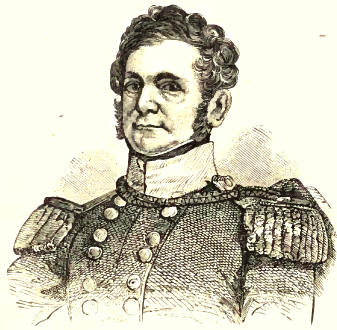
General William J. Worth.
[1839]
Van Buren was to the slavocrats even more obsequious than Jackson. His
spirit was shown, among other things, by the Amistad case, in 1839. The
schooner Amistad was sailing between Havana and Puerto Principe with a
cargo of negroes kidnapped in Africa. Under the lead of a bright negro
named Cinque the captives revolted and killed or confined all the crew
but two, whom they commanded to steer the ship for Africa. Instead,
these directed her to the United States coast, where she was seized off
Long Island by a war vessel and brought into New London. The negroes
were, even by Spanish law, not slaves but free men, as Spain had
prohibited the slave trade. Yet when their case was tried before the
district court, Mr. Van Buren spared no effort to procure their release
to the Spanish claimants. He even had a government vessel all ready to
convey the poor victims back to Cuba. The district court having decided
for the blacks, the government attorney appealed to the circuit court,
thence also to the supreme court. Final judgment happily
re-affirmed
that the men were free. The supreme court trial was the occasion of one
of John Quincy Adams's most splendid forensic victories, he being the
counsel for the negroes.
The attitude of the administration in this affair greatly injured the
party in the North, the more as it but illustrated a spirit and policy
which had grown characteristic of the party's head. In several instances
previous to this time, when ships conveying slaves from one of the
United States to another, entered the ports of the Bahama Islands
through stress of weather, England had, while freeing them, allowed some
compensation. Now, having emancipated the slaves in her own West Indian
possessions, she declined longer to continue that practice. Her first
refusal touched the slaves on the ship Enterprise, which had put in at
Port Hamilton in 1835. Jackson's administration in vain sought
indemnity, Van Buren, then Secretary of State, designating this business
as "the most immediately pressing" before the English embassy.
[1840]
In the same pro-slavery interest an increasing proportion of the
Democracy, though not Van Buren himself, had come to favor the
annexation of Texas. The southwestern boundary of the United States had
ever since the purchase in Florida in 1819 been recognized as the Sabine
River, west of this lying the then foreign country of Texas. France had
claimed the Rio Grande as Louisiana's western bound, but Mr. Monroe, to
placate the North in the Florida annexation, had receded from this
claim. Texas and Coahuila became a state in the new Mexican republic,
which Spain recognized in 1821; but in 1836 Texas declared itself
independent. It was ill-governed and weighed down with debt, and hence
almost immediately, in 1837, asked membership in the American Union. Its
annexation was bitterly opposed all over the North, so bitterly in fact
that the northern Democrats would not have dared, even had they wished,
to favor the scheme. Yet so strong was the southern influence in the
party by 1840 that the democratic platform that year urged the
"re-annexation" of Texas, the term assuming that as a part of Louisiana
it had always been ours since 1803. This was a fact, but it was now
asseverated by the Democracy for a selfish sectional purpose, and the
cry brought thousands of votes to the Whigs.
It proved good politics for the Whigs in 1840 to pass over Clay and
adopt as their candidate William Henry Harrison. He had indeed been
unsuccessful in 1836, owing to the great popularity of Jackson, all
whose influence went for Van Buren; but now that "Little Van," or
"Matty," as Jackson used to call him, stood alone, Harrison had a better
chance. His political record had been inconspicuous but honorable.
Nothing could be alleged against his character. He was a gentleman of
some ability, while his brilliant military record in 1812, now revived
to the minutest detail, gave him immense popularity. Every surviving
Tippecanoe or Thames veteran stumped his vicinity for the old war-horse.
Many wavering Democrats in the South, especially those of the
nullification stripe, were toled to the whig ticket by the nomination of
John Tyler for Vice-President. "Tippecanoe and Tyler too" rang through
the land as the whig watchword for the campaign. During the
electioneering every hamlet was regaled with portrayals of Harrison's
simple farm life at North Bend, where, a log cabin his dwelling, and
hard cider--so one would have supposed--his sole beverage, he had been a
genuine Cincinnatus. "Tippecanoe and Tyler" were therefore elected;
their popular vote numbering 1,275,017, against 1,128,702 polled for Van
Buren.
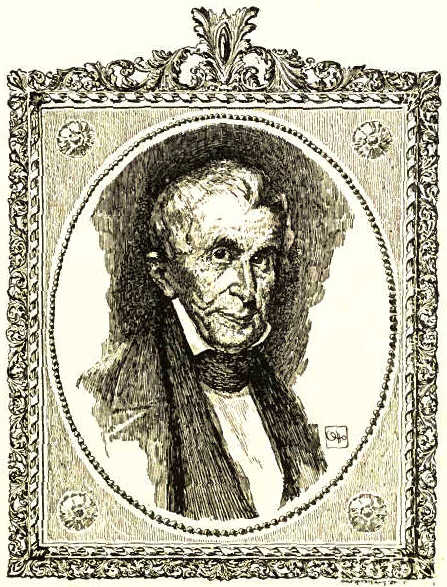
William Henry Harrison
From a Copy at the Corcoran Art Gallery of a painting by Beard in 1840.
However, this whig success, for a moment so imposing, proved superficial
and brief. Harrison died at the end of his first month in office, and
Tyler, coming in, showed that though training under the whig banner, he
had not renounced a single one of his democratic principles. The Whigs
scorned and soon officially repudiated him During the entire four years
that he held office there was constant deadlock between him and the
slight whig majority in Congress, which gave the Democrats main control
in legislation. The panic of 1837 was forgotten, while the hold of the
Democracy upon the country was so firm that its gains in Congress and
its triumphs in the States once more went steadily on.
CHAPTER VII.
LIFE AND MANNERS IN THE FOURTH DECADE
[1835]
By the census of 1830 the United States had a population of 12,866,020,
the increase having been for the preceding ten years about sufficient to
double the inhabitants in thirty years. There were twenty-four States,
Indiana having been taken into the Union in 1816, Mississippi in 1817,
Illinois in 1818, Alabama in 1819, Maine in 1820, and Missouri, the
last, in 1821. Florida, Michigan, and Arkansas were the Territories. The
area, now that Florida had been annexed, was 725,406 square miles.
Comparatively little of the soil of Michigan, Iowa, Minnesota, and
Wisconsin had as yet been occupied, though settlements were making on
most of the larger streams. The southwest had at this time filled up
more rapidly than the northwest. In 1830 the centre of population for
the Union was farther south than it has ever been at any other time.
Except in Louisiana and Missouri, not over thirty thousand inhabitants
were to be found west of the Mississippi. The vast outer ranges of the
Louisiana purchase remained a mysterious wilderness. Indianapolis in
1827 contained twenty-five brick houses, sixty frame, and about eighty
log houses; also a court-house, a jail, and three churches. Chicago was
laid out in 1830. Thither in, 1834 went one mail per week, from Niles,
Mich., on horseback. In 1833 it was incorporated as a town, having 175
houses and 550 inhabitants. That year it began publishing a newspaper
and organized two churches. In 1837 it was a city, with 4,170
inhabitants. The Territory of Iowa had in 1836, 10,500 inhabitants; in
1840, 43,000. At this time Wisconsin had 31,000. So early as 1835 Ohio
had nearly or quite 1,000,000 inhabitants. Sixty-five of its towns had
together 125 newspapers. Between 1830 and 1840 Ohio's population rose
from 900,000 to 1,500,000; Michigan's, from 30,000 to 212,000; and the
whole country's, from 13,000,000 to 17,000,000. Before 1840, eight
steamers connected Chicago with Buffalo.
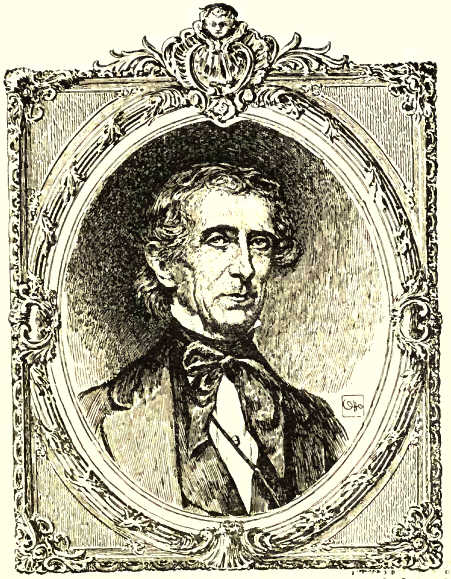
John Tyler
From a photograph by Brady.
By 1840 nearly all the land of the United States this side the
Mississippi had been taken up by settlers. The last districts to be
occupied were Northern Maine, the Adirondack region of New York, a strip
in Western Virginia from the Potomac southward through Kentucky nearly
to the Tennessee line, the Pine Barrens of Georgia, and the extremities
of Michigan and Wisconsin. Beyond the Father of Waters his shores were
mostly occupied, as well as those of his main tributaries, a good way
from their mouths. The Missouri Valley had population as far as Kansas
City. Arkansas, Missouri, and Iowa Territory had many settlements at
some distance from the streams. The aggregate population of the country
was 17,069,453, the average density twenty-one and a tenth to the square
mile. The mass of westward immigration was as yet native, since the
great rush from Europe only began about 1847. This was fortunate, as
fixing forever the American stamp upon the institutions of western
States. To compensate each new commonwealth for the non-taxation of the
United States land it contained, it received one township in each
thirty-six as its own for educational purposes, a provision to which is
due the magnificent school system of Michigan, Wisconsin, Iowa,
Minnesota, and their younger sisters.
Farther east, too, there had, of course, been growth, but it was slower.
In 1827 Hartford had but 6,900 inhabitants; New Haven, 7,100; Newark, N.
J., 6,500, and New Brunswick about the same. The State of New York paid
out, between 1815 and 1825, nearly $90,000 for the destruction of
wolves, showing that its rural population had attained little density.
The entire country had vastly improved in all the elements of
civilization. A national literature had sprung up, crowding out the
reprints of foreign works which had previously ruled the market. Bryant,
Cooper, Dana, Drake, Halleck, and Irving were now re-enforced by writers
like Bancroft, Emerson, Hawthorne, Holmes, Longfellow, Poe, Prescott,
and Whittier. Educational institutions were multiplied and their methods
bettered, The number of newspapers had become enormous. Several
religious journals were established previous to 1830, among them the New
York Observer, which dates from 1820, and the Christian Register, from
1821. Steam printing had been introduced in 1823. The year 1825 saw the
first Sunday paper; it was the New York Sunday Courier. Greeley began
his New York Tribune only in 1841.
Fresh news had begun to be prized, as shown by the competition between
the two great New York sheets, the Journal of Commerce and the Morning
Enquirer, each of which, in 1827, established for this purpose swift
schooner lines and pony expresses. The Journal of Commerce in 1833 put
on a horse express between Philadelphia and New York, with relays of
horses, enabling it to publish congressional news a day earlier than any
of its New York contemporaries. Other papers soon imitated this example,
whereupon the Journal extended its relays to Washington. Mails came to
be more numerous and prompt. More letters were written, and, from 1839,
letters were sent in envelopes. Postage-stamps were not used till 1847.
Most of the principal cities in the country, including Rochester and
Cincinnati, published dailies before 1830. Baltimore and Louisville had
each a public school in 1829. This year witnessed in Boston the
beginning work of the first blind asylum in the country. In Hartford
instruction had already been given to the deaf and dumb since 1817.
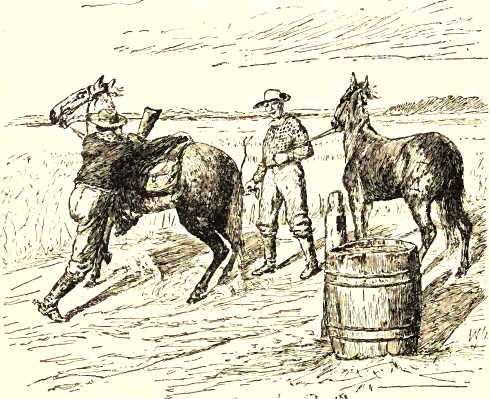
A Pony Express.
By the fourth decade of the century the American character had assumed a
good deal of definiteness and greatly interested foreign travellers.
There was, by those who knew what foreign manners were, much foolish
aping of the same. English visitors noted Brother Jonathan's drawl in
talking, his phlegmatic temperament, keen eye, and blistering
inquisitiveness. Jonathan was a rover and a trader, everywhere at home,
everywhere bent upon the main chance. He ate too rapidly, chewed and
smoked tobacco, and spat indecently. He drank too much. During the first
quarter of the century nearly everyone used liquor, and drunkenness was
shamefully common. Every public entertainment, even if religious, set
out provision of free punch. At hotels, brandy was placed upon the
table, free as water to all. The smaller sects often held preaching
services in bar-rooms for lack of better accommodations. On such
occasions the preacher was not infrequently observed, without affront to
anyone, to refresh himself from behind the bar just before announcing
his text.
In 1824 commenced in Boston a temperance movement which accomplished in
this matter the most happy reform. It swept New England, passing thence
to all the other parts of the Union. By the end of 1829 over a thousand
temperance societies were in existence. The distilling and importation
of spirits fell off immensely. It became fashionable not to drink, and
little by little drinking came to be stigmatized as immoral.
By the time of which we now speak, the old habit of expressing
solicitude for the fate of the Union had passed away. Whig like
Democrat--so different from old Federalist-swore by "the people." Every
American believed in America. Travelling abroad, the man from this
country was wont to assume, and if opposed to contend, ill-manneredly
sometimes, that its institutions were far the best in the world. No one
wished a change. The unparalleled prosperity of all contributed to this
satisfaction. Cities and towns came up in a day. Public improvements
were to be seen making in every direction. There was no idle aristocracy
on the one hand, no beggars on the other. Self-respect was universal.
The people held the power. If men attained great wealth, as not a few
did, they usually did not waste it but invested it. Business enterprise
was intense and common. Character entered into credit as an element
along with financial resources. People did not crowd into cities, but
loved and built up the country rather. Laws and penalties were become
more mild. In 1837 a man was flogged at the whipping-post in Providence,
R. I., for horse-stealing, perhaps the last case of the kind in the
country. Prisons were now made clean and healthy, and the idea of
reforming the criminal instead of taking vengeance upon him was
spreading. Reformatories for children had been opened in New York,
Boston, and Philadelphia. There were institutions for homeless children,
for the sick poor, for the insane, and for other unfortunate classes.
By this time the Methodists and Baptists had become extremely strong in
numbers. In 1833 the Massachusetts constitution was altered, abolishing
obligatory contributions for the support of the ministry of the standing
order. Connecticut had made the same change fifteen years before, in its
constitution of 1818. In many localities the newer denominations,
hitherto sects, were more influential than the old one, and in this
abolition of ecclesiastical taxes they had with them Jews, atheists,
deists, agnostics, and heathen.
About 1825 began a period of peculiar religious enthusiasm. Missions to
the heathen were instituted. Revivals were numerous and often shook
whole neighborhoods for weeks and months. About this date Millerism
began to make converts. William Miller, from whom it took its name,
preached far and wide that the world would be destroyed in 1843,
securing multitudes of disciples, who clung to his general belief even
after his prophecy as to the specific date for the final catastrophe was
seen to have failed. Mormonism was also founded, in 1830, and the Book
of Mormon published by Joseph Smith. A church of this order, organized
this year at Manchester, N. Y., removed the next to Kirtland, O., and
thence to Independence, Mo. Driven from here by mob violence, they built
the town of Nauvoo, Ill. Meeting in this place too with what they
regarded persecution, several of their members being prosecuted for
polygamy, they were obliged to migrate to Salt Lake City, where,
however, they were not fully settled until 1848.
As part of the same general stir we may perhaps register the
anti-masonic movement. One William Morgan, a Mason residing in Western
New York, was reported about to expose in a publication the secrets of
that order. The Masons were desirous of preventing this and made several
forcible efforts to that end. Morgan was soon missing, and the exciting
assumption was almost universally made that the Masons had taken him
off. There was much evidence of this; but conviction was found
impossible because, as was alleged, judges, juries, and witnesses were
nearly all Masons. An intense and widespread feeling was developed that
Masonry held itself superior to the laws, was therefore a foe to the
Government and must be destroyed. The Anti-Masons became a mighty
political party. Masons were driven from office. In 1832 anti-masonic
nominations were made for President and Vice-President, which had much
to do with the small vote of Clay in that year. It was this party that
brought to the front politically William H. Seward, Millard Fillmore,
and Thurlow Weed.
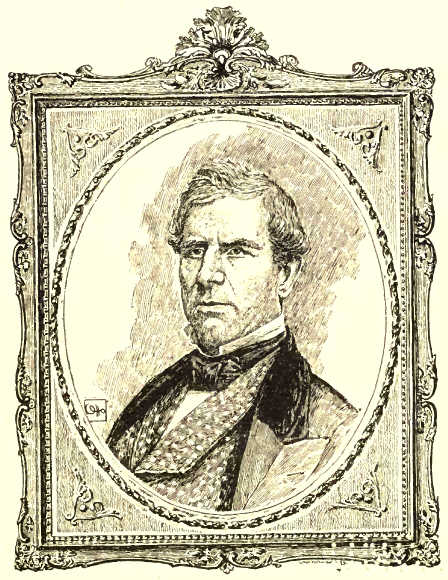
Thurlow Weed. From an unpublished Photograph by Disderi, Paris, in 1861.
In the possession of Thurlow Weed Barnes.
In 1833 Massachusetts, New York, and Pennsylvania passed laws
suppressing lotteries, but the gambling mania seemed to transform itself
into a craze for banks. In many parts this was such that actual riots
took place when subscriptions to the stock of banks were opened, the
earliest comers subscribing the whole with the purpose of selling to
others at an advance. To make a bank was thought the great panacea for
every ill that could befall. In this we see that the American people,
bright as they were, could be duped.
Less wonder, then, at the success of the Moon Hoax, perpetrated in 1835.
It was generally known that Sir John Herschel had gone to the Cape of
Good Hope to erect an observatory. One day the New York Sun came out
with what purported to be part of a supplement to the Edinburgh Journal
of Science, giving an account of Herschel's remarkable discoveries. The
moon, so the bogus relation ran, had been found to be inhabited by human
beings with wings. Herschel had seen flocks of them flying about. Their
houses were triangular in form. The telescope had also revealed beavers
in the moon, exhibiting most remarkable intelligence. Pictures of some
of these and of moon scenery accompanied the article. The fraud was so
clever as to deceive learned and unlearned alike. The sham story was
continued through several issues of the Sun, and gave the paper an
enormous sale. As it arrived in the different places, crowds scrambled
for it, nor would those who failed to secure copies disperse until some
one more fortunate had read to them all that the paper said upon the
subject. Several colleges sent professorial deputations to the Sun
office to see the article, and particularly the appendices, which, it
was alleged, had been kept back. Richard Adams Locke was the author of
this ingenious deception, which was not exploded until the arrival of
authentic intelligence from Edinburgh.
Party spirit sometimes ran terribly high. A New York City election in
1834 was the occasion of a riot between men of the two parties,
disturbances continuing several days. Political meetings were broken up,
and the militia had to be called out to enforce order. Citizens armed
themselves, fearing attacks upon banks and business houses. When it was
found that the Whigs were triumphant in the city, deafening salutes were
fired. Philadelphia Whigs celebrated this victory with a grand barbecue,
attended, it was estimated, by fifty thousand people. The death of
Harrison was malignantly ascribed to overeating in Washington, after his
long experience with insufficient diet in the West. Whigs exulted over
Jackson's cabinet difficulties. Jackson's "Kitchen Cabinet," the power
behind the throne, gave umbrage to his official advisers. Duff Green,
editor of the United States Telegraph, the President's "organ," was one
member; Isaac Hill, of New Hampshire, and Amos Kendall, first of
Massachusetts, then of Kentucky, were others, these three the most
influential. All had long worked, written, and cheered for Old Hickory.
In return he gave them good places at Washington, and now they enjoyed
dropping in at the White House to take a smoke with the grizzly hero and
help him curse the opposition as foes of "the people."
Major Eaton, Old Hickory's first Secretary of War, had married a
beautiful widow, maiden name Peggy O'Neil, of common birth, and much
gossipped about. The female members of other cabinet families refused to
associate with her, the Vice-President's wife leading. Jackson took up
Mrs. Eaton's cause with all knightly zeal. He berated her traducers and
persecutors in long and fierce personal letters. His niece and
housekeeper, Mrs. Donelson, one of the anti-Eatonites, he turned out of
the White House, with her husband, his private secretary. The breach was
serious anyway, and might have been far more so but for the healing
offices of Van Buren, who used all his courtliness and power of place to
help the President bring about the social recognition of Mrs. Eaton. He
called upon her, made parties in her honor, and secured her entree to
the families of the greatest foreign ministers. Mrs. Eaton triumphed,
but the scandal would not down.
When Jackson wrote his foreign message upon the French spoliation
claims, his cabinet were aghast and begged him to soften its tone. Upon
his refusal, it is said, they stole to the printing-office and did it
themselves. But the proofs came back for Jackson's perusal. The lad who
brought them was the late Mr. J. S. Ham, of Providence, R. I. He used to
say that he had never known what profane swearing was till he listened
to General Jackson's comments as those proofs were read.
Jackson and Quincy Adams were personal as well as political foes. When
the President visited Boston, Harvard College bestowed on him the degree
of Doctor of Laws. Adams, one of the overseers, opposed this with all
his might. As "an affectionate child of our Alma Mater, he would not be
present to witness her disgrace in conferring her highest literary
honors upon a barbarian." Subsequently he would refer, with a sneer, to
"Dr. Andrew Jackson." The President's illness at Boston Adams declared
"four-fifths trickery" and the rest mere fatigue. He was like John
Randolph, said Adams, who for forty years was always dying. "He is now
alternately giving out his chronic diarrhoea and making Warren bleed him
for a pleurisy, and posting to Cambridge for a doctorate of laws,
mounting the monument of Bunker's Hill to hear a fulsome address and
receive two cannon-balls from Edward Everett."
To be sure, manifestations of a contrary spirit between the political
parties were not wanting. The entire nation mourned for Madison after
his death in 1836, as it had on the decease of Jefferson and John Adams
both on the same day, July 4, 1826.
A note or two upon costume may not uninterestingly close this chapter.
Enormous bonnets were fashionable about 1830. Ladies also wore Leghorn
hats, with very broad brims rolled up behind, tricked out profusely with
ribbons and artificial flowers. Dress-waists were short and high. Skirts
were short, too, hardly reaching the ankles. Sleeves were of the
leg-of-mutton fashion, very full above the elbows but tightening toward
the wrist. Gentlemen still dressed for the street not so differently
from the revolutionary style. Walking-coats were of broadcloth, blue,
brown, or green, to suit the taste, with gilt buttons. Bottle-green was
a very stylish color for evening coats. Blue and the gilt buttons for
street wear were, however, beginning to be discarded, Daniel Webster
being one of the last to walk abroad in them. The buff waistcoat, white
cambric cravat, and ruffled shirt still held their own. Collars for full
dress were worn high, covering half the cheek, a fashion which persisted
in parts of the country till 1850 or later.
CHAPTER VIII.
INDUSTRIAL ADVANCE BY 1840
[1840]
During the War of 1812 we had in England an industrial spy, whose
campaign there has perhaps accomplished more for the country than all
our armies did. It was Francis C. Lowell, of Boston. Great Britain was
just introducing the power loom. The secret of structure was guarded
with all vigilance, yet Lowell, passing from cotton factory to cotton
factory with Yankee eyes, ears, and wit, came home in 1814, believing,
with good reason, as it proved, that he could set up one of the machines
on American soil. Broad Street in Boston was the scene of his initial
experiments, but the factory to the building of which they led was at
Waltham. It was owned by a company, one of whose members was Nathan
Appleton. Water furnished the motive power. By the autumn of 1814 Lowell
had perfected his looms and placed them in the factory. Spinning
machinery was also built, mounting seventeen hundred spindles. English
cotton-workers did not as yet spin and weave under the same roof, so
that the Lowell Mill at Waltham may, with great probability, be
pronounced the first in the world to carry cloth manufacture
harmoniously through all its several successive steps from the raw stuff
to the finished ware.
From this earliest establishment of the power-loom here, the
cotton-cloth business strode rapidly forward. Fall River, Holyoke,
Lawrence, Lowell, and scores of other thriving towns sprung into being.
Every year new mills were built. In 1831 there were 801; in 1840, 1,240;
in 1850, 1,074. Henceforth, through consolidation, the number of
factories decreased, but the number of spindles grew steadily larger.
This rise of great manufacturing concerns was facilitated by a new order
of corporation laws. There had been corporations in the country before
1830, as the Waltham case shows; but the system had had little
evolution, as incorporation had in each case to proceed from a special
legislative act. In 1837 Connecticut passed a statute making this
unnecessary and enabling a group of persons to become a corporation on
complying with certain simple requirements. New York placed a similar
provision in its constitution of 1846. The Dartmouth College decision of
the United States Supreme Court in 1819, interpreting an act of
incorporation as a contract, which, by the Constitution, no State can
violate, still further humored and aided the corporation system.
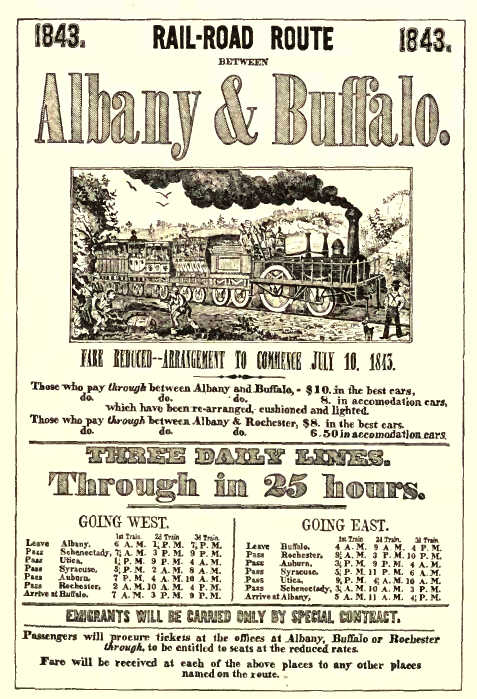
From an Old Time-table. (Furnished by the ABC Pathfinder Railway Guide.)
In 1816 the streets of Baltimore were lighted with gas. A gas-light
company was incorporated in New York in 1823. Not till 1836, however,
did the Philadelphia streets have gas lights. The first savings-banks
were established in Philadelphia and Boston in 1816. Baltimore had one
two years later. Portable fire-proof safes were used in 1820. The Lehigh
coal trade flourished this year, and also the manufacture of iron with
coal. The whale fishery, too, was now beginning. The first factory in
Lowell started in 1821. In 1822 there was a copper rolling mill in
Baltimore, the only one then in America, and Paterson, N. J., began the
manufacture of cotton duck. Patent leather was made in the United States
by 1819. In 1824 Amesbury, Mass., had a water-power manufactory of
flannel. The next year the practice of homoeopathy began in America, and
matches of a rude sort were displacing the old tinder-box. The next
year after this Hartford produced axes and other edged tools.
Lithography, of which there had been specimens so early as 1818, was a
Boston business in 1827. Pittsburgh manufactured damask table linen in
1828. The same year saw paper made from straw, and planing machinery in
operation. The insuring of lives began in this country in 1812.

Trial between Peter Cooper's Locomotive "Tom Thumb" and one of
Stockton's
and Stokes' Horse Cars. From "History of the First Locomotive in
America."
The first figured muslin woven by the power-loom in America, and perhaps
in the world, was produced at Central Falls, R. I., in 1829. Calico
printing began at Lowell the same year, also the manufacture of cutlery
at Worcester, of sewing-silk at Mansfield, Conn., of galvanized iron in
New York City. With the new decade chloroform was invented, in 1831,
being first used as a medicine, not as an anaesthetic. Reaping machines
were on trial the same year, and three years later machine-made wood
screws were turned out at Providence. About the same time, 1832, pins
were made by machinery, hosiery was woven by a power-loom process, and
Colt perfected his revolver. In 1837 brass clocks were put upon the
American market, and by 1840 extensively exported. Also in 1837 Nashua
was making machinists' tools. By 1839 the manufacture of iron with hard
coal was a pronounced success. In 1840 daguerreotypes began to appear.
Steam fire-engines were seen the next year.
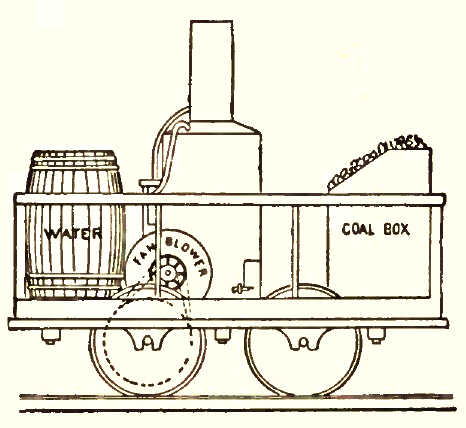
Peter Cooper's Locomotive, 1829.
So early as 1816 the New York and Philadelphia stages made the distance
from city to city between sun and sun. The National Road from Cumberland
was finished to Wheeling in 1820, having been fourteen years in
construction and costing $17,000,000. It was subsequently extended
westward across Ohio and Indiana. It was thirty-five feet wide,
thoroughly macadamized, and had no grade of above five degrees. Over
parts of this road no less than 150 six-horse teams passed daily,
besides four or five four-horse mail and passenger coaches. In Jackson's
time, when for some months there was talk of war with France and extra
measures were thought proper for assuring the loyalty of Louisiana,
swift mail connections were made with the Mississippi by the National
Road. Its entire length was laid out into sections of sixty-three miles
apiece, each with three boys and nine horses, only six hours and
eighteen minutes being allowed for traversing a section, viz., a rate of
about ten miles an hour. Great men and even presidents travelled by the
public coaches of this road, though many of them used their own
carriages. James K. Polk often made the journey from Nashville to
Washington in his private carriage. Keeping down the Cumberland River to
the Ohio, and up this to Wheeling, he would strike into the National
Road eastward to Cumberland, Md. He came thus so late as 1845, to be
inaugurated as President; only at this time he used the new railway from
Cumberland to the Relay House, where he changed to the other new railway
which had already joined Baltimore with Washington.
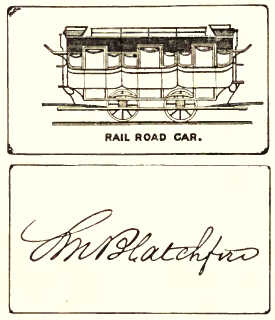
Obverse and Reverse of a Ticket used in 1838 on the New York &
Harlem
Railroad.
The first omnibus made its appearance in New York in 1830, the name
itself originating from the word painted upon this vehicle. The first
street railway was laid two years later. The era of the stage coach was
at this time beginning to end, that of canals and railroads opening. Yet
in the remoter sections of the country the old coach was destined to
hold its place for decades still. Where roads were fair it would not
uncommonly make one hundred miles between early morning and late
evening, as between Boston and Springfield, Springfield and Albany. So
soon as available the canal packet was a much more easy and elegant
means of travel. The Erie Canal was begun in 1817, finished to Rochester
in 1823, the first boat arriving October 8th. The year 1825 carried it
to Buffalo. The Blackstone Canal, between Worcester and Providence, was
opened its whole length in 1828; the next year many others, as the
Chesapeake and Delaware, the Cumberland and Oxford in Maine, the
Farmington in Connecticut, the Oswego, connecting the Erie Canal with
Lake Ontario, also the Delaware and Hudson, one hundred and eight miles
long, from Honesdale, Pa., to Hudson River. The Welland Canal was
completed in 1830.
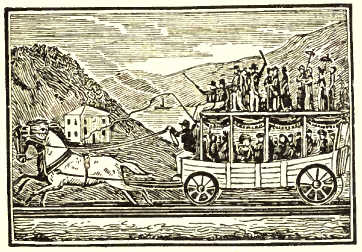
Baltimore & Ohio Railroad, 1830.
Salt-water transportation had meantime been much facilitated by the use
of steam. It had been thought a great achievement when, in 1817, the
Black Ball line of packet ships between New York and Liverpool was
regularly established, consisting of four vessels of from four hundred
to five hundred tons apiece. But two years later a steamship crossed the
Atlantic to Liverpool from Savannah. It took her twenty-five
days--longer than the time in which the distance often used to be
accomplished under sail. In 1822 there was a regular steamboat between
Norfolk and New York, though no steamboat was owned in Boston till 1828.
The Atlantic was first crossed exclusively by steam-power in 1838, and
the first successful propeller used in 1839. The last-named year also
witnessed the beginning of a permanent express line between Boston and
New York, by the Stonington route. The next year, the Adams Express
Company was founded, doing its first business between these two cities
over the Springfield route, in competition with that by the Stonington.
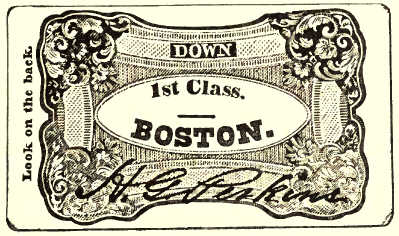
Old Boston & Worcester Railway Ticket (about 1837).
But all these improvements were soon to be overshadowed by the work of
the railway and locomotive. The first road of rails in America was in
the Lehigh coal district of Pennsylvania. Its date is uncertain, but not
later than 1825. In 1826, October 7th, the second began operation, at
Quincy, Mass., transporting granite from the quarries to tide-water,
about three miles. This experiment attracted great attention, showing
how much heavier loads could be transported over rails than upon common
roads, and with how much greater ease and less expense ordinary weights
could be carried. The same had been demonstrated in England before.
Locomotives were not yet used in either country, but only horse-power.
The conviction spread rapidly that not only highway transportation but
even that by canals would soon be, for all large burdens, either quite
superseded or of secondary importance. In 1827 the Maryland Legislature
chartered a railroad from Baltimore to Wheeling. The projectors, though
regarding it a bold act, promised an average rate between the two cities
of at least four miles per hour. Subscriptions were offered for more
than twice the amount of the stock. The Massachusetts Legislature the
same year appointed commissioners to look out a railway route between
Boston and Hudson River. Also in this year a railway was completed at
Mauch Chunk, Pa., for transporting coal to the landing on the Lehigh.
The descent was by gravity, mules being used to haul back the cars.
In most country parts, the new railway projects encountered great
hostility. Engineers were not infrequently clubbed from the fields as
they sought to survey. Learned articles appeared in the papers arguing
against the need of railways and exhibiting the perils attending them.
When steam came to be used, these scruples were re-enforced by the
alleged danger that the new system of travel would do away with the
market for oats and for horses, and that stage-drivers would seek wages
in vain.
The first trip by a locomotive was in 1828, over the Carbondale and
Honesdale route in Pennsylvania. The engine was of English make, and run
by Mr. Horatio Allen, who had had it built. This was a year before the
first steam railroad was opened in England. July 4, 1828, construction
upon the Baltimore & Ohio Railroad was begun. It, like the other
early
roads, was built of stone cross-ties, with wooden rails topped with
heavy straps of iron. Such ties were soon replaced by wooden ones, as
less likely to be split by frost, but the wooden rail with its iron
strap might be seen on branch lines, for instance, between Monocacy
Bridge and Frederick City, Md., so late as the Civil War.
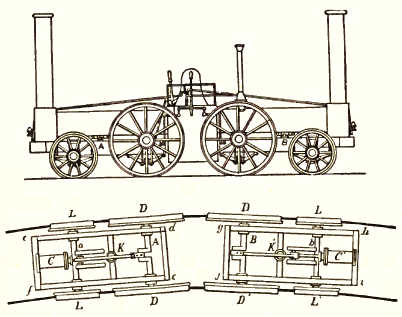
The "South Carolina," 1831, and plan of its running gear.
The first railroad for passengers in this country went into operation
between Charleston and Hamburg, S. C., in 1830. The locomotive had been
gotten up in New York, the first of American make. It had four wheels
and an upright boiler. This year the railroad between Albany and
Schenectady was begun, and fourteen miles of the Baltimore & Ohio
opened
for use. In 1831 Philadelphia was joined to Pittsburgh by a line of
communication consisting of a railway to Columbia, a canal thence to
Hollidaysburg, another railway thence over the Alleghanies to Johnstown,
and then on by canal. The railway over the mountains consisted of
inclined planes mounted by the use of stationary engines. It is
interesting to notice the view which universally prevailed at first,
that the locomotive could not climb grades, and that where this was
necessary stationary engines would have to be used. Not till 1836 was it
demonstrated that locomotives could climb. Up to the same date, also,
locomotives had burned wood, but this was now found inferior to coal,
and began to be given up except where it was much the cheaper fuel.
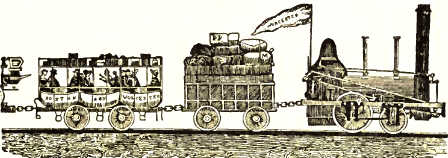
Boston & Worcester Railroad, 1835.
From 1832 the railway system grew marvellously. The year 1833 saw
completed the South Carolina Railroad between Charleston and the
Savannah River, one hundred and thirty-six miles. This was the first
railway line in this country to carry the mails, and the longest
continuous one then in the world. Two years later Boston was connected
by railway with Providence, with Lowell, and with Worcester, Baltimore
with Washington, and the New York & Erie commenced. In 1839
Worcester
was joined to Springfield in the same manner, and in 1841 a passenger
could travel by rail from Boston to Rochester, changing cars, however,
at least ten times.
PERIOD III.
THE YEARS OF SLAVERY CONTROVERSY 1840-1860
CHAPTER I.
SLAVERY AFTER THE MISSOURI COMPROMISE
[1820]
Slavery would most likely never have imperilled the life of this nation
had it not been for the colossal industrial revolution sketched above.
Cotton had been grown here since, 1621, and some exportation of it is
said to have occurred in 1747. Till nearly 1800 very little had gone
from the United States to England, for by the old process a slave could
clean but five or six pounds a day. In 1784, an American ship which
brought eight bags to Liverpool was seized, on the ground that so much
could not have been the produce of the United States. Jay's treaty, as
first drawn, consented that no cotton should be exported from America.
It changed the very history of the country when, in 1793, Eli Whitney
invented the saw-gin, by which a slave could clean 1,000 pounds of
cotton per day. Slavery at once ceased to be a passive, innocuous
institution, promising soon to die out, and became a means of gain, to
be upheld and extended in all possible ways. The cotton export, but
189,316 pounds in 1791, and a third less in 1792, rose to 487,600 pounds
in 1793, to 1,610,760 pounds in 1794, to 6,276,300 pounds in 1795, and
to 38,118,041 pounds in 1804. Within five years after Whitney's
invention, cotton displaced indigo as the great southern staple, and the
slave States had become the cotton-field of the world. In 1869 the
export was nearly 1,400,000,000 pounds, worth about $161,500,000.
[Footnote: Johnson, in Lalor's Cyclopaedia, Art. "Slavery."]
So profitable was slavery to vast numbers of individuals because of this
its new status, that men would not notice how, after all, it militated
against the nation's supreme interests. It polluted social relations in
obvious ways, setting at naught among slaves family ties and the behests
of virtue, influences that reacted terribly upon the whites. The entire
government of slaves had a brutalizing tendency, more pronounced as time
passed. "Plantation manners" were cultivated, which, displaying
themselves in Congress and elsewhere, in all discussions and measures
relating to the execrable institution, made the North believe that the
South was drifting toward barbarism. This was an exaggeration, yet
everyone knew that schools in the South were rare and poor, and thought
and speech little free as compared with the same in the North. Political
power, like the slaves, was in the hands of a few great barons, totally
merciless toward even southerners who differed from them. It is of
course
not meant that virtue, kindliness, intelligence, and fair-mindedness
were ever wanting in that section, but they flourished in spite of the
slave-system.
Economically slavery was an equal evil, taking as was the superficial
evidence to the contrary. No cruelty could make the slave work like a
free man, while his power to consume was enormous. Infants, aged, and
weak had to be supported by the owner. Even the best slaves were
improvident. Everywhere slave labor tended to banish free. Upon slave
soil scarcely an immigrant could be led to set foot. Poor whites grew
steadily poorer, their lot often more wretched than that of slaves.
Invention, care, forethought were as good as unknown among them. Slave
labor proved incompetent even for agriculture, impoverishing the richest
soil in comparatively few years, whence the perpetual impulse of the
slave-owners to acquire new territory. The dishonesty of blacks and the
danger of slave insurrections made property insecure, at the same time
that the system diminished in every community the number of its natural
defenders. The result was that the South, the superior of the North in
natural resources, was, by 1800, rapidly becoming the inferior in every
single element of prosperity.
[1831]
One of these insurrections was the event of 1831 in Virginia,
originating near the southern border. Four slaves in alliance with three
whites commenced it by killing several families and pressing all the
slaves they could find into their service, until the force was nearly
two hundred. They spread desolation everywhere. Fifty-five white persons
were murdered before the insurrection was in hand. Virginia and North
Carolina called out troops, and at last all the insurgents were captured
or killed. The leader was a black named Nat Turner, who believed himself
called of God to give his people freedom. He had heard voices in the air
and seen signs on the sky, which, with many other portents, he
interpreted as proofs of his divine commission. When all was over Turner
escaped to the woods, dug a hole under some fence-rails and lived there
for six weeks, coming out only at midnight for food. Driven thence by
discovery, he still managed to hide here and there about the plantations
in spite of a whole country of armed men in search of him, until at last
he was accidentally confronted in the bush by a white man with levelled
rifle. He was hanged, November 11th, and sixteen others later. His wife
was tortured for evidence, but in vain. Twelve negroes were transported.
Very many were, without trial, punished in inhuman ways, the heads of
some impaled along the highway as a warning. Partly in consequence of
this horrible affair, originated a stout movement for the abolition of
slavery in Virginia. This was favored by many of the ablest men in the
Old Dominion, but they were overruled.
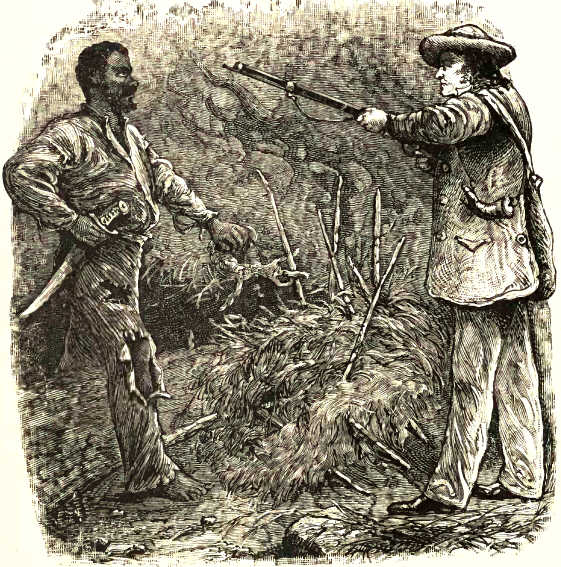
The Discovery of Nat Turner.
Danger from the blacks necessitated the most rigid laws concerning them.
Time had been when it was thought not dangerous to teach slaves to read.
In 1742 Commissary Garden, of the English Society for Propagating the
Gospel, founded a negro school in Charleston, where slaves were taught
by slave teachers, these last being the society's property. Honest Elias
Neale, the society's catechist in New York, engaged in the same work
there, and afterward catechists were so employed in Philadelphia. That
organization did much to stir up the planters to teach their slaves the
rudiments of Christianity. [Footnote: Eggleston in Century, May, 1888.]
Now, all this was changed. The strictest laws were made to keep every
slave in the most abject ignorance, to prevent their congregating, and
to make it impossible for abolitionists or abolitionist literature or
influence to get at them.
[1816]
Inconvenient and perilous as slavery was, southern devotion to it for
many reasons strengthened rather than weakened. The masses did not
perceive the ruin the system was working, which, moreover, consisted
with great profits to vast numbers of influential men and to many
localities. Border States little by little gave up the hope of becoming
free, the old anti-slavery convictions of their best men faltering, and
the practical problem of emancipation, really difficult, being too
easily decided insoluble. More significant, owing to a variety of
circumstances, the abolition spirit itself greatly subsided early in the
present century. Completion of the emancipation process in the North was
assured by the action of New York in 1817, proclaiming a total end to
slavery there from July 4, 1827. The view that each State was absolute
sovereign over slavery within its own borders, responsibility for it and
its abuses there ending with the State's own citizens, was now
universally accepted. Success in securing the act of 1807, making the
slave trade illegal from January 1, 1808, and affixing to it heavy
penalties, lulled multitudes to sleep. This act, however, had effect
only gradually, and its beneficence was greatly lessened in that it left
confiscated negroes to the operation of the local law.
Such quietude was furthered through the formation of the American
Colonization Society in 1816, by easy philanthropists and statesmen,
North as well as South, who swore by the Constitution as admitting no
fundamental amendment, admired its three great compromises, loved all
brethren of the Union except agitators, and deprecated slavery and the
black race about equally; its mission negro deportation, but its actual
efforts confined to the dumping of free blacks, reprobates, and
castaways in some remote corner of the universe, for the convenience of
slave-holders themselves. [Footnote: 3 Schouler's United States, 198.]
[1839]
Meantime much was occurring to harden northern hostility to slavery into
resolute hatred, a fire which might smoulder long but could not die out.
The fugitive slave law for the rendition of runaways found in free
States operated cruelly at best, and was continually abused to kidnap
free blacks. The owner or his attorney or agent could seize a slave
anywhere on the soil of freedom, bring him before the magistrate of the
county, city, or town corporate in which the arrest was made, and prove
his ownership by testimony or by affidavit; and the certificate of such
magistrate that this had been done was a sufficient warrant for the
return of the poor wretch into bondage. Obstruction, rescue, or aid
toward escape was fined in the sum of five hundred dollars. This is the
pith of the fugitive slave act of 1793. It might have been far more
mischievous but for the interpretation put upon it in the celebrated
case of Prigg versus Pennsylvania.
Mr. Prigg was the agent of a Maryland slave-owner. He had in 1839
pursued a slave woman into Pennsylvania, and when refused her surrender
by the local magistrate carried her away by force. He was indicted in
Pennsylvania for kidnapping, an amicable lawsuit made up, and an appeal
taken to the United States Supreme Court. Here, in an opinion prepared
by Justice Story, the Pennsylvania statute under which the magistrate
had acted, providing a mode for the return of fugitives by state
authorities, was declared unconstitutional on the ground that only
Congress could legislate on the subject; but it was added that while a
free State had no right in any way to block the capture of a runaway, as
for example by ordering a jury trial to determine whether a seized
person had really been a slave, so as to protect free persons of dark
complexion, yet States might forbid their officers to aid in the
recovery of slaves. As the act of 1793 did not name any United States
officials for this service it became nearly inoperative. Spite of this
terrible construction of the Constitution, which Chief Justice Taney
thought should have included an assertion of a State's duty by
legislation to aid rendition, many northern States passed personal
liberty laws, besetting the capture of slaves with all possible
difficulties thought compatible with the Constitution. The South
denounced all such laws whatever as unconstitutional, and perhaps some
of them were.
[1835]
Constitutional or not, they were needed. There were regular expeditions
to carry off free colored persons from the coasts of New York and New
Jersey, many of them successful. The foreign slave-trade, with its
ineffable atrocities, proved defiant of law and preternaturally
tenacious of life. A lucrative but barbarous domestic trade had sprung
up between the Atlantic States, Virginia and North Carolina especially,
and those on the Gulf, for the supply of the southern market. Families
were torn apart, gangs of the poor creatures driven thousands of miles
in shackles or carried coastwise in the over-filled holds of vessels, to
live or die--little matter which--under unknown skies and strange,
heartless masters.
The slave codes of the southern States grew severer every year, as did
legislation against free colored people. Laws were passed rendering
emancipation more difficult and less a blessing when obtained. The
Mississippi and Alabama constitutions, 1817 and 1819 respectively, and
all those in the South arising later, were shaped so as to place general
emancipation beyond the power even of Legislatures. Congress was even
thus early--so it seemed at the North--all too subservient to the
slave-holders, partly through the operation of the three-fifths rule,
partly from fear that opposition would bring disunion, partly in that
ambitious legislators were eager for southern votes. As to the Senate,
the South had taken care, Vermont, Kentucky and Tennessee having evened
the score, all before 1800, to allow no new northern State to be
admitted unless matched by a southern. In addition to all this, the
North had a vast trade with the South, and northern capitalists held to
an enormous amount mortgages on southern property of all sorts, so that
large and influential classes North had a pecuniary interest in
maintaining at the South both good nature and business prosperity.
CHAPTER II.
"IMMEDIATE ABOLITION"
[1832]
While slavery was thus strengthening itself upon its own soil and in
some respects also at the North, its champions ever more alert and
forward, its old foes asleep, these very facts were provoking thought
about the institution and hostility to it, destined in time to work its
overthrow. Interested people saw that slavery, so aggressive and
defiant, must be fought to be put down, and that if the Constitution was
its bulwark, as all believed, provided a tithe of what the South as well
as the North had said of its evils was true, the whole country, and not
the South only, was guilty in tolerating the curse. In 1821 Lundy began
publishing his Genius of Universal Emancipation, seconded, from 1829, by
the more radical Garrison. In 1831 Garrison founded the Liberator,
whose motto, "immediate and unconditional emancipation," was intended as
a rebuke to the tame policy of the colonizationists. "I am in earnest,"
said the plucky man, when his utterances threatened to cost him his
life, "I am in earnest, I will not equivocate, I will not excuse, I will
not retreat a single inch, and I will be heard." These were startling
tones. Had God turned a new prophet loose in the earth?
The abolition spirit was a part of the general moral and religious
quickening we have mentioned as beginning about 1825, and revealing
itself in revivals, missions, a religious press, and belief in the end
of the world as approaching. The ethical teaching of the great German
philosopher, Emanuel Kant, denouncing all use of man as an instrument,
began to take effect in America through the writings of Coleridge.
Hatred of slavery was gradually intensified and spread. In 1832 rose the
New England Anti-Slavery Society. In 1833 the American Society was
organized, with a platform declaring "slavery a crime."
[1833]
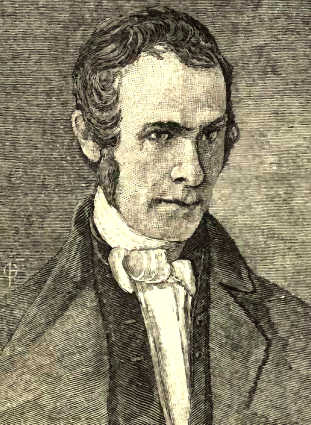
John G. Whittier in 1833.
This declaration marked one of the most important turning-points in all
the history of the United States. It drew the line. It brought to view
the presence in our land of two sets of earnest thinkers, with
diametrically opposite views touching slavery, who could not permanently
live together under one constitution. May, Phillips, Weld, Whittier, the
Tappans, and many other men of intellect, of oratorical power, and of
wealth, drew to Garrison's side. State abolition societies were
organized all over the North, the Underground Railroad was hard worked
in helping fugitives to Canada, and fiery prophets harangued wherever
they could get a hearing, demanding "immediate abolition" in the name of
God.
The Abolitionists proposed none but moral arms in fighting
slavery--papers, pamphlets, public addresses, personal appeals. They
deprecated rebellion by slaves, and urged congressional action against
slavery only in the District of Columbia, in the territories, and at
sea, where the absolute jurisdiction of the general Government was
admitted by nearly all. Nevertheless, southern hostility to them was
indescribably ferocious and uncompromising. They were charged with
instigating all the slave insurrections and insubordination that
occurred, and with having made necessary the new, more diabolical
discipline over blacks, both bond and free. Southern papers and
Legislatures incessantly commanded that Abolitionists be delivered up to
southern justice, their societies and their publications suppressed by
law, and abolitionist agitation made penal. There were northerners quite
ready to grant these demands. Rage against abolitionism, much of it, if
possible, even more unreasoning, prevailed at the North. Garrison says
that he found here "contempt more bitter, detraction more relentless,
prejudice more stubborn, and apathy more frozen than among slave-owners
themselves." The Church, politics, business--all interests save
righteousness--seemed to bow to the false god. Of all utterances against
abolitionism, those of clergymen and religious journals were the
bitterest. To call slavery sin was the unpardonable sin.
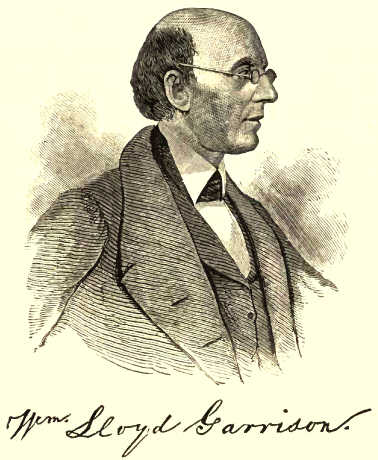
Wm. Lloyd Garrison.
[1834-1836]
In 1834, on July 4th, a mob broke up a meeting of the American
Anti-Slavery Society in New York. A few days after, Lewis Tappan's house
was sacked in the same manner, as well as several churches,
school-houses, and dwellings of colored families. At Newark, N. J., a
colored man who had been introduced into a pulpit by the minister of the
congregation, was forcibly wrenched therefrom and carried off to jail.
The pulpit was then torn down and the church gutted. In Norwich, Conn.,
the mob pulled an abolitionist lecturer from his platform and drummed
him out of town to the Rogues' March. In 1836 occurred the murder of
Rev. E. P. Lovejoy, at Alton, Ill. He was the publisher of The Observer,
an abolitionist sheet, which had already been three times suspended by
the destruction of his printing apparatus. It was at a meeting held in
Faneuil Hall over this occurrence that Wendell Phillips first made his
appearance as an anti-slavery orator. Also in 1836 the office at
Cincinnati in which James G. Birney published The Philanthropist, was
sacked, the types scattered, and the press broken and sunk in the river.
Birney was a southerner by birth, and had been a slave-holder, but had
freed his slaves. Between 1834 and 1840 there was hardly a place of any
size in the North where an Abolitionist could speak with certain safety.
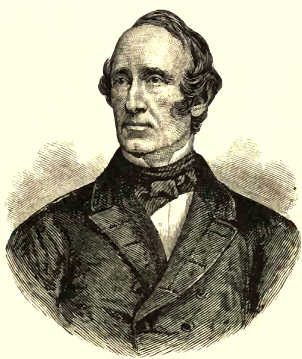
Wendell Phillip.
The destruction of colored people's houses became for a time an
every-day occurrence in many northern cities. For some years the
condition of the free blacks and their friends was hardly better north
than south. Schools for colored children were violently opposed even in
New England. One kept by Miss Prudence Crandall, at Canterbury, Conn.,
was, after its opponents had for months sought in every manner to close
it, destroyed by fire. The lady herself was imprisoned, and such schools
were by law forbidden in the State. A colored school at Canaan, N. H.,
was voted a nuisance by a meeting of the town; the building was then
dragged from its foundations and ruined. Many who aided in these deeds
belonged to what were regarded the most respectable classes of society.
[1839-1840]
Owing to the vagaries and unpatriotism of the Garrisonians, there was
from 1840 schism in the abolition ranks. Garrison and his closest
sympathizers were very radical on other questions besides that
concerning the sin of slavery. They declared the Constitution "a league
with death and a covenant with hell" because it recognized slavery. They
would neither vote nor hold office under it. They upbraided the churches
as full of the devil's allies. They also advocated community of
property, women's rights, and some of them free love. Others, as Birney,
Whittier, and Gerrit Smith, refused to believe so ill of the
Constitution or of the churches, and wished to rush the slavery question
right into the political arena. The division, far from hindering,
greatly set forward the abolitionist cause. Perhaps neither abolition
society, as such, had, after the schism of 1840, quite the influence
which the old exerted at first, but by this time a very general public
opinion maintained anti-slavery propagandism, pushing it henceforth more
powerfully than ever, as well as, through broader modes of utterance and
action, more successfully. Whittier, Lowell, Longfellow, each enlisted
his muse in the crusade. Wendell Phillips's tongue was a flaming sword.
Clergymen, politicians, and other people entirely conservative in most
things, felt free to join the new society of political Abolitionists.
In 1839 the Governor of Virginia made a requisition on Governor Seward
of New York, to send to Virginia three sailors charged with having aided
a slave out of bondage. Seward declined, on the ground that by New York
law the sailors were guilty of no crime, as that law knew nothing of
property in man. He accompanied his refusal with a discussion of slavery
and slave law quite in the abolitionist vein. To a like call from
Georgia, Seward responded in the same way, and his example was followed
by other northern governors. The Liberty Party took the field in 1840,
Birney and Earle for candidates, who polled nearly 7,000 votes. Four
years later Birney and Morris received 62,300.
It would be a mistake, let us remember, to regard the anti-abolitionist
temper at the North wholly as apathy, friendliness to slavery, or the
result of truckling to the South. Besides sharing the general fanaticism
which mixed itself with the movement, the Abolitionists ignored the
South's dilemma--the ultras totally, the moderates too much. "What
would you do, brethren, were you in our place?" asked Dr. Richard
Fuller, of Baltimore, in a national religious meeting where slavery was
under debate; "how would you go to work to realize your views?" Dr.
Spencer H. Cone, of New York, roared in reply, "I would proclaim liberty
throughout all the land, to all the inhabitants thereof." But the thing
was far from being so simple as that. Denouncing the Constitution as
Garrison did could not but affront patriotic hearts. It was impolitic,
to say the least, to import English co-agitators, who could not
understand the intricacies of the subject as presented here.
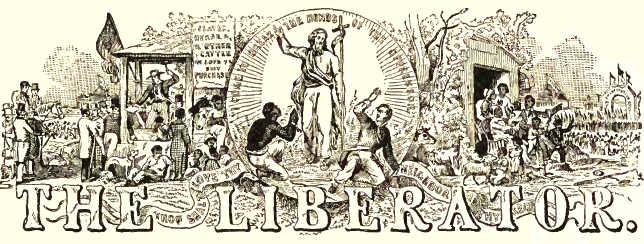
facsimile of Heading of the "Liberator."
The fact that, defying slave-masters and sycophants alike, the cause of
abolition still went on conquering and to conquer, was due much less to
the strength of its arguments and the energy of its agitation than to
the South's wild outcry and preposterous effrontery of demand.
Conservative northerners began to see that, bad as abolitionism might
be, the means proposed for its suppression were worse still, being
absolutely subversive of personal liberty, free speech, and a free
press. More serious was the conviction, which the South's attitude
nursed, that such mortal horror at Abolitionists and their propaganda
could only be explained by some sort of a conviction on the part of the
South itself that the Abolitionists were right, and that slavery was
precisely the heinous and damnable evil they declared it to be. It was
mostly in considering this aspect of the case that the Church and clergy
more and more developed conscience and voice on freedom's side, as
practical allies of abolitionism. In each great denomination the South
had to break off from the North on account of the latter's love to the
black as a human being. Men felt that an institution unable to stand
discussion ought to fall. By 1850 there were few places at the North
where an Abolitionist might not safely speak his mind.
It were as unjust as it would be painful to view this long, courageous,
desperate defence of slavery as the pure product of depravity. The South
had a cause, in logic, law, and, to an extent, even in justice. Both
sides could rightly appeal to the Constitution, the deep, irrepressible
antagonism of freedom against bondage having there its seat. The very
existence of the Constitution presupposed that each section should
respect the institutions of the other. What right, then, had the North
to allow publications confessedly intended to destroy a legal southern
institution, deeply rooted and cherished? From a merely constitutional
point of view this question was no less proper than the other: What
right had the South, among much else, to enact laws putting in prison
northern citizens of color absolutely without indictment, when, as
sailors, they touched at southern ports, and keeping them there till
their ships sailed? This outrage had occurred repeatedly.
What was
worse, when Messrs. Hoar and Hubbard visited Charleston and New Orleans,
respectively, to bring amicable suits that should go to the Supreme
Court and there decide the legality of such detention, they were obliged
to withdraw to escape personal violence.
It was said that the North must bear these incidents of slavery, so
obnoxious to it, in deference to our complex political system. Yes, but
it was equally the South's duty to bear the, to it, obnoxious incidents
of freedom. Southern men seem never to have thought of this. Doubtless,
as emancipation in any style would have afflicted it, the South could
not but account all incitements thereto as hardships; but the North must
have suffered hardships, if less gross and tangible, yet more real and
galling, had it acceded to southern wishes touching liberty of person,
speech, and the press. That at the North which offended the South was of
the very soul and essence of free government; that at the South which
aggrieved the North was, however important, certainly somewhat less
essential. Manifestly, considerations other than legal or constitutional
needed to be invoked in order to a decision of the case upon its merits,
and these, had they been judicially weighed, must, it would seem, all
have told powerfully against slavery. Not to raise the question whether
the black was a man, with the inalienable rights mentioned in the
Declaration of Independence, the South's own economic and moral weal,
and further--what one would suppose should alone have determined the
question--its social peace and political stability loudly demanded
every possible effort and device for the extirpation of slavery. That
this would have been difficult all must admit; that it was intrinsically
possible the examples of Cuba and Brazil since sufficiently prove.
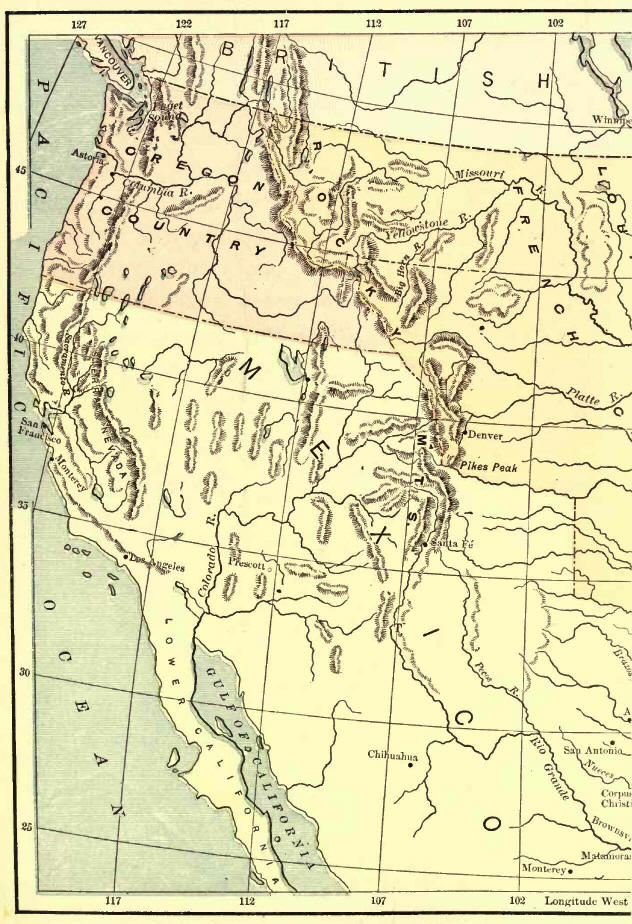
|
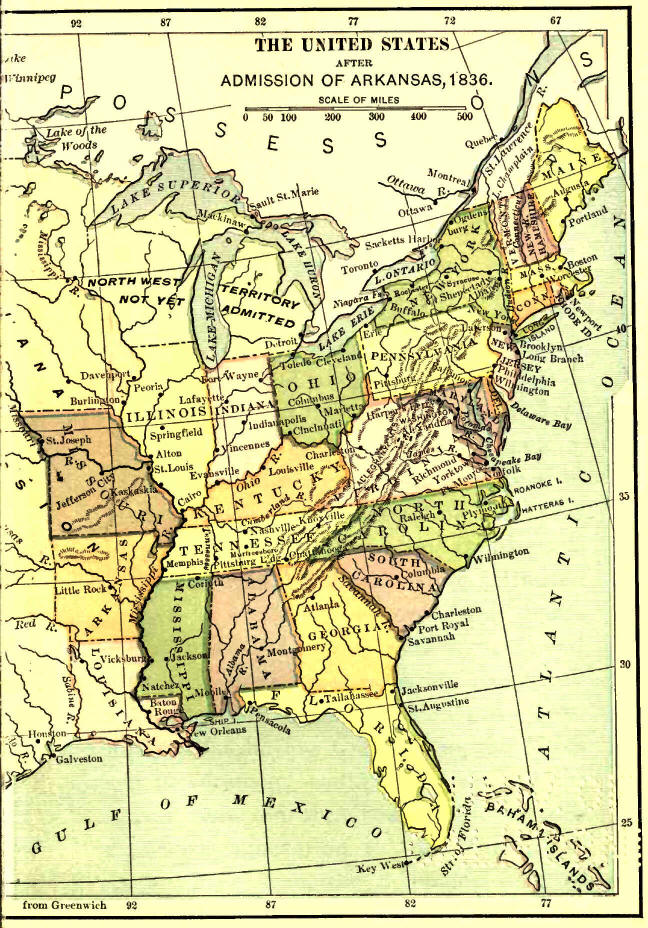
|
CHAPTER III.
THE MEXICAN WAR
[1836]
Attracted by fertility of soil and advantages for cattle-raising, large
numbers of Americans had long been emigrating to Texas. By 1830 they
probably comprised a majority of its inhabitants. March 2, 1836, Texas
declared its independence of Mexico, and on April 10th of that year
fought in defence of the same the decisive battle of San Jacinto. Here
Houston gained a complete victory over Santa Anna, the Mexican
President, captured him, and extorted his signature to a treaty
acknowledging Texan independence. This, however, as having been forced,
the Mexican Government would not ratify.
[1845]
Not only did the Texans almost to a man wish annexation to our Union,
but, as we have seen, the dominant wing of the democratic party in the
Union itself was bent upon the same, forcing a demand for this into
their national platform in 1840. Van Buren did not favor it, which was
the sole reason why he forfeited to Polk the democratic nomination in
1844. Polk was elected by free-soil votes cast for Birney, which, had
Clay received them, would have carried New York and Michigan for him and
thus elected him; but the result was hailed as indorsing annexation.
Calhoun, Tyler's Secretary of State, more influential than any other one
man in bringing it about, therefore now advocated it more zealously than
ever. Calhoun's purpose in this was to balance the immense growth of the
North by adding to southern territory Texas, which would of course
become a slave State, and perhaps in time make several States. As the
war progressed he grew moderate, out of fear that the South's show of
territorial greed would give the North just excuse for sectional
measures.
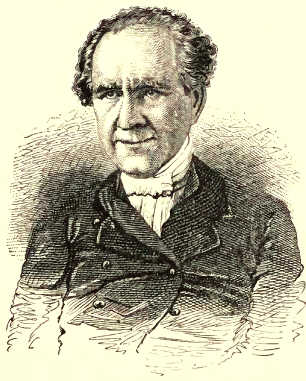
General Sam. Houston.
Henry Clay, with nearly the entire Whig Party, from the first opposed
the Tyler-Calhoun programme. Clay's own reason for this, as his
memorable Lexington speech in 1847 disclosed, was that the United States
would be looked upon "as actuated by a spirit of rapacity and an
inordinate desire for territorial aggrandizement." His party as a whole
dreaded more the increment which would come to the slave power. After
much discussion in Congress, Texas was annexed to the Union on January
25, 1845, just previous to Polk's accession. June 18th, the Texan
Congress unanimously assented, its act being ratified July 4th by a
popular convention. Thus were added to the United States 376,133 square
miles of territory.
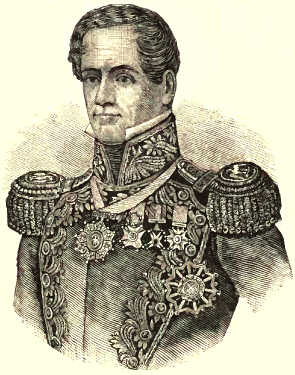
General Santa Anna.
The all-absorbing question now was where Texas ended: at the Nueces, as
Mexico declared, or at the Rio Grande, as Texas itself had maintained,
insisting upon that stream as of old the bourne between Spanish America
and the French Louisiana. Mexico, proud, had recognized neither the
independence of Texas nor its annexation by the United States, yet would
probably have agreed to both as preferable to war, had the alternative
been allowed. To be sure, she was dilatory in settling admitted claims
for certain depredations upon our commerce, threatened to take the
annexation as a casus belli, withdrew her envoy and declined to accept
Slidell as ours, and precipitated the first actual bloodshed. Yet war
might have been averted, and our Government, not Mexico's, was to blame
for the contrary result. Slidell played the bully, the navy threatened
the coast, our wholly deficient title, through Texas, to the
Nueces-Rio-Grande tract was assumed without the slightest ado to be
good, and when General Arista, having crossed the river in Taylor's
vicinity, repelled the latter's attack upon him, the President, followed
by Congress, falsely alleged war to exist "by act of the Republic of
Mexico."
[1846]
During most of 1845, General Zachary Taylor was at Corpus Christi on the
west bank of the Nueces, in command of 3,600 men. The first aggressive
movement occurred in March of the following year, when Taylor, invading
the disputed territory by command from Washington, advanced to the Rio
Grande, opposite Matamoras. April 26th, a Mexican force crossed the
river and captured a party of American dragoons which attacked them.
Taylor drew back to establish communication with Point Isabel, and on
advancing again toward the Rio Grande, May 8th, found before him a
Mexican force of nearly twice his numbers, commanded by Arista. The
battle of Palo Alto ensued, and next day that of Resaca de la Palma,
Taylor completely victorious in both. May 13th, before knowledge of
these actions had reached Washington, warranted merely by news of the
cavalry skirmish on April 26th, Congress declared war, and the President
immediately called for 50,000 volunteers. In July Taylor was re-enforced
by Worth, and proceeded to organize a campaign against Monterey, a
strongly fortified town some ninety miles toward the City of Mexico.
This place was reached September 19th, and captured on the 22d, after
hard fighting and severe losses on both sides. An armistice of eight
weeks followed.
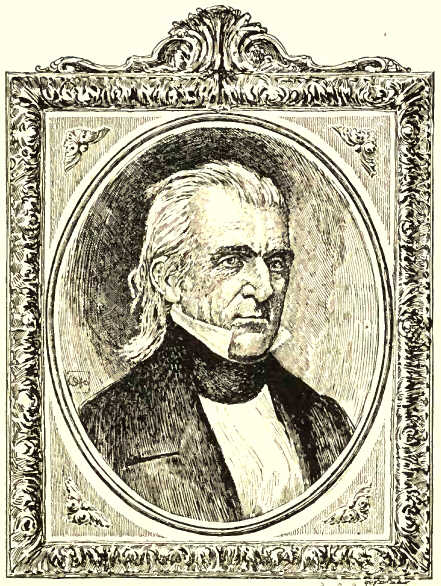
James K. Polk, after a photograph by Brady.
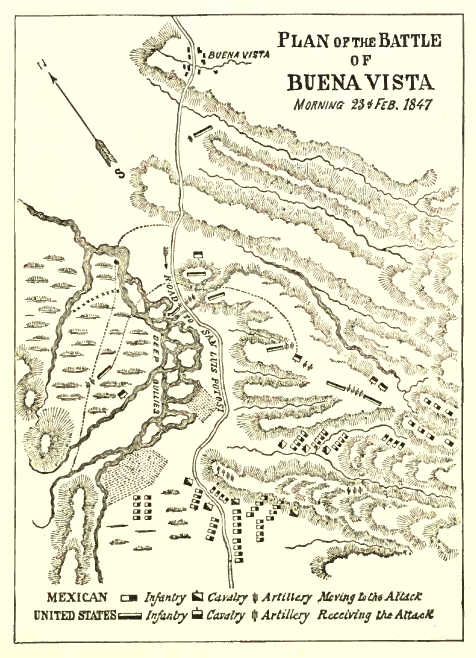
PLAN OF THE BATTLE OF BUENA VISTA MORNING 23 OF FEB 1847.
[1847]
Meantime a revolution had occurred in Mexico. The banished Santa Anna
was recalled, and as President of the Republic assumed command of the
Mexican armies. On February 23, 1847, occurred one of the most
sanguinary but brilliant battles of the war, that of Buena Vista.
Taylor, learning that a Mexican force was advancing under Santa Anna, at
least double the 5,200 left him after the requisition upon him which
General Scott had just made, drew back to the strong position of Buena
Vista, south of Saltillo. Here Santa Anna, having through an intercepted
despatch learned of Taylor's weakness, ferociously fell upon him with a
force 12,000 strong. On right and centre, by dint of good tactics and
bull-dog fighting, Taylor held his own and more, but the foe succeeded
at first in partly turning and pushing back his left. The Mexican
commander bade Taylor surrender, but was refused, whence the saying that
"Old Rough and Ready," as they called Taylor, "was whipped but didn't
know it."
To check the flanking movement he sent forward two regiments of
infantry, well supported by dragoons and artillery, who charged the
advancing mass, broke the Mexicans' column, and sent them fleeing in
confusion. This saved the day. The American loss was 746, including
several officers, among them Lieutenant-Colonel Clay, son of the
Kentucky statesman. Colonel Jefferson Davis, one day to be President of
the Southern Confederacy, caused during this conflict great havoc in the
enemy's ranks with his Mississippi riflemen. Santa Anna's loss was
2,000.
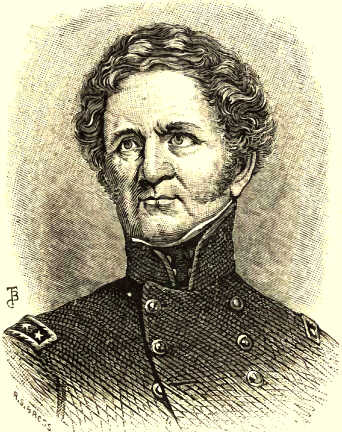
General Winfield Scott.
General Winfield Scott had meantime been ordered to Mexico as chief in
command. Taylor was a Whig, and the Whigs whispered that his martial
deeds were making the democratic cabinet dread him as a presidential
candidate. But Scott was a Whig, too, and if there was anything in the
surmise, his victorious march must have given Polk's political household
additional food for reflection. Scott's plan was to reduce Vera Cruz,
and thence march to the Mexican capital, two hundred miles away, by the
quickest route. Vera Cruz capitulated March 27, 1847.
Scott straightway struck out for the interior. He was bloodily opposed
at Cerro Gordo, April 18th, and at Jalapa, but he made quick work of the
enemy at both these places. In the latter city, after his victory, he
awaited promised re-enforcements. When the last of these had arrived,
August 6th, under General Franklin Pierce, so that he could muster about
14,000 men, he advanced again. August 10th the Americans were in sight
of the City of Mexico. This was a natural stronghold, and art had added
to its strength in every possible way. Except on the south and west it
was nearly inaccessible if defended with any spirit. Scott of course
directed his attack toward the west and south sides of the city. The
first battle in the environs of the capital was fiercely fought near the
village of Contreras, and proved an overwhelming defeat for the
Mexicans. Two thousand were killed or wounded, while nearly 1,000,
including four generals, were captured, together with a large quantity
of stores and ammunition. The American loss was only 60 killed and
wounded.
The survivors fled to Churubusco, farther toward the city, where, with
every advantage of position, Santa Anna had united his forces for a
final stand. An old stone convent, which our artillery could not reach
till late in the action, was utilized as a barricade, and from this the
Mexicans poured a most deadly fire upon their assailants. The Americans
were victorious, as usual, but their loss was fearful, 1,000 being
killed or wounded, including 76 officers. A truce to last a fortnight
was now agreed upon, but Scott, seeing that the Mexicans were taking
advantage of it to strengthen their fortifications, did not wait so
long. He now had about 8,500 men fit for duty, and sixty-eight guns.
Hostilities were renewed September 7th, by the storm and capture,
costing nearly 800 men, of Molino del Rey, or "King's Mill," a mile and
a half from the city.
Possession of the Molino opened the way to Chapultepec, the Gibraltar of
Mexico, 1,100 yards nearer the goal. As it was built upon a rock 150
feet high, impregnable on the north and well-nigh so on the eastern and
most of the southern face, only the western and part of the southern
sides could be scaled. But the stronghold was the key to the city, and
after surveying the situation, a council of war decided that it must be
taken. Two picked American detachments, one from the west, one from the
south, pushed up the rugged steeps in face of a withering fire. The
rock-walls to the base of the castle had to be mounted by ladders. This
was successfully accomplished; the enemy were driven from the building
back into the city, and the castle and grounds occupied by our troops. A
large number of fugitives were cut off by a force sent around to the
north.
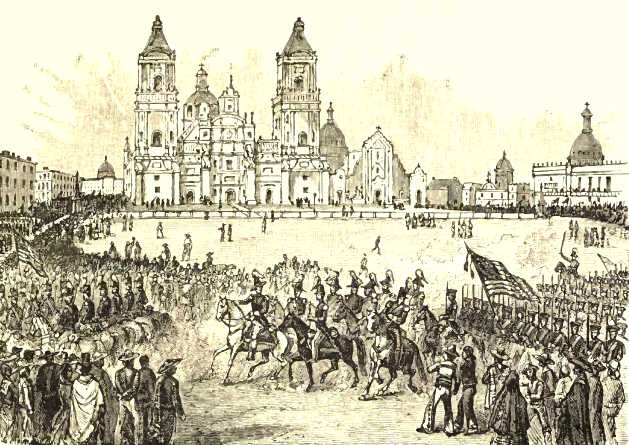
The Plaza of the City of Mexico.
[1848]
To pierce the city was even now by no means easy. The approach was by
two roads, one entering the Belen gate, the other the San Cosme. General
Quitman advanced toward the Belen, but at the entrance was stopped by a
destructive cannonade from the citadel itself. Those fighting their way
toward the San Cosme succeeded in entering the city, Lieutenant U. S.
Grant making his mark in the gallant work of this day. The city was
evacuated that night, and on the 15th of September, 1847, was fully in
the hands of Scott.
The treaty of Guadalupe Hidalgo was signed on February 2, 1848. It
established the Rio Grande as the boundary between the two countries,
and New Mexico, of course including what is now Arizona and also
California, was ceded to the United States for $15,000,000. The United
States also assumed, to the sum of $3,250,000, the claims of American
citizens upon Mexico. For Gadsden's Purchase, in 1853, between the Gila
River and the Mexican State of Chihuahua, we paid $10,000,000 more. Our
territory thus received in all, as a consequence of the Mexican War, an
increment of 591,398 square miles.
Inseparable from the politics of the Mexican War is the Oregon question,
since Oregon's re-occupation and "fifty-four forty or fight" had been
democratic cries for securing to Polk west-northern votes in 1844. We
had, however, no valid claim so far north, except against Russia--by the
treaty of 1824. The Louisiana purchase, indeed, had vested us with
whatever--very dubious--rights France had upon the Pacific, and the
Florida treaty of 1819 gave us the far better title of Spain to the
coast north of 42 degrees. This treaty, with Gray's discovery of the
Columbia in 1792, Lewis and Clarke's official explorations of the
Columbia valley in 1804-05-06, England's retrocession, in 1818, of
Astoria, captured during the War of 1812, and extensive actual
settlements upon the river by American citizens from 1832 on, made our
claim perfect up to 49 degrees at least. This parallel the convention
with Great Britain in 1818 had already fixed as our northern line from
the Lake of Woods to the Rocky Mountains. Between this and 54 degrees 40
minutes, England's title, from exploration and settlement, was superior
to ours, which was based upon alleged old Spanish discovery. The same
convention of 1818, renewed in 1827, opened the Oregon country to
occupation by settlers from both nations. Increase of immigration
rendering a fixing of jurisdictions imperative, England pressed for the
line of the Columbia below its intersection of the forty-ninth parallel.
We had twice offered to settle upon 49 degrees, which limit the rapid
growth of our population in the region induced England in 1836 to
accept. Whether Polk's blustering demand for "all Oregon," which came
near bringing on war with England, and his much condemned recession
later, were mere opportunist acts, is still a question. Many consider
them pieces of a deep-laid policy by Polk to tole Mexico to war in hope
of England's aid, then, suddenly pacifying England, to devour Mexico at
his leisure.
CHAPTER IV.
CALIFORNIA AND THE COMPROMISE OF 1850
[1846]
One of the campaigns at the beginning of the Mexican War was that of
General Stephen W. Kearney, from Fort Leavenworth, against New Mexico.
It was opened in May, 1846. He invaded the country without much
opposition, arrived at Santa Fe August 18th, having marched 873 miles,
declared the inhabitants free from all allegiance to Mexico, and formed
a territorial government over them as United States subjects.
Captain John C. Fremont had previously, but in the same year, 1846, been
sent to California at the head of an exploring expedition, and in May he
was notified to remain in the country in anticipation of hostilities. On
June 15th he captured Samona. Meanwhile, Commodore Sloat was erecting
our flag over the towns on the coast. In July Sloat was superseded by
Commodore Stockton, who routed the Mexican commander, De Castro, at Los
Angeles, joined Fremont, and on August 13th seized Monterey, the then
capital. The two commanders now placed themselves at the head of a
provisional government for California.
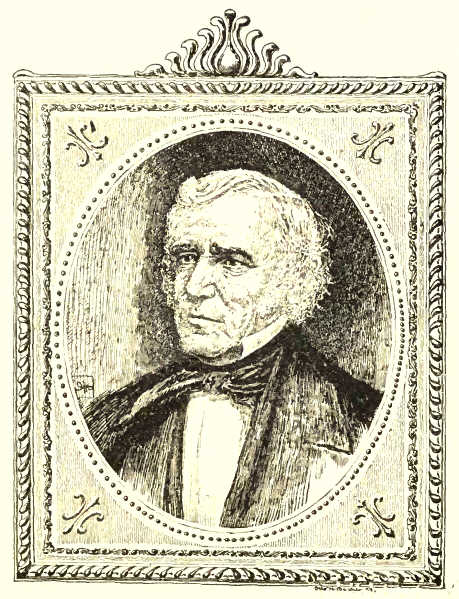
Zachary Taylor. After a photograph by Brady.
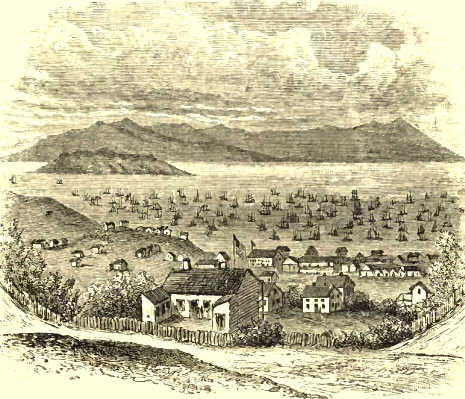
The Site of San Francisco in 1848.
[1848-1849]
In 1848, on the same day and almost at the same hour when the peace of
Guadalupe Hidalgo was concluded, gold was discovered in California. It
was on the land of one Sutter, a Swiss settler in the Sacramento Valley,
as some workmen were opening a flume for a mill. In three months over
4,000 persons were there, digging for gold with great success. By July,
1849, it is thought, 15,000 had arrived. Nearly all were forced to live
in booths, tents, log huts, and under the open sky. The sparse
population previously on the ground left off farming and grazing and
opened mines. People became insane for gold. Immigrants soon came in
immense hordes. In 1846, aside from roving Indians, California had
numbered not much over 15,000 inhabitants. By 1850, it seems certain
that the territory contained no fewer than 92,597. The new-comers were
from almost every land and clime--Mexico, South America, the Sandwich
Islands, China--though, of course, most were Americans. The bulk of
these hailed from the Northwest and the Northeast. To this land of
promise the sturdy pioneers from the Mississippi Valley found their way
on foot, on horseback, or in wagons, over the Rocky Mountains and the
Sierras, following trails previously untrodden by civilized man. Those
from the East made long detours around Cape Horn or across the Isthmus
of Panama.
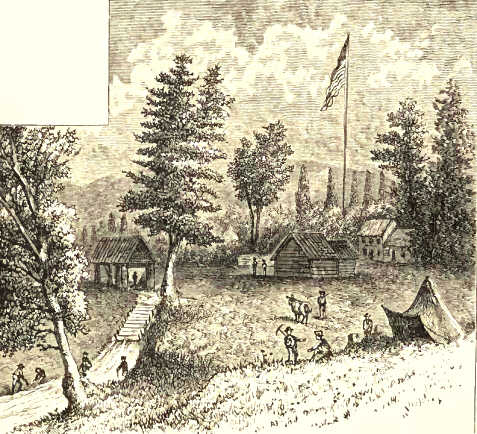
Sutter's Mill, California, where Gold was First Discovered.
The yield of gold from the virgin placers was enormous, a laborer's
average the first season being perhaps an ounce a day, though many made
much more. During the first two years about $40,000,000 worth of gold
was extracted. According to careful estimates the gold yield of the
United States, mostly from California, which had been only $890,000 in
1847, increased to $10,000,000 in 1848, to $40,000,000 in 1849, to
$50,000,000 in 1850, to $55,000,000 in 1851, to $60,000,000 in 1852, and
in 1853 to $65,000,000.
Most interesting were the spontaneous governmental and legal
institutions which arose in these motley communities, some of them
finding their originals in the English mining districts, others in
Mexico and Spain, and still others recalling the mining customs of
medieval Germany. For a time many camps had each its independent
government, disconnected from all human authority around or above. Some
of these were modelled after the Mexican Alcaldeship, others after the
New England town. Over those who rushed to the vicinity of Sutter's mill
that gentleman became virtual Alcalde, though he was not recognized by
all. The men first opening a placer would seek to pre-empt all the
adjoining land, giving up only when others came in numbers too strong
for them. Officers were elected and new customs sanctioned as they were
needed. Partnerships were sacredly maintained, yet by no other law than
that of the camp. Crimes against property and life seem to have been
infrequent at first, but the unparalleled wealth toled in and developed
a criminal class, which the rudimentary government could not control.
San Francisco formed in 1851 a vigilance committee of citizens, by which
crimes could be more summarily and surely punished. The pioneer banking
house in California began business at San Francisco in January, 1849.
The same month saw the first frame house on the Sacramento, near
Sutter's Fort.
The vast acquisition of territory by the Mexican War seemed destined to
be a great victory for slavery, because nearly all of it lay south of 36
degrees 30 minutes and hence by the Missouri Compromise could become
slave soil. But there was the complication that under Mexico all this
wide realm had been free. To exist there legally slavery must therefore
be established by Congress, making the case very different from the
cases of Louisiana, Florida, and Texas, which came under United States
authority already burdened. This predisposed many who were not in
general opposed to slavery, against extending the institution hither.
Early in the war a bill had passed the House, failing almost by accident
in the Senate, which contained the famous Wilmot Proviso, so named from
its mover in the House, that, except for crime, neither slavery nor
involuntary servitude should ever exist in any of the territories to be
annexed. Wilmot was a Democrat, and at this time a decided majority of
his party favored the proviso. But the pro-slavery wing rallied, while
the Whigs, disbelieving in the war and in annexation both, offered the
proviso Democrats no hearty aid. In consequence it was defeated both
then and after the annexation.
The election of 1848 went for the Whigs, and the next March 4th, General
Taylor became President. Though a southerner and a slave-holder, he was
moderate and a true patriot. So rapid had been the influx into
California that the Territory needed a stable government. Accordingly,
one of Taylor's first acts as President was to urge California to apply
for admission to statehood. General Riley, military governor, at once
called a convention, which, sitting from September 1st to October 13th,
framed a constitution and made request that California be taken into the
Union. This constitution prohibited slavery, and thus a new firebrand
was tossed into the combustible material with which the political
situation abounded. By this time nearly all the friends of freedom were
for the proviso, but its enemies as well had greatly increased. The
immense growth, actual and prospective, of northern population, greatly
inspired one side and angered the other.
[1850]
Resort was now had again to the old, illusive device of compromise, Clay
being the leader as usual. He brought forward his "Omnibus Bill," so
called because it threw a sop to everybody. It failed to pass as a
single measure, but was broken up and enacted piecemeal. Stubborn was
the fight. Radicals of the one part would consent to nothing short of
extending the Missouri Compromise line to the Pacific; those of the
other stood solidly for the unmodified proviso.
In this crisis occurred President Taylor's death, July 9, 1850, which
was most unfortunate. He was known not to favor the pro-slavery
aggression which, in spite of Clay's personal leaning in the opposite
direction, the omnibus bill embodied. Mr. Fillmore, as also Webster,
whom he made his Secretary of State, nervous with fear of an
anti-slavery reputation, went fully Clay's length. The debate on this
compromise of 1850 was the occasion when Webster deserted the free-soil
principles which were now dominant in New England. His celebrated speech
of March. 7th marked the crisis of his life. He argued that the proviso
was not needed to prevent slavery in the newly gotten district, while
its passage would be a wanton provocation to the South From this moment
Massachusetts dropped him. When she next elected a senator for a full
term, it was Charles Sumner, candidate of the united Democrats and
Free-soilers, who went to Congress pledged to fight slavery to the
death.
But the omnibus compromises were passed. California was, indeed,
admitted free, September 9, 1850--the thirty-first State in order--and
slave-trade in the District of Columbia slightly alleviated. On the
other hand, Texas was stretched to include a huge piece of New Mexico
that was free before, and paid $10,000,000 to relinquish further claims.
This was virtually a bonus to holders of her scrip, which from seventeen
cents the dollar instantly rose to par. New Mexico and Utah were to be
organized as Territories without the proviso, and were made powerless to
legislate on slavery till they should become States. Least sufferable, a
fugitive slave law was passed, so Draconian that that of 1793, hitherto
in force, was benign in comparison. It placed the entire power of the
general Government at the slave-hunter's disposal, and ordered rendition
without trial or grant of habeas corpus, on a certificate to be had by
simple affidavit. Bystanders, if bidden, were obliged to help marshals,
and tremendous penalties imposed for aid to fugitives.
This act facilitated the recovery of fugitives at first, but not
permanently. Many who had labored for its passage soon saw that it was a
mistake. It powerfully fanned the abolition flame all over the North.
New personal liberty laws were enacted. A daily increasing number
adopted the view that the new act was unconstitutional, on the ground
that the Constitution places the rendition of slaves as of criminals in
the hands of States, and guarantees jury trial, even upon title to
property, if over twenty dollars in value. After the act had been
justified in the courts, multitudes of moderate northern men urged to a
dangerous degree the doctrine of state rights in defence of the liberty
laws. Others adopted the cry of the "higher law," and without joining
Garrison in denouncing the Government, did not hesitate to oppose in
every possible way the operation of this drastic legislation for
slave-catching.
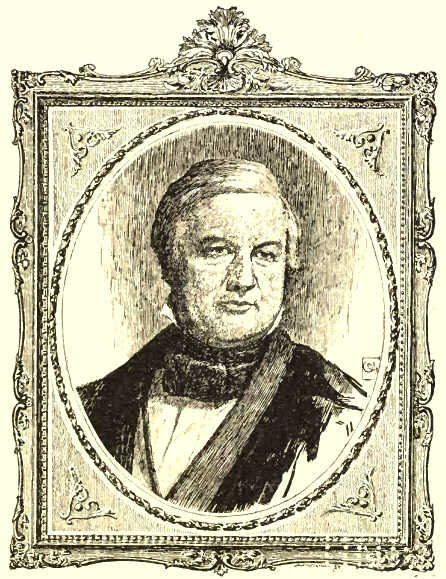
Millard Fillmore.
From a painting by Carpenter in 1853, at the City Hall, New York.
The country's growth made escape from bondage continually easier and
easier. Once across the border a runaway was sure to find many friends
and few enemies. Openly, or, if this was required, by stealth, he was
passed quickly along to the Canada line. Between 1830 and 1860 over
30,000 slaves are estimated to have taken refuge in Canada. By 1850,
probably no less than 20,000 had found homes in the free States. The new
law moved many of these across into the British dominions. It was hence
increasingly difficult for the slave-owner to recover stray property.
All possible legal obstructions were placed in his way, and when these
failed he was likely still to be opposed by a mob which might prove too
powerful for the marshal and any posse which he could gather.
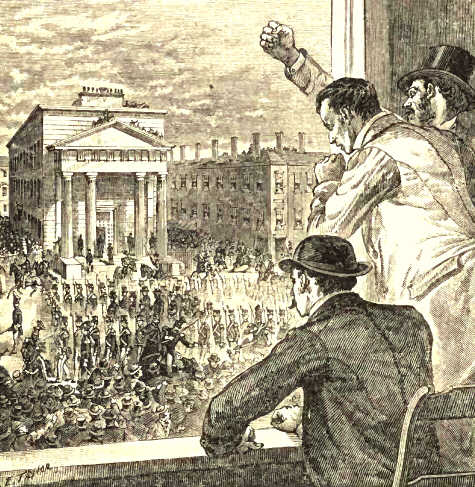
The Rendition of Anthony Burns in Boston.
In Boston, when a slave named Shadrach was arrested, his friends made a
sudden dash, rescued him from the officers and freed him. With Simms the
same was attempted, but in vain. The removal of Anthony Burns
from that
city in 1855 was possible only by escorting him down State Street to the
revenue cutter in waiting, inside a dense hollow square of United States
artillerymen and marines, with the whole city's militia under arms and
at hand. Business houses as well as residences were closed and draped in
mourning. It was an indignity which Massachusetts never forgot. At
Alton, Ill., slave-hunters seized a respectable colored woman, long
resident there, who fully believed herself free. She was surrounded by
an infuriated company of citizens, and would have been wrenched from her
captors' clutch had not they, in their terror, offered to sell her back
into freedom. The needed $1,200 was raised in a few minutes, and the
agonized creature restored to her family. Judge Davis, whom the evidence
had compelled to deliver the woman, on rendering the sentence resigned
his commission, declaring: "The law gives you your victim. Thank it and
not me, and may God have mercy on your sinful souls."
CHAPTER V.
THE FIGHT FOR KANSAS
[1850-1854]
The measures of 1850 proved anything but the "finality" upon slavery
discussion which both parties, the Whigs as loudly as the Democrats,
promised and insisted that they should be. Elated by its victory in
1850, and also by that of 1852, when the anti-slavery sentiment of
northern Whigs drove so many of their old southern allies to vote for
Pierce, giving him his triumphant election, the slavocracy in 1854
proceeded in its work of suicide to undo the sacred Missouri Compromise
of 1820. Douglas, the ablest northern Democrat, led in this, succeeding,
as official pacificator between North and South, somewhat to the office
of Clay, who had died June 29, 1852. The aim of most who were with him
was to make Kansas-Nebraska slave soil, but we may believe that Douglas
himself cherished the hope and conviction that freedom was its destiny.
This rich country west and northwest of Missouri, consecrated to freedom
by the Missouri Compromise, had been slowly filling with civilized men.
It did not promise to be a profitable field for slavery, nor would
economic considerations ever have originated a slavery question
concerning it. But politically its character as slave or free was of the
utmost consequence to the South, where the resolution gradually arose
either to secure it for the peculiar institution or else prevent its
organization even as a Territory. A motion for such organization had
been unsuccessfully made about 1843, and it was repeated, equally
without effect, each session for ten years. None of these motions had
contained any hint that slavery could possibly find place in the
proposed Territory. The bill of December 15, 1853, like its
predecessors, had as first drawn no reference whatever to slavery, but
when it returned from the committee on Territories, of which Douglas was
chairman, the report, not explicitly, indeed, made the assumption,
unheard of before, that Kansas-Nebraska stood in the same relation to
slavery in which Utah and New Mexico had stood in 1850; and that the
compromise of that year, in leaving the question of slavery to the
States to be formed from these Territories, had already set aside the
agreement of 1820. These assumptions were totally false. The act of 1850
gave Utah and New Mexico no power as Territories over the debatable
institution, and contained not the slightest suggestion of any rule in
the matter for territories in general.
But the hint was taken, and on January 16th notice given of intention to
move an out-and-out abrogation of the Missouri Compromise. Such
abrogation was at once incorporated in the Kansas-Nebraska bill reported
by Douglas, January 23, 1854. This separated Kansas from Nebraska, and
the subsequent struggle raged in reference to Kansas alone. The bill
erroneously declared it established by the acts of 1850 that "all
questions as to slavery in the Territories," no less than in the States
which should grow out of them, were to be left to the residents, subject
to appeal to the United States courts. It passed both houses by good
majorities and was signed by President Pierce May 30th. Its animus
appeared from the loss in the Senate of an amendment, moved by S. P.
Chase, of Ohio, allowing the Territory to prohibit slavery.
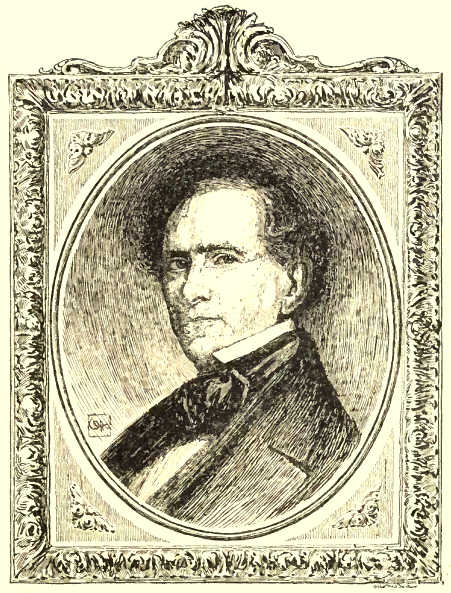
Franklin Pierce.
From a painting by Healy, in 1852, at the Corcoran Art Gallery.
Thus was first voiced by a public authority Judge Douglas's new and
taking heresy of "squatter sovereignty," that Congress, though
possessing by Article IV., Section iii., Clause 2 of the Constitution,
general authority over the Territories, is not permitted to touch
slavery there, but must leave it for each territorial populace "to vote
up or vote down." At the South this doctrine of Douglas's was dubbed
"nonintervention," and its real aim to secure Kansas a pro-slavery
character avowed. It was consequently popular there as useful toward the
repeal, although repudiated the instant its working bade fair to render
Kansas free.
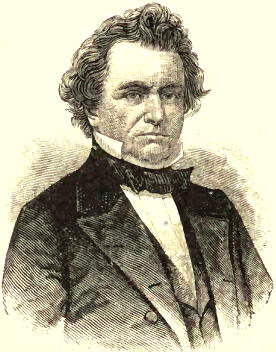
Stephen A. Douglas.
[1855]
This was soon the prospect. Organizations had been formed to aid
anti-slavery emigrants from the northern States to Kansas. The first was
the Kansas Aid Society, another a Massachusetts corporation entitled the
New England Emigrant Aid Society. There were others still. Kansas began
to fill up with settlers of strong northern sympathies. They were in
real minority at the congressional election of November, 1854, and in
apparent minority at the territorial election the next March. The vote
against them on the last occasion, however, was largely deposited by
Missourians who came across the border on election day, voted, and
returned. This was demonstrated by the fact that there were but 2,905
legal voters in the Territory at the time, while 5,427 votes were cast
for the pro-slavery candidates alone. These early successes gave the
pro-slavery party and government in Kansas great vantage in the
subsequent congressional contest. The first Legislature convened at
Pawnee, July 2, 1855, enacted the slave laws of Missouri, and ordered
that for two years all state officers should be appointed by legislative
authority, and no man vote in the Territory who would not swear to
support the fugitive slave law.
The free-state settlers, now a majority, ignored this Legislature and
its acts, and at once set to work to secure Kansas admission to the
Union as a State without slavery. The Topeka convention, October 23,
1855, formed the Topeka constitution, which was adopted December 14th,
only forty-six votes being polled against it. This showed that
pro-slavery men abstained from voting. January 15, 1856, an election was
held under this constitution for state officers, a state legislature,
and a representative in Congress. The House agreed, July 3d, by one
majority, to admit Kansas with the Topeka constitution, but the Senate
refused. The Topeka Legislature assembled July 4th, but was dispersed by
United States troops.
[1856-1857]
This was done under command from Washington. President Pierce, backed by
the Senate with its steady pro-slavery majority, was resolved at all
hazards to recognize the pro-slavery authorities of Kansas and no other,
and, as it seemed, to force it to become a slave State; but fortunately
the House had an anti-slavery majority which prevented this. The friends
of freedom in Kansas had also on their side the history that was all
this time making in Kansas itself. During the summer of 1856 that
Territory was a theatre of constant war. Men were murdered, towns
sacked. Both sides were guilty of violence, but the free-state party
confessedly much the less so, having far the better cause. Nearly all
admitted that this party was in the majority. Even the governors, all
Democrats, appointed by Pierce, acknowledged this, some of them, to all
appearance, being removed as a punishment for the admission. Governor
Geary, in office from September, 1856, to March, 1857, and Governor
Walker, in office from May, 1857, were just and able men, and their
decisions, in most things favorable to the free-state cause, had much
weight with the country.
Walker's influence in the Territory led the free-state men to take part
in the territorial election of October, 1857, where they were entirely
triumphant. But the old, pro-slavery Legislature had called a
constitutional convention, which met at Lecompton, September, 1857, and
passed the Lecompton constitution. This constitution sanctioned slavery
and provided against its own submission to popular vote. It ordained
that only its provision in favor of slavery should be so submitted. This
pro-slavery clause was adopted, but only because the free-state men
would not vote. The Topeka Legislature submitted the whole constitution
to popular vote, when it was overwhelmingly rejected. The President and
Senate, however, urged statehood under the Lecompton constitution,
although popular votes in Kansas twice more, April, 1858, and March,
1859, had adopted constitutions prohibiting slavery, the latter being
that of Wyandotte. But the House still stood firm. Kansas was not
admitted to the Union till January 29, 1861, when her chief foes in the
United States Senate had seceded from the Union. She came in with the
Wyandotte constitution and hence as a free State.
It was during the debate upon Kansas affairs in 1856 that Preston S.
Brooks, a member of the House from South Carolina, made his cowardly
attack upon Charles Sumner. Sumner had delivered a powerful speech upon
the crime against Kansas, worded and delivered, naturally but
unfortunately, with some asperity. In this speech he animadverted
severely upon South Carolina and upon Senator Butler from that State.
This gave offence to Brooks, a relative of Butler, and coming into the
Senate Chamber while Sumner was busy writing at his desk, he fell upon
him with a heavy cane, inflicting injuries from which Sumner never
recovered, and which for four years unfitted him for his senatorial
duties. Sumner's colleague, Henry Wilson, in an address to the Senate,
characterized the assault as it deserved. He was challenged by Brooks,
but refused to fight on the ground that duelling was part of the
barbarism which Brooks had shown in caning Sumner. Anson Burlingame,
representative from Massachusetts, who had publicly denounced the
caning, was challenged by Brooks and accepted the challenge, but, as he
named Canada for the place of meeting, Brooks declined to fight him for
the ostensible reason that the state of feeling in the North would
endanger his life upon the journey. A vote to expel Brooks had a
majority in the House, though not the necessary two-thirds. He resigned,
but was at once re-elected by his South Carolina constituency.
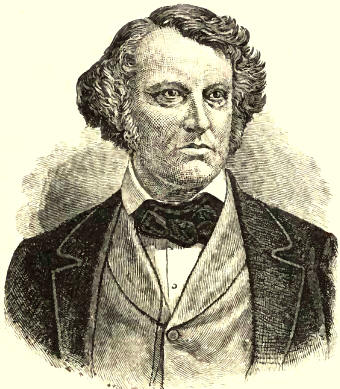
Charles Sumner.
While the fierce Kansas controversy had been raging, the South had grown
cold toward the Douglas doctrine of popular sovereignty, and had
gradually adopted another view based upon Calhoun's teachings. This was
to the effect that Congress, not under Article IV., section iii., clause
2, but merely as the agent of national sovereignty, rightfully
legislates for the Territories in all things, yet, in order to carry out
the constitutional equality of the States in the Territories, is obliged
to treat slaves found there precisely like any other property. If one
citizen wishes to hold slaves, all the rest opposing, the general
Government must support him. It is obvious how antagonistic this thought
was to that of Douglas, since, according to the latter, a majority of
the inhabitants in a Territory could elect to exclude slavery as well as
to establish it.
The new southern or Calhoun theory assumed startling significance for
the Nation when, in 1857, it was proclaimed in the Dred Scott decision
of the United States Supreme Court as part of the innermost life of our
Constitution. Dred Scott was a slave of an army officer, who had taken
him from Missouri first into Illinois, a free State, then into
Wisconsin, covered by the Missouri Compromise, then back into Missouri.
Here the slave learned that by decisions of the Missouri courts his life
outside of Missouri constituted him free, and in 1848, having been
whipped by his master, he prosecuted him for assault. The decision was
in his favor, but was reversed when appeal was taken to the Missouri
Supreme Court. Dred Scott was now sold to one Sandford, of New York. Him
also he prosecuted for assault, but as he and Sandford belonged to
different States this suit went to the United States Circuit Court.
Sandford pleaded that this lacked jurisdiction, as the plaintiff was not
a citizen of Missouri but a slave.
It was this last issue which made the case immortal. The Circuit Court
having decided in the defendant's favor, the plaintiff took an appeal to
the Supreme Court. Here the verdict was against the citizenship of the
negro, and therefore against the jurisdiction of the court below. The
upper court did not stop with this simple dictum, hard and dubious as it
was, but proceeded to lay down as law an astounding course of
pro-slavery reasoning. In this it confined the ordinance of 1787 to the
old northwestern territory, declared the Missouri Compromise and all
other legislation against slavery in Territories unconstitutional, and
the slave character portable not only into all the Territories but into
all the States as well, slavery having everywhere all presupposition in
its favor and freedom being on the defensive. The denial of Scott's
citizenship was based solely upon his African descent, the inevitable
implication being that no man of African blood could be an American
citizen.
This decision rendered jubilant all friends of slavery, as also the
ultra Abolitionists, but correspondingly disheartened the sober friends
of human liberty. How, it was asked, is the cause of freedom to be
advanced when the supreme law of the land, as interpreted by the highest
tribunal existing for that purpose, virtually establishes slavery in New
England itself, provided any slave-master wishes to come there with his
troop? But anti-slavery men did not despair. Patriots had of course to
obey the court till its opinion should be reversed, yet its opinion was
at once repudiated as bad law. Men like Sumner, Wilson, Chase, Giddings,
Seward, and Lincoln, appealing to both the history and the letter of the
Constitution, and to the course of legislation and of judicial decisions
on slavery even in the slave States, had been elaborating and
demonstrating the counter theory, under which our fundamental law
appeared as anything but a "covenant with hell."
The pith of this counter theory was that slaves were property not by
moral, natural, or common law, but only by state law, that hence
freedom, not slavery, was the heart and universal presupposition of our
government, and that slavery, not freedom, was bound to show reasons for
its existence anywhere. This being so, while Calhoun and Taney were
right as against Douglas in ascribing to Congress all power over the
Territories, it was as impossible to find slaves in any United States
Territory as to find a king there. Slaves taken into Territories
therefore became free. Slaves taken into any free State became free.
Slaves carried from a slave State on to the high seas became free. Even
the fugitive slave clause of the Constitution must be applied in the way
least favorable to slavery.
On the other hand Douglas was right in his view that citizens and not
States were the partners in the Territories. As to the assertion of
incompatibility between citizenship and African blood, it would not
stand historical examination a moment. If it was true that the framers
of the Constitution did not consciously include colored persons in the
"ourselves and our posterity" for whom they purposed the "Blessings of
Liberty," neither did they consciously exclude, as is clear from the
fact that nearly everyone of them expected blacks some time to be free.
CHAPTER VI.
SLAVERY AND THE OLD PARTIES
[1841]
The Democratic Party was predominantly southern, the Whig northern. Both
sought to be of national breadth, but the democratic with much the
better success. Democracy would not give up its northern vote nor the
Whigs their southern; but a better party fealty, due to a longer and
prouder party history, rendered the Democrats far the more independent
and bold in the treatment of their out-lying wing. The consequence was
that while its rank and file at the North never loved slavery, they
tolerated it and became its apologists in a way to make the party as a
whole not only in appearance but in effect the pliant organ of the
slavocracy. This status became more pronounced with the progress of the
controversy and of the South's self-assertion. It was real under
Jackson, rigid under Van Buren, manifest and almost avowed under Polk,
Pierce, and Buchanan.
Whig temper toward slavery was throughout the North much better, but
whig party action was little better. Fear of losing southern supporters
permanently forbade all frank enlistment by the Whig Party for freedom.
The mighty leaders, Adams, Webster, even Clay, were well inclined, and
the party, as such, was at the South persistently accused of alliance
with the Abolitionists. This was untrue. Abolitionists, Liberal Party
men, and Free-soilers oftener voted with Democrats than with Whigs. Clay
complained once that Abolitionists denounced him as a slave-holder,
slave-holders as an Abolitionist, while both voted for Van Buren.
Compromise was the bane of this party as of the other; and each of the
resplendent chieftains named at one time or another seemed so reverent
to Belial that the record is painful reading.
When in 1841 the ship Creole sailed from Richmond with one hundred and
thirty-five slaves on board bound for the southern market, and one
Madison Washington, a recovered runaway on board, headed a dash upon
captain and crew, got possession of the vessel and took her into New
Providence, Clay was as loud as Calhoun or any southern senator in
demanding of the English Government the return of these slaves to
bondage or, at least, that of "the mutineers," as they were called.
Webster, Secretary of State at the time, instructed Edward Everett, our
English minister, to insist upon this, his arguments being sound and his
tone emphatic enough to please Mr. Calhoun. This was the time when
Giddings, of Ohio, brought into the House his resolutions to the effect
that slavery was a state institution only, and that hence any slave
carried on to the open ocean or to any other locality where only
national law prevailed, was free. He was censured in the House by a
large majority and resigned, but his Ohio constituency immediately
re-elected him.
[1836-1844]
Up to this time Giddings and Adams were the only pronounced anti-slavery
men in that body. Adams had acquiesced in the Missouri Compromise, but
all his subsequent career, especially his course in the House of
Representatives after 1830, is not only creditable to him so far as the
slavery question is concerned, but registers him as one of the most
influential opponents of slavery in our history. Refusing to be classed
with the Abolitionists, he was, in effect, the most efficient
Abolitionist of them all.
Previous to 1835, though petitions against slavery reached Congress in
great numbers and nettled many members, they had been received and
referred in the usual manner. But in February, 1836, the House created a
special committee to consider these petitions. It reported a resolution,
which passed under the previous question, that thereafter all papers of
the kind should be tabled without printing or reference. Adams declared
to the House: "I hold the resolution to be a direct violation of the
Constitution of the United States, the rules of this House, and the
rights of my constituents." In this rencounter Adams advanced the view
on which the Emancipation Proclamation by and by proceeded, that
slavery, even in States, was not beyond reach of the national arm, but
would be at the mercy of Congress the instant slave-masters should
rebel. This, the first of the gag laws, was, however, enacted. The
second, or Patton gag, was passed on December 21, 1837, and the third,
or Atherton gag, a year later. The principle of these, practically
cutting off all petitions to Congress respecting slavery, was taken up
in the twenty-first rule of the House in 1840.
Mr. Adams was from the first the resolute and uncompromising foe of the
gag policy. Wagon-loads of petitions came to him to offer, among them
one for his own expulsion from the House and one to dissolve the Union,
and he presented all.
February 6, 1837, he inquired of Mr. Speaker whether or not it would be
appropriate to offer a petition in his hand from slaves, whereupon the
pro-slavery members flew at him like vampires. After much uproar, in
which Adams gave as good as was sent him, he sarcastically reminded his
already infuriated assailants that the petition was in favor of slavery,
not against, and that he had emphatically not offered it, but only made
an innocent inquiry of the Speaker about doing so, the proper answer to
which was so far from obvious that the Speaker himself had signified his
intention to take the sense of the House upon it. Regularly, year after
year, Adams moved the abolition of the gag rule, was beaten as
regularly, long as a matter of course, sometimes after heated debate in
which he was always victor. But little by little the majority vote
against him lessened. In 1842 the gag passed by but four votes, in 1843
it had a majority of three only, in 1844 his motion to strike it out was
carried by a vote of one hundred and eight to eighty. Adams wrote that
day in his diary: "Blessed, forever blessed be the name of God."
[1850]
But a plenitude of Whigs, not all southern, voted for each of these
gags. The worst one of all was moved by a Whig. The XXVIIth Congress,
strongly whig, voted to retain the gag, which it was left for the
XXVIIIth, strongly democratic, finally to repeal. At the South, slavery
more and more overbore party feeling. Said Dixon, a Kentucky Whig, in
1854, "Upon the question of slavery I know no Whiggery, no Democracy--I
am a pro-slavery man." It should be added, however, that as the
conflict progressed, pro-slavery Whigs became few save in the South, and
that these nearly all soon turned Democrats.
Most humiliating was the vassalage to the slave power displayed by
northern congressmen of both parties, though forming a majority in the
House during all the great days of the slavery battle. The gag history
is one example. Resolutions against unquestionably unconstitutional laws
imprisoning northern seamen at southern ports simply because they were
colored, were tabled in the House by a large majority. Slavery in the
District of Columbia, where Congress had the right of "exclusive
legislation in all cases whatsoever," so that the entire nation was
responsible, defied every effort to abolish it till 1862, after the
Civil War began. Nor was the trade there in aught alleviated till 1850,
when some modification of it was possible as an element of the
compromise described in the preceding chapter. An enlargement of
Missouri, adding to the northwest corner of that State, as slave
territory, a vast tract which the Missouri Compromise had forever
devoted to freedom, being in truth a preliminary repeal of that pact,
was carried without opposition.
The brutal and murderous lawlessness practised against Abolitionists was
praised by northern congressmen often as slavery came up in debate. Even
Senator Silas Wright, of New York, subsequently famous as a foe of
slavery, in remarks upon the reference of anti-slavery petitions,
boasted of the atrocities at Utica in 1835 and of others similar, as
proof that "resistance to these dangerous and wicked agitators in the
North had reached a point beyond law and above law." A bill, in 1836,
for closing the mails to abolitionist literature, another defiance of
the Constitution, Amendment I., secured engrossment in the Senate by the
casting vote of Vice-President Van Buren; Wright, Tallmadge, and
Buchanan also favoring; but failed to pass, nineteen to twenty-five,
because Benton, Clay, and Crittenden had the patriotism to vote nay.
Discussion hereon laid bare the vital contradiction in our governmental
system. Calhoun showed that the Constitution permits each State for
itself to define, in order to inhibit, incendiary literature.
Characteristically, he would have forced mail agents to obey state laws
upon this matter. Yet for Congress to have so directed would plainly
have been abridging freedom of the press.
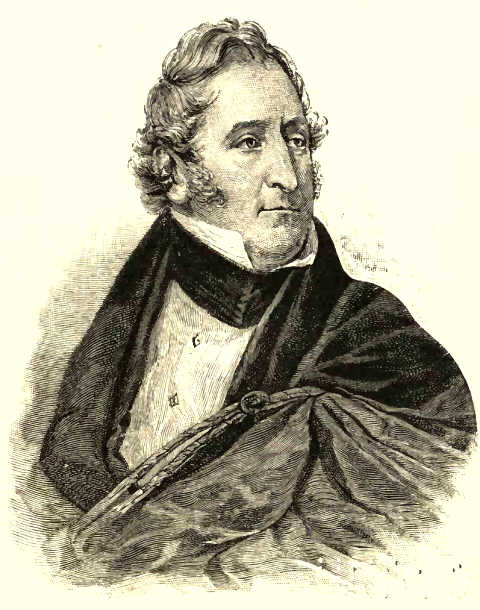
Thomas H. Benton.
Had the Whig Party, while in power from 1849 to 1853, been brave enough
boldly to assume a rational anti-slavery attitude, though it might have
been defeated, as it was in 1852, it would have had a future. The chance
passed unimproved. The temporizing attitude of the party's then leaders
and the known pro-slavery feeling of most of its southern
members--twelve Whigs voting in the House for the repeal of the Missouri
Compromise--proved deadly to the organization, its faithful old
battalions going over in the South to the Democrats, in the North to the
Republicans.
Many Whigs took the latter course by a circuitous route. Ever since the
alien and sedition laws, cry had been raised at intervals against the
too easy attainment of citizenship by the unnumbered immigrants
thronging to our shores, and agitation raised, more or less successful,
to thrust forward "Nativism" or Americanism, with opposition to the
Roman Catholic Church, as an issue in our politics. To such movements
Whigs, as legatees of Federalism, were always more friendly than
Democrats, which was partly a cause and partly a consequence of the
affinity that naturalized citizens all along showed for the Democratic
Party.
Americanism had its greatest run after 1850, when the Whigs saw their
organization going to pieces, and, mistakenly in part, attributed
democratic success to the immigrant vote. A secret fraternity arose,
called the "Know-nothings," from "I don't know," the ever-repeated reply
of its members to inquiry about its nature and doings. "America for
Americans" was their cry, and they proposed to "put none but Americans
on guard." At first pursuing their aims through silent manipulation of
the old parties, by 1854 the Know-nothings swung out as a third party.
From this date they lustily competed with the Republicans for the hosts
of whig and democratic stragglers jostled from their old ranks by the
omnibus bill legislation, the Kansas-Nebraska act, and the "Crime
against Kansas" committed by Pierce and his slavocratic Senate. In 1855
this party assumed national proportions, and worried seasoned
politicians not a little; but having crystallized around no living
issue, like that which nerved Republicanism, it fell like a
rocket-stick, its sparks going over to make redder still republican
fires. Henry Wilson became a Republican from the status of a
Know-nothing; so did Banks, Colfax, and a score of others subsequently
eminent among their new associates. Some had of old been Democrats,
though most had been Whigs.
Notwithstanding many appearances to the contrary, the Democracy had
begun to lose its hold upon the North from the moment of Polk's
nomination in 1844. In that act it showed preference, on the score of
availability, for a small man as presidential candidate. Harrison's
election and Van Buren's defeat in 1840 doubtless had something to do
with this. The same disposition was revealed in 1852, when Pierce was
made candidate. What harmed the party still more was swerving from
strict construction in declaring for the annexation of Texas, which in
this case did not imply enlargement of view in reading the Constitution,
but simply subserviency to the slave power. In this way Van Buren was
alienated and the vote of New York lost in 1848, insuring defeat that
year.
[1856-1860]
This particular breach was pretty well healed, but the evil survived.
Then came the compromise repeal, wherein the Democracy stood by the
South in casting to the winds, the moment it promised to be of service
to the North, a solemn bargain which had yielded the South Florida,
Arkansas, and Missouri as slave States. Northern Democrats, especially
in the rural parts, unwilling longer to serve slavery, drew off from the
party in increasing numbers. Northern States one by one passed to the
opposition. The whole of New England had gone over in 1856, also New
York, Ohio, Michigan, Wisconsin, and Iowa--Buchanan having six votes
outside those of Pennsylvania, where he won, as many believed, by unfair
means. In 1860, New Jersey, Pennsylvania, California, Illinois, Indiana,
Minnesota, and Oregon crossed to the same side.
CHAPTER VII.
THE CRISIS
[1850]
The repeal of the Missouri Compromise was politically a remarkable
epoch. It not only consolidated old anti-slavery men, but cooled, to say
the least, many "silvergray," or conservative Whigs, as well as many
"hards" and "hunkers" among the Democrats. But the slavocrats were blind
to the risk they were running, and grew bolder than ever. There were now
propositions for renewing the foreign slave-trade. Worse black laws were
enacted. There was increased ferocity toward all who did not pronounce
slavery a blessing, prouder domineering in politics, especially in
Congress, and perpetual threat of secession in case the slave power
should fail to have its way.
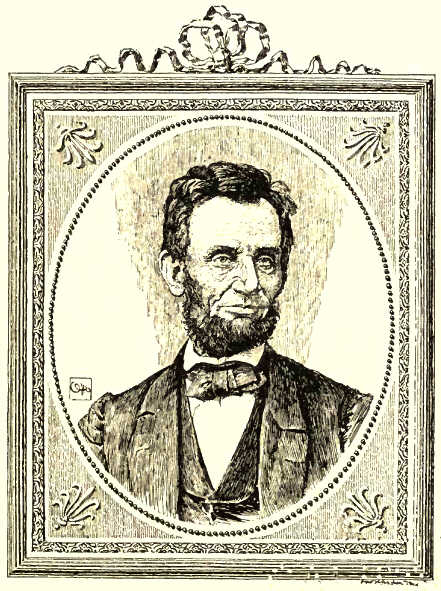
Abraham Lincoln. After a rare photograph in the possession of Noah
Brooks. (Only five copies of this photograph were printed.)
There were also plans for foreign conquest in slavery's behalf, which
received countenance from public and even from national authorities. The
idea seemed to be that the victory and territorial enlargement
consequent upon the Mexican War might be repeated in Central America and
Cuba. The efforts of Lopez in 1850 and 1851 to conquer Cuba with aid
from the United States had indeed been brought to an end through this
adventurer's execution in the latter year by the Cuban authorities.
Pierce put forth a proclamation in 1854, warning American citizens
against like attempts in future. Defying this, the next year William
Walker headed a filibustering expedition to the Pacific coast of
Nicaragua, conquering the capital of that state and setting up a
government which proceeded to re-establish slavery and invite
immigration from the United States. Driven out by a coalition of other
Central American states against him, Walker at once organized a new
raid, and landed at Punta Arenas, Nicaragua, November 25, 1857; but he
was seized by Commodore Paulding of our navy and brought to New York. He
made a similar effort the next year, and another in 1860, when he
captured Truxillo in Honduras, only to be soon overwhelmed, tried and
shot.
[1852]
If the Government at Washington was not openly implicated in any of
these movements, no more, surely, did it heartily deprecate them.
Fillmore's administration had in 1852 declined to enter into an alliance
with Great Britain and France disclaiming intention to secure Cuba. In
1854, inspired by Pierce, our ministers at London, Paris, and Madrid,
met at Ostend and put forth the "Ostend Manifesto." The tenor of this
was that Spain would be better off without Cuba and we with it, and
further, that, if Spain refused to sell, the United States ought as a
means of self-preservation to take that island by force, lest it should
become a second San Domingo. This proposition, like everything else
relating to the great Repeal, was under umbrage in 1856; but in 1858 the
southern Democrats in Congress brought in a bill to purchase Cuba for
$30,000,000, and the democratic platform of 1860 spoke for the
acquisition thereof at the earliest practicable moment, by all
"honorable and just means."
[1854]
Thus an institution, barbarous, anti-democratic, sectional, an
unmitigated curse even to its section, not so much as named in the
Constitution, beginning with apology from all, by the zeal and
unscrupulousness of advocates, the consolidation of political power at
the South, and apathy, sycophancy, divided counsels, and commercial
greed in the North, gradually amassed might, till, at the middle of Mr.
Buchanan's term, every branch of the national Government was its tool,
the Supreme Court included, enabling it authoritatively to mis-read the
Constitution, declare the Union a pro-slavery compact, and act
accordingly. But justice would not be mocked, and, though advancing upon
halting foot, dealt the death-blow like lightning at last.
We have seen the feeble efforts of the old Liberty Party to make head
against slavery, Birney and Earle being its candidates in 1840, Birney
and Morris in 1844. In 1848 these "conscience Free-soilers" were
re-enforced by what have been called the "political Free-soilers" of the
State of New York, led by ex-President Van Buren. This astute organizer,
aware that his defeat in the democratic convention of 1844 had resulted
from southern and pro-slavery influences, led a bolt in the New York
Democracy. His partisans in this were known as the "Barn-burners," while
the administration Democrats were called the "Hunkers." In the
democratic convention of 1848 at Baltimore appeared representatives of
both factions, and both sets were admitted, each with half the state
vote. This satisfied neither side. The Barn-burners called a convention
at Utica in June, and put Van Buren in nomination for the presidency.
The Liberty Party men had the preceding year nominated Hale for this
office, but now, seeing their opportunity, they called a new convention
at Buffalo for August 9, 1848, to which all Free-soilers were invited;
and this convention made Van Buren and Charles Francis Adams its
candidates for President and Vice-President. The platform declared
against any further extension of slavery. The party was henceforth known
as the "Free-soilers," the name coming from its insistence that the
territory conquered from Mexico should forever remain free. Its platform
denounced slavery as a sin against God and a crime against man, and
repudiated the compromise of 1850. It also laid special emphasis upon
the wickedness of the new fugitive slave law, of which it demanded the
repeal. By 1852 the regular Democracy in New York had won back a large
proportion of the Barn-burners or free-soil revolters, so that the
free-soil prospect in this year was not encouraging. Only 146,149
free-soil votes were polled in all the northern states.
[1856]
What quickened this drooping movement into new and triumphant life was
the revocation of the Missouri Compromise. This rallied to the free-soil
standard nearly all the northern Whigs, many old Barn-burners who since
1848 had returned to the democratic fold, and vast numbers of other
anti-Lecompton Democrats. Most of the Know-nothings throughout the North
also joined it, while of course it had in all its anti-slavery measures
the hearty co-operation, directly political or other, of the
Abolitionists. The first national convention of this new party,
fortunately styling itself "Republican," was in 1856. Whig doctrine
early appeared in the party by the demand for protection, internal
improvements, and a national banking system; in fact, Republicanism may
be said to have received nearly entire the whig mantle, as the Whigs did
that of Federalism.
But the living soul and integrating idea of the party was new, the rigid
confinement of slavery and the slave power to their narrowest
constitutional limits. It denounced the repeal of the Missouri
Compromise. In the election of this year, 1856, eleven States chose
Republican electors, viz.: all New England, also New York, Ohio,
Michigan, Iowa, and Wisconsin. Evidently the Democracy had at last found
a foe at which it were best not to sneer. The Dred Scott decision
immensely aided the growth of this new political power, as it was now
quite generally believed in the North that the whole policy of the South
was a greedy, selfish grasping for the extension of slavery.
[1858]
Out of this conviction, apparently, grew the John Brown raid into
Virginia in 1858. John Brown was an enthusiast, whom sufferings from the
Border Ruffians in Kansas, where one of his sons had been atrociously
murdered and another driven to insanity by cruel treatment as a
prisoner, had frenzied in his opposition to slavery. He had dedicated
himself to its extirpation. The intrepid old man formed the purpose of
invading Virginia, and of placing himself with a few white allies at the
head of a slave insurrection that should sweep the State. Friends
in
the North had contributed money for the purchase of arms, and on October
16th, Brown, with fourteen white men and four negroes, seized the United
States Armory at Harper's Ferry. He stopped the railway trains, freed
some slaves, and assumed to rule the town. United States troops were at
once despatched to the scene, when the misguided hero, with his devoted
band, fortified themselves in the engine house, surrendering only after
thirteen of them, including two of Brown's sons, were killed or mortally
wounded. Brown and the other survivors were soon tried, convicted, and
hung. This insane attempt was deprecated by nearly all of all parties;
but the fate of Brown, with his resolute bravery, begot him large
sympathy, and the false assumption of the South that he really
represented northern feeling made his deed helpful to the anti-slavery
movement, of which the Republican Party was now the centre.
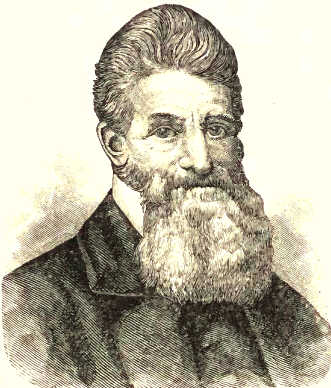
John Brown.
[1860]
Notwithstanding all this the Democracy might still have elected a
president in 1860 had it been united. But it was now desperately at feud
with itself, the cause of this, beautifully enough, lying back in that
very device of Repeal which was intended to make Kansas a slave State
and so to perpetuate the democratic sway. Judge Douglas, and most of the
northern Democrats with him, had insisted so long and earnestly upon the
doctrine of squatter sovereignty that they could not now possibly recede
from it even had they desired to do so. The great majority of them did
not so desire, but sincerely believed in that doctrine as part and
parcel of the true democratic faith. But it was now obvious that the
working out of the Douglas theory was absolutely sure to make free all
the western States henceforth to be formed. This would, of course,
remove the Senate from the domination of slavery. Hence the South was
irrevocably opposed to it, and insisted with all its might upon the
Calhoun-Taney contention that the national Government must protect
slavery in all the Territories to which it pleased to go. In a passage
at arms with Douglas as they were stumping Illinois for the senatorship
in 1858, Lincoln keenly forced upon him the question whether under the
Dred Scott decision any Territory could possibly be kept free from
slavery. "If," said he, "Douglas answers yes, he can never be President;
if no, Illinois will not again elect him senator." Douglas replied in
the affirmative, and, as his antagonist prophesied, became in the South
a doomed man.
The schism was fully apparent when, on April 23d, the democratic
convention of 1860 began its session in Charleston. A majority of the
delegates were for Douglas, voting down the Calhoun-Taney view, though
willing that the party should bind itself to obey the Dred Scott
decision. When the Douglas platform was adopted the delegations from
Alabama, Mississippi, Florida, and Texas, with parts of those from
Louisiana, North and South Carolina, Arkansas, and Delaware, seceded.
Douglas had a majority vote as presidential candidate, but not
two-thirds. The convention adjourned to meet at Baltimore June 18th, and
when it met there Douglas was nominated by the requisite two-thirds
vote. The seceders met at Richmond, June 11th, where, imitating some new
seceders at Baltimore they nominated Breckenridge and Lane. The
so-called Constitutional Union Party also had in the field its ticket,
Bell and Everett, which secured votes from a few persistent Whigs and
Know-nothings still foolish enough to suppose that further clash between
the powers of slavery and freedom could somehow be averted.
The Republicans nominated Abraham Lincoln, of Illinois, and Hannibal
Hamlin, of Maine. Lincoln was already a marked man in his party,
especially in the West, his brilliant joint debate with Judge Douglas
during some months in 1858 having brought out his matchless good sense
and good nature, his rare knowledge of our history and law, and his high
quality as thinker and speaker. Born in Kentucky in 1809, removing to
Indiana in 1816, to Illinois in 1830, reared in extreme poverty and
wholly self-educated, this man had risen by his wits, his sturdy
perseverance and industry, his extraordinary ability, and his proverbial
honesty, to be the acknowledged peer of the "Little Giant" himself. He
began political life a Whig and ably represented that party in the
national Congress from 1847 to 1849, making his voice heard against the
high-handed procedure of the Administration in the Mexican War. But as
with Seward, Greeley, Fessenden, Thaddeus Stevens, Sherman, Dayton,
Corwin, and Collamer, subsequent events had intensified his anti-slavery
feeling, convincing him, as he avowed, that the Union could not
"permanently continue half slave and half free." He was thus drawn to
unite his fortunes with the Republicans. His nomination was received
coolly in the East, where Seward had been preferred; but as men studied
Lincoln's record they were convinced of the wisdom which had made him
the party's leader. He swept New England, New York, New Jersey,
Pennsylvania, Ohio, Indiana, Illinois, Michigan, Iowa, Wisconsin,
California, Minnesota, and Oregon, having 180 electoral votes to
Breckenridge's 72, Bell's 39, and Douglas's 12.
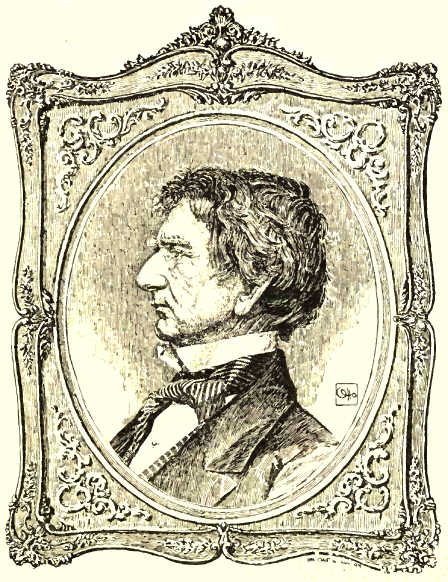
William H. Seward.
From a photograph by Brady.
CHAPTER VIII.
MATERIAL PROGRESS
[1860]
The population of the United States in 1860 was 31,443,321. In spite of
the threatening political complications between 1840 and 1860, these
years were characterized by astonishing economic prosperity. The decade
after 1848 was, indeed, in point of advance in material weal, the golden
age of our history. Between 1850 and 1860, the wealth of the nation
swelled 120 per cent., the value of its farms 103 per cent., its total
manufacturing product 87 per cent., its manufactured export 171 per
cent., its railroad mileage 220 per cent. Making all due allowance for
the rise of prices during the period, this is still a remarkable
exhibit.
The great West continued to come under the hand of civilization. Between
1850 and 1860 our centre of population made a longer stride westward
than during any other decade--from east of the meridian of Parkersburg,
W. Va., to the meridian of Chillicothe, O. Florida and Texas having been
admitted to statehood in 1845, Iowa followed next year, Wisconsin in
1848, California in 1850, Minnesota, which had been an organized
Territory since 1849, in 1858, and Oregon in 1859. Kansas, Nebraska,
Utah, and Washington Territories were organized before 1860. By this
date there were settlements far up the Rio Grande. The Pacific coast was
sought for lands and homes as well as for gold. Fremont's expeditions in
1842, 1844, and 1848 had done much to show people the way thither. In
1853 the Government sent out four different parties to survey suitable
routes for a Pacific railway, a work followed up by three other parties
the next summer. The settlements in Oregon had, by 1845, in places
become dense.
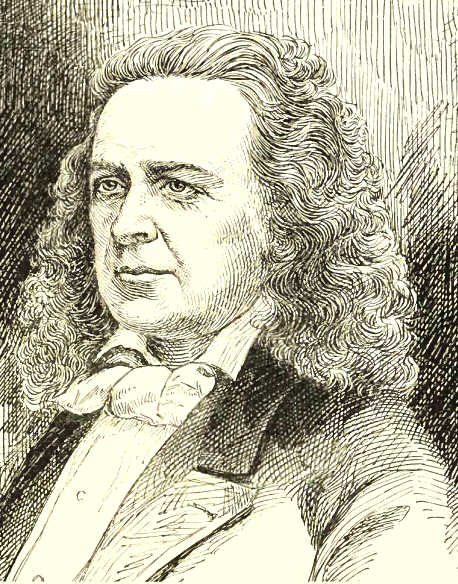
Elias Howe.
Immigration hither was unfortunately checked a little later by Indian
hostilities, the gravest attacks being in 1847 and 1855. In the latter
year Major Haller, leading an exploring party, was surrounded by the
savages and cut off from food and water, only making his escape by a
fight of two days against overwhelming odds. He and his party at last
hewed their desperate way through, losing their entire outfit, besides
one-fifth of their number. The whole territory was harassed by Indians
on the war path, and General Wool had to be sent up from San Francisco
to restore peace. This done, immigration was renewed. A thousand new
inhabitants came to Oregon in 1852, and its northern half was organized
as Washington Territory the following year. The Pacific Mail Steamship
Company had been chartered in 1848, and four years earlier a newspaper
started, the first in English on that coast. Its seat was Oregon City,
its name the Flumgudgeon Gazette.
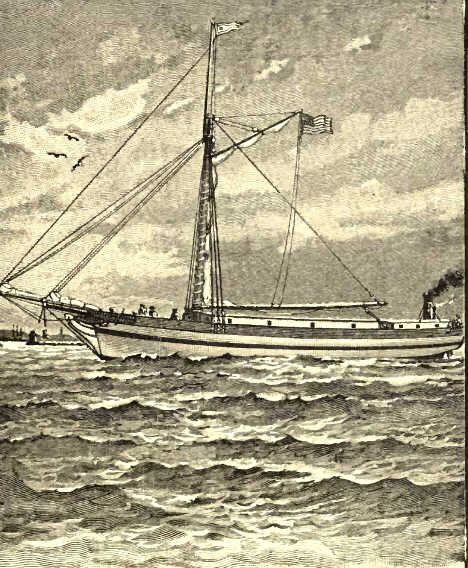
The Vandalia. The Pioneer Propeller On the Lakes.
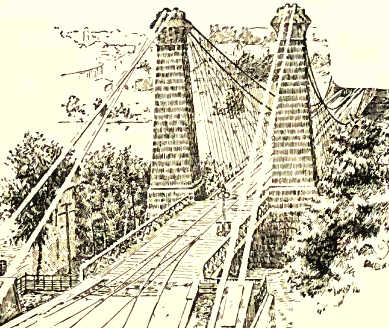
Old Stone Towers of the Niagara Suspension Bridge.
The old West prospered, notwithstanding the drain which it, in common
with the East, experienced in favor of parts farther toward the setting
sun. The first lake propeller was launched at Cleveland in 1847. The
same year the Tribune was started in Chicago. In 1850 the city had its
theatre and its board of trade. The Chicago streets began this year to
be lighted with gas. The first bridge across the Mississippi was built
in 1855 at Minneapolis; that at Rock Island, 1,582 feet long, in 1856.
The Niagara suspension bridge was finished in 1855.
The increase of railways did not at once end the opening of canals. The
Miami Canal, between Cincinnati and Toledo, 215 miles, begun in 1825,
was finished in 1843, and the Wabash and Erie, between Evansville and
Toledo, opened in 1851; but the Middlesex Canal in Massachusetts was, in
1853, abandoned and filled up from the loss of its business to
railroads. In 1857 the Pennsylvania Railroad Company purchased from the
State the canal and railway line from Philadelphia to Pittsburgh, and
soon after extended the railway portion to cover the whole. A traveller
from Boston to the West could get to Rochester by rail in 1841. Next
year he could go on to Buffalo by the same means. In 1842, Augusta, Ga.,
was connected by rail with Atlanta, Savannah with Macon, and the Boston
& Maine Railway finished to Berwick.
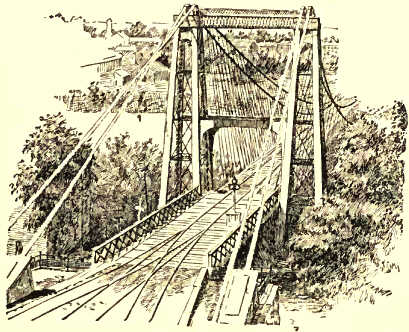
The New Iron Towers of the Niagara Bridge.
The first railway out of Chicago--it was the first in Illinois--was
built in 1850, to Elgin. Chicago had no railway connection with the East
till two years later, when the Michigan Southern was opened. The
Michigan Central was finished soon after the Southern, and the Rock
Island before the end of the year. The Michigan Central had direct
connection east across Canada to Niagara Falls by 1854. In 1856 the
Burlington route reached the Mississippi and the Rock Island went on to
Iowa City. This year witnessed the opening of the first railroad in
California--from Sacramento to Folsom. In 1857 Chicago and St. Louis
were joined by rails, as also the latter city with Baltimore, over the
Parkersburg branch of the Baltimore & Ohio.
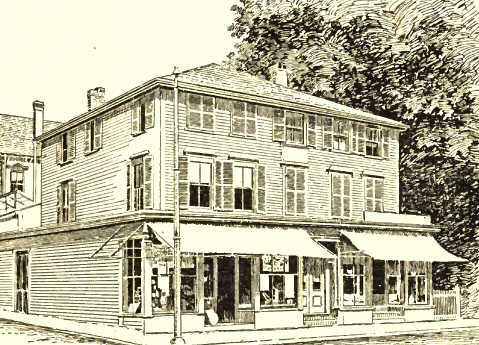
Birthplace of S. F. B. Morse, at Charlestown, Mass. Built 1775.
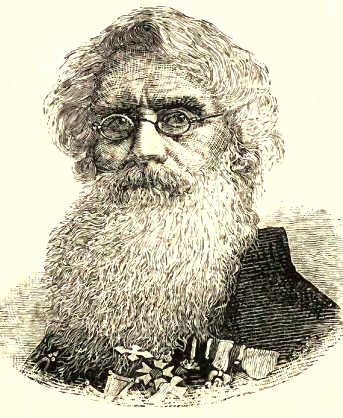
S. F. B. Morse.
We now come to an improvement of which the preceding period knew
nothing, the magnetic telegraph, introduced by Professor Morse in 1844.
In this year Morse secured a congressional appropriation of $30,000 for
a line from Washington to Baltimore. The wires were at first encased in
tubes underground. In spite of the success of the project, further
governmental patronage was refused, the Postmaster-General advising
against it under the conviction that the invention could not become
practically valuable. Morse appealed for aid from private capitalists.
Ezra Cornell, of New York, soon opened a short line in Boston for
exhibition, following this with a similar enterprise in New York City.
The admission fee was twelve and a half cents. Few cared to pay even
this trifle, so that the undertaking was hardly a success in either
city.
Amos Kendall then engaged as Morse's agent, and by dint of great effort
secured subscriptions for a line from New York to Philadelphia, being
obliged to sell the shares for one-half their face value. Incorporation
was secured from the Maryland Legislature, under the first American
charter, for the telegraph business. The line was completed in 1845 to
the Hudson opposite the upper end of Manhattan Island, and an effort
made to insulate the wire and connect with the city along the bottom of
the river. This failed, and for some time messages had to be taken over
in boats. In 1846 the wire was carried on to Baltimore. In the same year
Philadelphia and Pittsburgh were connected by telegraph, New York and
Albany, New York and Boston, Boston and Buffalo. The first line in
California was erected in 1853.
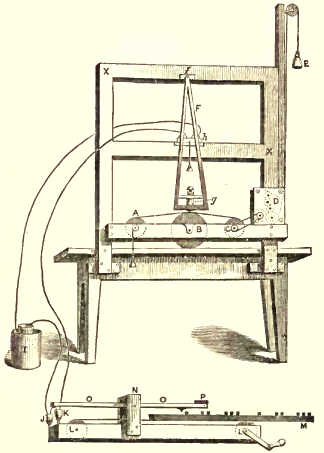
The First Telegraphic Instrument, as exhibited in 1837 by Morse.
In 1850 Hiram Sibley embarked in the telegraph business. He bought the
House patent, and next year organized the New York and Mississippi
Valley Telegraph Company. By 1853 or 1854, some twenty companies had
started, with a capital of $7,000,000--too many for good
management or
high profits. Accordingly, Sibley and Cornell united in buying them up,
and thus formed, in 1856, the Western Union, which Sibley's energy
extended all over the country east of the Rocky Mountains. In 1860 he
went to Washington with a scheme for a transcontinental telegraph line,
and secured from Congress a subsidy of $40,000 for ten years. Just then
the Overland Telegraph Company was started in San Francisco. It and
Sibley united, breaking ground July 1, 1861, and proceeding at the rate
of nearly ten miles of wire per day. On October 25th, telegraph wire
stretched all the way between the two oceans. In 1864 this line was
amalgamated with the Western Union.
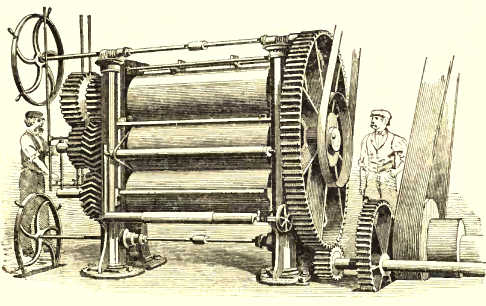
Calenders heated internally by Steam, for spreading India Rubber into
Sheets or upon Cloth, called the "Chaffee Machine."
Still more wonderful, ocean telegraphy was broached and made successful
during these years. Tentative efforts to operate the current under water
were made between Governor's Island and New York City so early as 1842.
A copper wire was used, insulated with hemp string coated with India
rubber and pitch. In 1846 a similar arrangement was encased in lead
pipe. This device failed, and sub-aqueous telegraphy seems to have been
for the time given up.
In 1854 Mr. Cyrus W. Field, of New York, with Peter Cooper and other
capitalists of that city, organized the New York, Newfoundland, and
London Telegraph Company, stock a million and a half dollars, and began
plans to connect New York with St. Johns, Newfoundland, by a cable under
the Gulf of St. Lawrence. Little progress was made, however, till 1857,
when it was attempted to lay a cable across the Atlantic from
Newfoundland. The paying out was begun at Queenstown and proceeded
successfully until three hundred and thirty-five miles had been laid,
when the cable parted. Nothing more was done till the next year in June.
Then, in 1858, after several more unsuccessful efforts, the two
continents were successfully joined. The two ships containing the cable
met in mid-ocean, where it was spliced and the paying out begun in each
direction. The one reached Newfoundland the same day, August 5th, on
which the other reached Valencia, Ireland. No break had occurred, and
after the necessary arrangements had been effected, the first message
was transmitted on August 16th. It was from the Queen of Great Britain
to the President of the United States, and read, "Glory to God in the
highest, peace on earth and good will to men." A monster celebration of
the event was had in New York next day.
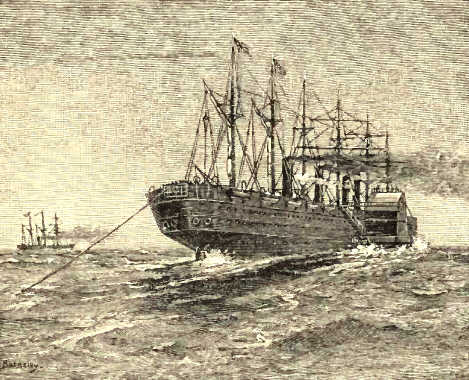
The Great Eastern Laying the Atlantic Cable.
Although inter-continental communication had been actually opened, the
cable did not work, nor did ocean cabling become a successful and
regular business till 1866, when a new cable was laid. This event
attracted the more attention from the fact that the largest ship ever
built was used in paying out the cable. It was the Great Eastern, 680
feet long and 83 broad, with 25,000 tons displacement.
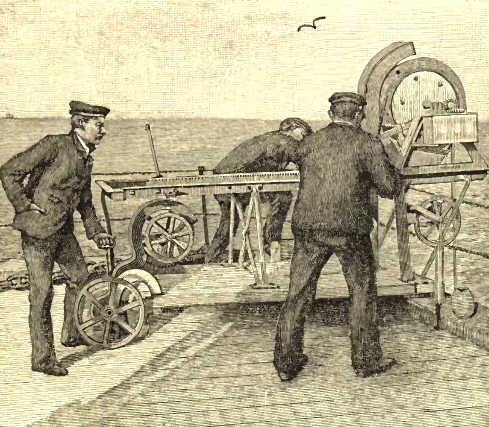
Sounding Machine used by a Cable Expedition.
Street railways became common in our largest cities before 1860, the
first in New England, that between Boston and Cambridge, dating from
1856. Sleeping-cars began to be used in 1858. The express business went
on developing, being opened westward from Buffalo first in 1845. A steam
fire-engine was tried in New York in 1841, but the invention was
successful only in 1853. Baltimore used one in 1858. Goodyear
triumphantly vulcanized rubber in 1844, making serviceable a gum which
had been used in various forms already but without ability to stand
heat. Elias Howe took out his first patent for a sewing machine in 1846,
being kept in vigorous fight against infringements for the next eight
years. The anaesthetic power of ether was discovered in 1844.
Gutta-percha was first imported hither in 1847. The first application of
the Bessemer steel process in this country was made in New Jersey in
1856, the manufacture of watches by machinery begun in 1857,
photo-lithography in 1859. New York had a clearing house in 1853, Boston
in 1855. The petroleum business may with propriety be dated from 1860,
although the existence of oil in Northwestern Pennsylvania had been long
known, and some use made of it since 1826. For several years experiments
had been making in refining the oil. The excellence of the light from it
now drew attention to the value of the product, wells began to be bored
and oil land sold for fabulous prices.
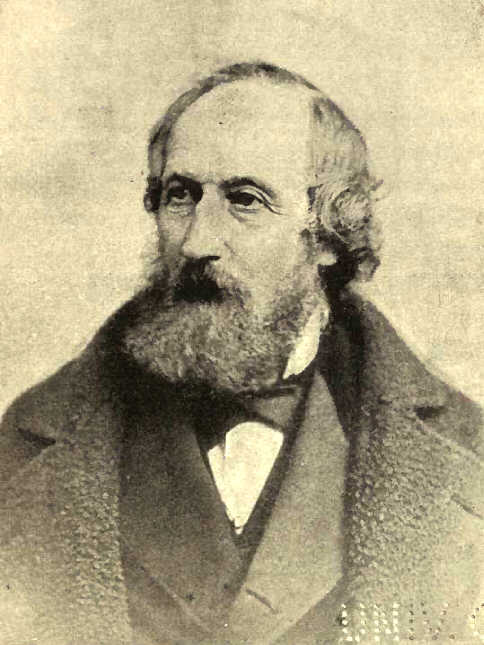
Cyrus W. Field.
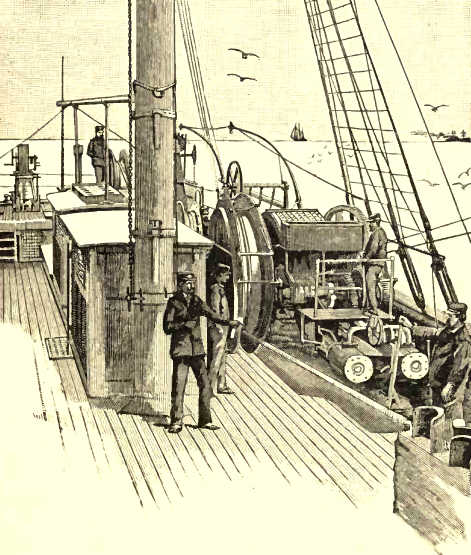
Paying out Cable Gear. From Chart House.
We close this chapter with a word about the painful financial crisis
that swept over the country in the autumn of 1857. Its causes are
somewhat occult, but two appear to have been the chief, viz., the
over-rapid building of railroads and the speculation induced by the
prosperity and the rise of prices incident to the new output of gold.
Interest on the best securities rose to three, four, and five per cent.
a month. On ordinary securities no money at all could be had. Commercial
houses of the highest repute went down. The climax was in September and
October. The three leading banks in Philadelphia suspended specie
payments, at once followed in this by all the banks of the Middle
States, and upon the 13th of the next month by the New York banks.
Manufacturing was very largely abandoned for the time, at least thirty
thousand operatives being thrown out of work in New York City alone.
Prices even of agricultural produce fell enormously. Tramps were to be
met on every road. Easier times fortunately returned by spring, when
business resumed pretty nearly its former prosperous march.
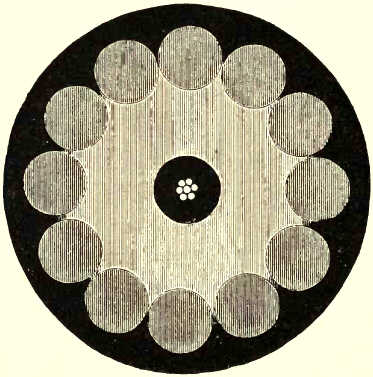
Shore End of Cable-exact size. [About 3.5 inches in diameter.]
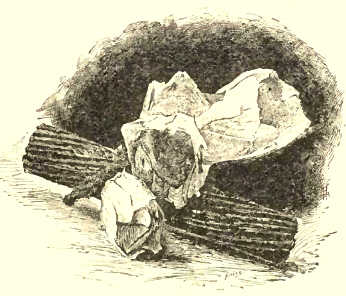
Barnacles on Cable.
PERIOD IV.
CIVIL WAR AND RECONSTRUCTION
1860-1868
CHAPTER I.
CAUSES OF THE WAR
[1861]
It were a mistake to refer the great Rebellion, for ultimate source, to
ambiguity in the Constitution or to the wickedness of politicians or of
the people. It was simply the last resort in an "irrepressible conflict"
of principle--in the struggle for and against the genius of the world's
advance. Economic, social, and moral evolution, resulting in two
radically different civilizations, had enforced upon each section
unfaithfulness to the spirit and even to the letter of its
constitutional covenant. The South was not to blame that slavery was at
first profitable; and if it deemed it so too long and even thought of it
as a good morally, these convictions, however big with ill consequences
to the nation, were but errors of view, not strange considering the then
status of slavery in the world.
The South's pride, holding it to the course once chosen, was also no
indictable offence. Nor could the North on its part be taxed with crime
for its "higher law fanaticism," which was simply the spirit of the age;
or for seeing early what all believe now, that slavery was a blight upon
the land. Much as was "nominated in the bond" of the Constitution,
neither law nor equity forbade free States to increase the more rapidly
in numbers, wealth, and other elements of prosperity; and northern
congressmen must have been other than human, if, seeing this increase
and being in the majority, they had gone on punctiliously heeding formal
obligation against manifest national weal. And when, in 1854, the great
sacred compact of 1820 was set aside by the authority of the South
itself, the North felt free even from formal fetters. All talk of
extra-legal negotiations and understandings touching slavery was now at
an end. The northern majority was at last united to legislate upon
slavery as it would, subject only to the Constitution. The South too
late saw this, and fearing that the peculiar institution, shut up to its
old home, would die, sought separation, with such chance of expansion as
this might yield.
The South had come to love slavery too well, the Constitution too
little. Upon conserving slavery all parties there, however dissident as
to modes, however hostile in other matters, were unconditionally bent.
The chief argument even of those opposing disunion was that it
endangered slavery. Our new government, said Alexander H. Stephens, soon
to be vice-president of the Southern Confederacy, is founded, its
cornerstone rests, upon the great physical, philosophical, and moral
truth, to which Jefferson and the men of his day were blind, that the
negro, by nature or the curse of Canaan, is not equal to the white man;
that slavery, subordination to the superior race, is, by ordination of
Providence, whose wisdom it is not for us to inquire into or question,
his natural and normal condition. As the apostle of such a principle the
South could not but abjure the old establishment, whose genius and
working were inevitably in the contrary direction. Many confessed it to
be the essential nature of our Government, and not unfair treatment
under it, against which they rebelled.
Slavery had also bred hatred of the Union indirectly, by fostering
anti-democratic habits of thought, feeling, and action. "The form of
liberty existed, the press seemed to be free, the deliberations of
legislative bodies were tumultuous, and every man boasted of his
independence. But the spirit of true liberty, tolerance of the minority
and respect for individual opinion, had departed, and those deceitful
appearances concealed the despotism of an inexorable master, slavery,
before whom the most powerful of slave-holders was himself but a slave,
as abject as the meanest." Over wide sections, untitled manorial lords,
"more intelligent than educated, brave but irascible, proud but
overbearing," controlled all voting and office-holding. Congressional
districts were their pocket-boroughs, and they ignored the common man
save to use him. The system grew, instead of statesmen, sectionalists,
whom love for the "peculiar institution" rendered callous to national
interests.
The vigorous secession movements in the South at once after Lincoln's
election, raised a question of the first magnitude, which few people at
the North had reflected upon since 1833, viz., whether or not
non-revolutionary secession was possible. Almost unanimously the North
denied such possibility, the South affirmed it. This was at bottom
manifestly nothing but the old question of state sovereignty over again.
The South held the Union to be a state compact, which the northern
parties thereto had broken. To prove the compact theory no new proof was
now adduced. Rather did the southern people take the assertion of it as
an axiom, with a simplicity which spoke volumes for the influence of
Calhoun and for the indoctrination which the South had received in 1832.
Not alone Calhoun but nearly every other southerner of great influence,
at least from the day of the Missouri Compromise, had been inculcating
the supreme authority of the State as compared with the Union. The
southern States were all large, and, as travelling in or between them
was difficult and little common, they retained far more than those at
the North each its original separateness and peculiarities. Southern
population was more fixed than northern; southern state traditions were
held in far the deeper reverence. In a word, the colonial condition of
things to a great extent persisted in the South down to the very days of
the war. There was every reason why Alabama or North Carolina should,
more than Connecticut, feel like a separate nation.
This intense state consciousness might gradually have subsided but for
the deep prejudices and passions begotten of slavery and of the
opposition it encountered from the North. Their resolution, against
emancipation led Southerners to cherish a view which made it seem
possible for them as a last resort to sever their alliance with the
North. It was this conjunction of influences, linking the slave-holder's
jealousy and pride to a false but natural conception of state
sovereignty, which created in southern men that love of State, intense
and sincere as real patriotism, causing them to look upon northern men,
with their different theory, as foes and foreigners.
A very imposing historical argument could of course have been built up
for the Calhoun theory of the Union. The Union emerged from the
preceding Confederacy without a shock. Most who voted for it were
unaware how radical a change it embodied. The Constitution, one may even
admit, could not have been adopted had it then been understood to
preclude the possibility of secession. Doubtless, too, the gradual
change of view concerning it all over the North, sprung from the
multiplication of social and economic ties between sections and States,
rather than from study of constitutional law. We believe that the
untruth of the central-sovereignty theory in no wise follows from these
admissions, and that its correctness might be made apparent from a
plenitude of considerations.
Champions of the northern side deemed it the less necessary to expatiate
upon this question, since, admitting the South's basal contention, the
right in question depended upon sufficiency of grievance. As, in the
South's view, the case was one of sovereigns one party of whom, without
referee, was about to break a compact without the other's consent, the
adequacy of the grievance should, to excuse the step, have been
absolutely beyond question. On the contrary it was subject to the
gravest question.
The South's only significant indictment against the North was the one
concerning the personal liberty laws. Moderates like Stephens, indeed,
stoutly condemned this plea for secession as insufficient; but,
believing in the State as sovereign, they had perforce to yield, and
they became as enthusiastic as any when once this "paramount authority"
had spoken. "Fire-eaters," at first a small minority, saw this advantage
and worked it to the utmost. On its complaint touching the personal
liberty legislation the South's case utterly broke down, theorizing the
Union into a rope of sand, not "more perfect" but far less so than the
old, which itself was to be "perpetual." According to the Calhoun
contention States were the parties to a pact, and it was a good way from
clear that any northern State as such, even by personal liberty
legislation, had broken the alleged pact. The liberty laws were innocent
at least in form, and at worst had never been endorsed in any state
convention. Buchanan himself testified that the fugitive slave law had
been faithfully executed, and its operation is well known never to have
been resisted by any public authority.
It was suspicious that no State ventured upon secession alone. It was
equally remarkable that the Gulf States were the readiest to go, and
made most of the personal liberty laws as their pretext, accounting this
cry, as was ingenuously confessed, a necessary means for holding the
border States solidly to the southern cause. Weak enough, indeed, was
the complaint of "consolidationist" aggression, of which
certainly no
party to the so-called pact was or could have been guilty. But the deeps
of folly were sounded when northern "persecution" of the South was
mentioned, or Lincoln's election as threat of such. This was simply the
election as President, in a perfectly constitutional way, of a citizen,
honest and unambitious, who was pledged against touching slavery in
States. Having become President, he was unable to procure minister, law,
treaty, or even adequate guard for his own person save by the consent of
the party hitherto in power. Lincoln had failed of a popular majority by
a million. Both Houses of Congress were against him at the time of his
election, and, but for the absence of southern members, they would, it
is likely, have continued so through his entire term. It was the South's
bad logic on these points which gave the war Democrats their excellent
plea for drawing sword on the northern side.
But even supposing secession technically justifiable, how strange that
it should have been judged rational, prudent, or in the long run best
for the South itself. Could aught but frenzy have so drowned in
Americans the memories of our great past; or launched them upon a course
that must have ended by Mexicanizing this nation, wresting from it the
lead in freedom's march, and crushing out, in the breast of struggling
patriotism the world over, all hope of government by and for the people!
The South ought at least to have spared itself. Either its alleged
horror at the advance of central-sovereignty sentiment at the North was
sheer pretence, or it should have been certain that this section would
not hesitate, as Buchanan so illogically did, to coerce "rebellious"
state-bodies. If the North believed the totality of the nation to be the
"paramount authority," Lincoln would surely imitate Jackson instead of
Buchanan, and in doing so he would not seek military support in vain.
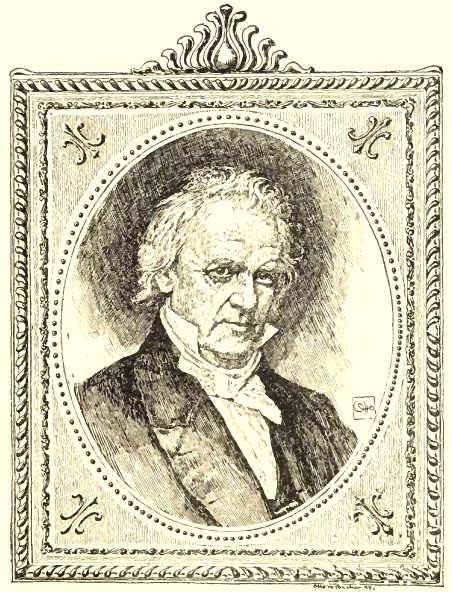
James Buchanan. From a photograph by Brady.
Quite as sure, too, must the final result have appeared from the census
of 1850, had people been calm enough to read this. By that census the
free States had a population fifty per cent. above the population of the
slave states, slaves included, and the disparity was rapidly increasing.
Their wealth was even more preponderant, being, slaves apart, nearly one
hundred per cent. the larger. Their merchant tonnage was five times the
greater--even young inland Ohio out-doing old South Carolina in this,
and the one district of New York City the whole South. The North had
three or four times the South's miles of railway, all the sinews of war
without importation, and mechanics unnumbered and of every sort. And
while champions of the Union would fight with all the prestige of law,
national history and the status quo on their side, Europe's aid to the
South, or even that of the border slave States, was more than
problematical, as was a successful career for the Confederacy in case
its independence should chance to be won. Events proved that the very
defence of slavery had best prospect in the Union, and it seems as if
this might have been foreseen by all, as it actually was by some.
CHAPTER II.
SECESSION
[1861]
Secession was no new thought at the South. It lurked darkly behind the
Kentucky and Virginia resolutions of 1798-99. It was brought out into
broad daylight by South Carolina in the nullification troubles of 1832.
"Texas or disunion!" was the cry at the South in 1843-44. In 1850 South
Carolina declared herself ready to secede in the event of legislation
hostile to slavery. Two years later the same State solemnly affirmed
that it had a right to secede, but that, out of deference to the wishes
of the other slave States, it forbore to exercise such right.
It must be admitted that in early years the North had helped to make the
thought of secession familiar. In 1803, in view of the great increase of
southern territory by the Louisiana Purchase, and again in 1813, when
New England opposition to the war with England culminated in the
Hartford Convention, there had been talk of a separate northern
confederacy. But from that time on the thought of disunion died out at
the North, while the South dallied with it more and more boldly. During
the presidential campaign of 1856, threats were made that if Fremont,
the republican candidate, should be elected, the South would leave the
Union. In October of that year a secret convention of southern governors
was held at Raleigh, N. C., supposed to have been for the purpose of
considering such a contingency. Governor Wise, of Virginia, who called
the convention, afterward proclaimed that had Fremont been chosen he
would have marched to Washington at the head of 20,000 troops, seized
the Capitol, and prevented the inauguration. This threatening attitude
in 1856 may have been chiefly an electioneering device; but during the
next four years the gulf between North and South widened rapidly, and
the southern leaders turned more and more resolutely toward secession as
the remedy for their alleged wrongs.
No sooner had the presidential campaign of 1860 begun than deep
mutterings foretold the coming storm. "Elect Lincoln, and the South will
secede!" cried the campaign orators of the South, while the halls of
Congress rang with threats similar in tenor. As the campaign went on and
republican success became probable, the southern leaders began to nerve
up their hosts for the conflict. In October the governor and congressmen
of South Carolina, with other prominent politicians, met and unanimously
resolved that if Lincoln should win, the Palmetto State ought to
renounce the Union. Similar meetings were held in Georgia, Alabama,
Mississippi, and Florida. Governor Gist sent a confidential circular to
the governors of all the cotton States declaring that South Carolina
would secede with any other State, or would make the plunge alone if
others would promise to follow. The governors of Florida, Alabama, and
Mississippi replied that their States would certainly do this. Georgia
proposed to wait for some overt act by the National Government. North
Carolina and Louisiana, it was learned, would probably not go out at
all.
But the enthusiasts in South Carolina had got all the encouragement they
wanted, and bided their time. Their time was at hand. The presidential
election fell on November 6th. Next day the tidings flashed over the
land that Abraham Lincoln had been elected President by the vote of a
solid North against a solid South. The wires had scarcely ceased to
thrill with this message of death to slavery-extension, when South
Carolina sounded a trumpet-call to the South. Her Legislature ordered a
secession state convention to meet in December, issued a call for 10,000
volunteers, and voted money for the purchase of arms. Federal
office-holders resigned. Judge Magrath, of the United States District
Court, laid aside his robes, declaring, "So far as I am concerned, the
temple of Justice raised under the Constitution of the United States is
now closed." Militia organized throughout the State. The streets of
Charleston echoed nightly with the tramp of drilling minute-men.
Secession orators harangued enthusiastic crowds. Hardly a coat but bore
a secession cockade. November 17th, the Palmetto flag was unfurled in
Charleston. It was a gala day. Cannon roared, bands played the
Marseillaise, and processions paraded the streets bearing such mottoes
as "Let's Bury the Union's Dead Carcass!" "Death to All Abolitionists!"
The whole South was beside itself with excitement. One State after
another assembled its convention to decide the question of secession.
Even the Georgia Legislature, within a week after the election of
Lincoln, voted $1,000,000 to arm the State.
The South Carolina convention met at Charleston, and on December 20th
unanimously adopted an ordinance declaring:
"The union now subsisting between South Carolina and other States, under
the name of the United States of America, is hereby dissolved."
This action was hailed with wildest enthusiasm. Huge placards--"The
Union is Dissolved!"--were posted throughout the city, while the clang
of bells and the boom of cannon notified the country round. The
sidewalks were thronged with ladies wearing secession bonnets made of
cotton with palmetto decorations. A party of gentlemen visited the tomb
of Calhoun, and there registered their vows to defend the southern cause
with their fortunes and lives. In the evening the convention marched to
the hall in procession, and formally signed the revolutionary ordinance.
The chairman then solemnly proclaimed South Carolina an "independent
commonwealth." The little State, whose white population was less than
300,000, began to play at being a nation. The governor was authorized to
appoint a cabinet and receive foreign ambassadors, and the papers put
information from other parts of the country under the head of "foreign
news."
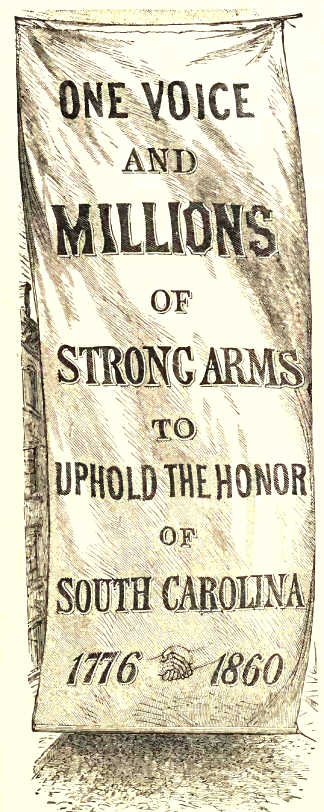
Street Banner in Charleston.
"One voice and millions of strong arms to uphold the honor of South
Carolina 1776-1860"
The secession of South Carolina was greeted with joy in most of the
other slave States. Montgomery and Mobile, Ala., each fired one hundred
guns. At Richmond, Va., a palmetto banner was unfurled, while bells,
bonfires, and processions celebrated the event all over the South. The
other cotton States, spurred on by the bold deed of South Carolina,
rapidly followed her lead. Mississippi seceded January 9th, Florida the
10th, Alabama the 11th, Georgia the 19th, Louisiana the 26th, Texas
February 1st.
It is probable that only in South Carolina, Mississippi, and Florida
were the majority of whites in favor of secession. The South was after
all full of Union sentiment. The ordinance of secession proceeded in
each State from a convention, and the election of delegates to this
witnessed the earnest work. The noble efforts of those Union men in
their fierce struggle have never yet been appreciated. But they fought
against great odds, and were inevitably overborne. The opposition was
organized, ably led, and white-hot with zeal. The political power and
the wealth of the South lay in the hands of the secessionists. The
clergy threw their weight on that side, preaching that slavery, God's
ordinance, was in danger. Union proclivities were crushed out by force.
Vigilance committees were everywhere on the alert. In the rougher States
of the Southwest abolitionists were tarred and feathered. Some were
shot. In all the States Union men were warned to keep quiet or leave the
South. One of the most powerful agents of intimidation was the Knights
of the Golden Circle, a vast secret society which extended throughout
the southern States.
Yet, in spite of all, the vote was close even in several of the cotton
States. The Georgia people wanted new safeguards for slavery, but did
not at first desire secession. Alexander H. Stephens, who headed the
anti-secession movement, declared that Georgia was won over to take the
fatal step at last only by the cry, "Better terms can be made out of the
Union than in it." Even then the first vote for secession stood only 165
to 130. In Louisiana the popular vote for convention delegates was
20,000 for secession and 17,000 against.
The border States held aloof. Kentucky and Tennessee refused to call
conventions. So, for long, did North Carolina. The convention of
Virginia and of Missouri each had a majority of Union delegates. When
the Confederate Government was organized in February, only seven of the
fifteen slave States had seceded. Their white population was about
2,600,000, or less than half that of the entire slave region. But
Arkansas and North Carolina were soon swept along by the current, and
seceded in May. Virginia and Tennessee were finally carried (the former
in May, the latter in June) by the aid of troops, who swarmed in from
the seceded States, and turned the elections into a farce. Unionists in
the Virginia Convention were given the choice to vote secession, leave,
or be hanged. Missouri, Kentucky, Delaware, and Maryland resisted all
attempts to drag them into the Confederacy, though the first two, after
the United States began to apply force, appeared neutral rather than
loyal.
The seizure of United States property went hand in hand with secession.
Most of the government works were feebly garrisoned, and made no
resistance. By January 15th the secessionists had possession of arsenals
at Augusta, Ga., Mount Vernon, Ala., Fayetteville, N. C, Chattahoochee,
Fla., and Baton Rouge, La., of forts in Alabama and Georgia, of a
navy-yard at Pensacola, Fla., and of Forts Jackson and St. Philip,
commanding the mouth of the Mississippi. At one arsenal they found
150,000 pounds of powder, at another 22,000 muskets and rifles, besides
ammunition and cannon, at another 50,000 small arms and 20 heavy guns.
The whole South had been well supplied with military stores by the
enterprising foresight of J. B. Floyd, of Virginia, Buchanan's Secretary
of War, who had sent thither 115,000 muskets from the Springfield
arsenal alone.
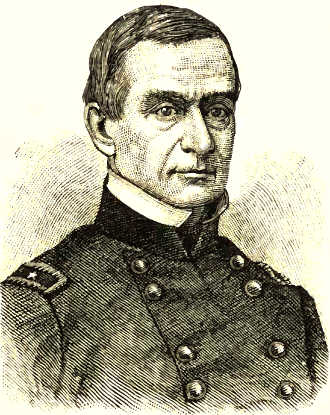
Major Robert Anderson.
Fort Moultrie, in Charleston harbor, was held by Major Robert Anderson,
of Kentucky, with a garrison of some seventy men. On December 27th the
whole country was thrilled, and the South enraged, by the news that on
the previous night Anderson had secretly transferred his whole force to
Fort Sumter, a new and stronger work in the centre of the harbor,
leaving spiked cannon and burning gun-carriages behind him at Moultrie.
The South Carolina militia at once occupied the deserted fortress with
the other harbor fortifications, and began to put them into a state of
defence. At Pensacola, Fla., Lieutenant Slemmer, by a movement similar
to Anderson's, held Fort Pickens.
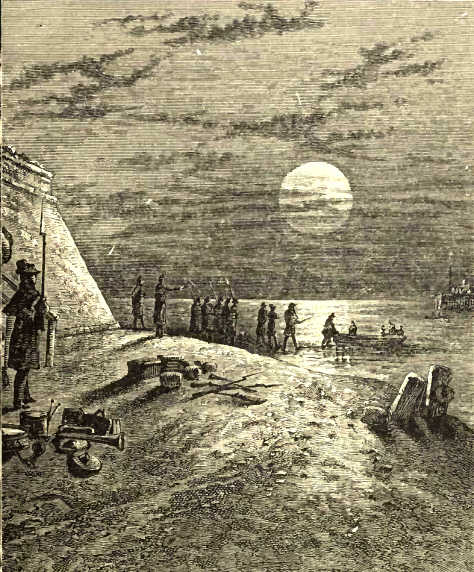
Major Anderson removing his Forces from Fort Moultrie to Fort Sumter,
December 26, 1861.
The seizure of government property went on through January and February.
In Louisiana all the commissary stores were confiscated, and the revenue
cutter McClelland surrendered. The mint at New Orleans, containing over
half a million in gold and silver, was seized. More than half of the
regular army were stationed in Texas, under General Twiggs. In February,
at the demand of a secessionist committee of public safety, he
surrendered his entire force, together with eighteen military posts. The
troops were sent to a Gulf port and there detained.
This wholesale seizure of government property, worth some $20,000,000,
has brought down upon the South much scathing rebuke. The conduct of
Floyd, stabbing his country under the cloak of a cabinet office, cannot
be too strongly condemned; but with the seceding States the case was
different. Having (so they thought) established themselves as
independent republics, they could not allow the military works within
their borders to remain in the hands of a foreign power. As to the
Government's property right, they recognized it, and proposed to pay
damages. The provisional constitution of the Confederacy, adopted in
February, provided for negotiations to settle the claim of the United
States.
The southern leaders were not more anxious to get the slave States out
of the Union than to get them into a grand Southern Confederacy. Early
in January a caucus of secession congressmen was held at Washington, and
arrangements made for a constitutional convention.
February 4, 1861, delegates from the States which had left the Union met
at Montgomery, Ala., and formed themselves into a provisional Congress.
A temporary government, styled "The Confederate States of America," was
soon organized. Jefferson Davis, of Mississippi, was chosen President by
the Congress, and Alexander H. Stephens, of Georgia, Vice-President.
Davis was born in Kentucky in 1808. He graduated at West Point, fought
as colonel in the Mexican war, served three terms as congressman from
Mississippi, the last two in the Senate, and was Secretary of War under
Pierce. After Calhoun's death, in 1850, he became the most prominent of
the ultra southern leaders. The new President was brought from Jackson,
Miss., to Montgomery by a special train, his progress a continual
ovation. Cheering crowds gathered at every station to see and hear him.
February 18th Davis was inaugurated. In his address, which was calm and
moderate in tone, he declared that reunion was now "neither practicable
nor desirable;" he hoped for peace, but said that if the North refused
this, the South must appeal to arms, secure in the blessing of God on a
just cause.
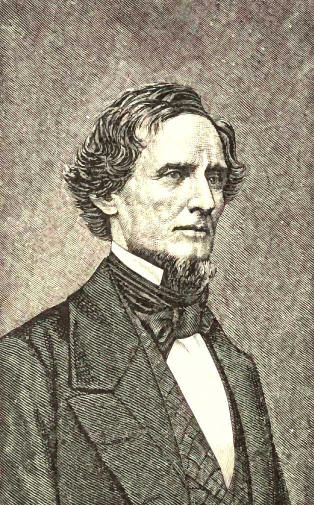
Jefferson Davis.
The Confederate President was intrusted with very large powers,
including supreme control of military affairs. He was authorized to
muster into the service of the central government the regiments which
had been forming in the various States. A call was issued for 100,000
volunteers, and provision made for organizing a regular army. President
Davis appointed a cabinet, with state, treasury, war, navy, and
post-office departments. Robert Toombs, of Georgia, a rabid
secessionist, became Secretary of State.
March 11th the Confederate Congress adopted a permanent constitution. It
reproduced that of the United States, with some important changes. State
sovereignty was recognized in the preamble, which read, "We, the people
of the Confederate States, each State acting in its sovereign and
independent character," etc. Slavery was called by name, and elaborate
safeguards fixed for it in the States and Territories. Slave-trade from
beyond the sea, or with states not in the Confederacy, was, however,
prohibited. Protective tariffs were absolutely forbidden. The president
and vice-president were to serve six years, and the former could not be
re-elected. Some valuable features were inserted. Members of the cabinet
might discuss matters pertaining to their departments in either house of
congress. The president could veto one part of an appropriation bill
without killing the whole, and was required to lay before the senate his
reasons for the removal of any officers from the civil service.
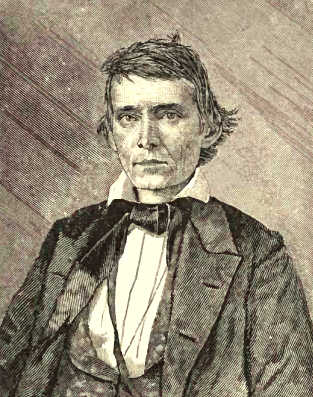
Alexander H. Stephens.
By the last of April all the seceded States had ratified this
constitution. The other slave States were taken in as fast as they
withdrew from the Union. The Southern Confederacy, now fairly launched,
set sail over strange seas upon its short but eventful voyage. At the
start the hopes of those it bore rose high. Few believed that the North
would dare draw sword. Even if it should, the southern heart, proud and
brave, felt sure of victory. King Cotton would win Europe to their side.
Peace would come soon. Visions of a glorious future dazzled the
imaginative mind of the South. A vast slave empire, founded on the
"great physical, philosophical, and moral truth" that slavery is the
"natural condition," of the inferior black race, would spread encircling
arms around the Great Gulf, swallowing up the feeble states of Mexico,
and rise to a wealth and glory unparalleled in the history of nations.
CHAPTER III.
THE NORTH IN THE WINTER OF 1860-61
[1860-1861]
At the beginning of the secession movement the North slumbered and
slept. Even South Carolina's withdrawal from the Union caused little
alarm. "She will be glad enough to come back before long," prophesied
many. As the revolution progressed there was a gradual awakening, but
division of opinion paralyzed action. Ultra Abolitionists, with a few
others, urged that the South be let go in peace. Most Republicans
favored the preservation of the Union by force of arms if necessary; but
nearly all Democrats, with many Republicans, wished for compromise. Of
the latter class a few prayed the prodigals to return on their own
terms. More proposed a rigid enforcement of the fugitive slave law, the
repeal of personal liberty legislation, and acquiescence in the Dred
Scott decision, with all future like decrees of the Supreme
Court. This
may be called the northern-democratic position. The most pronounced
Republicans, as Seward and Stanton, would gladly have voted to
re-enforce the Constitution's guarantee to slavery in the slave States.
Throughout the North the feeling was strong against all efforts at
coercion. Most democratic papers and many republican ones insisted
loudly that use of arms was not to be mentioned, and that the South must
be conciliated. A democratic convention met at Albany in January, to
protest against forcible measures. The sentiment that if force were to
be used it should be "inaugurated at home," here evoked hearty response.
There were signs of even a deeper disaffection. An ex-governor of New
Jersey declared that his State would join the Confederacy. Mayor Wood,
of New York, proposed that if the Union were broken up, his city should
announce herself an independent republic.
At Washington matters were still worse. President Buchanan, loyal but
weak, feared to lift a finger. In his December message to Congress, he
insisted that a State had no right to secede, but that the United States
had no power to coerce a State which should secede. A majority of his
cabinet were southern men, three of them zealous secessionists. His most
intimate friends in Congress were southerners. These surrounded the
vacillating Chief Magistrate, and paralyzed what little energy was in
him, meanwhile taking advantage of his inaction to launch the
Confederacy. Now and then, spurred on by loyal old General Scott and by
the Union members of his cabinet, the President tried to break away from
the toils which the conspirators had spun around him. The Star of the
West was secretly sent with supplies and recruits to re-enforce Fort
Sumter. But Secretary Thompson warned South Carolina, and when the
vessel arrived off Charleston, January 9th, hostile batteries fired upon
her and forced her out to sea again. Another plan to relieve the fort
was half formed, but came to nothing. Buchanan's term was on the point
of expiring, and he sat supinely looking on while the disruption of the
Union proceeded apace.
The northern side in Congress showed little wisdom or spirit. Most
northern congressmen truckled to the South or wasted their energies in
fruitless attempts at compromise. Both houses, each by more than a
two-thirds majority, recommended a constitutional amendment depriving
Congress forever of the power to touch slavery in any State without the
consent of all the States. In December the venerable Crittenden, of
Kentucky, laid before the Senate his famous Suggestions for Compromise.
These, besides embodying the above amendment, restored the Missouri
Compromise, let each new State decide for itself whether it would be
slave or free, and forbade Congress to abolish slavery in the District
of Columbia or interfere with the inter-state transportation of slaves.
The United States was to pay for all fugitives whose capture should be
successfully prevented, and slaves as slaves could be carried through
free States. This measure, before Congress all winter, was finally lost
only for lack of southern votes.
A peace congress, called by Virginia, met at Washington in February.
Most of the northern States were represented and all the southern which
had not seceded. It sat for three weeks, and adopted resolutions
identical in substance with the Crittenden Compromise. These dangerously
large offers of concession, mainly well meant, happily proved useless.
The South had gone too far. She did not want compromise, but was bent
upon setting up a slave empire.
Mr. Lincoln arrived safely in Washington on February 23d, having eluded
a rumored plot to assassinate him in Baltimore. He accomplished this by
assuming a slight disguise and taking an earlier train than the one in
which he had been announced to go. He was duly inaugurated on March 4th.
In his inaugural he disclaimed all purpose to interfere with slavery in
the slave States, yet denied the right of secession, and proposed to
regain and hold the property and places belonging to the United States
in all parts thereof. There would be no bloodshed, he said, unless it
were forced upon the Government. "In your hands, my dissatisfied
fellow-countrymen," so ran his memorable words, "in your hands, not in
mine, is the momentous issue of civil war. You can have no conflict
without being yourselves the aggressors. We are not enemies, but
friends." This message, held out as an olive branch, the South denounced
as a menace. Some northern papers condemned it as the "knell and requiem
of the Union." But the general feeling it evoked at the North was one of
rejoicing. People believed that a hand both moderate and firm had at
length seized the helm.
The new President stood faced by an herculean task. Congress was not yet
fully purged of traitors, while Washington still swarmed with their
friends and agents. Floyd's treachery had tied Lincoln's hands. All the
best munitions of war had been sent south. Of the rifled cannon
belonging to the United States not one was left. Only a handful of
regular troops were within call, and the resignations of their officers
came in daily. The plight of the navy and treasury was no better.
Amazing coolness and the absurd prejudice against coercing States
largely possessed even the loyal masses. The attack on Sumter was thus a
god-send.
April 8th, Governor Pickens received notice from President Lincoln that
an attempt would be made to provision that fort. Thereupon General
Beauregard, who had left the United States army to take charge of the
fortifications at Charleston, was ordered by President Davis to demand
its evacuation. Major Anderson replied that they should be starved out
by the 15th, and would leave the fort then unless his Government sent
supplies. This answer was held unsatisfactory, and at 3.20 on the
morning of April 12th Beauregard notified Anderson that his batteries
would open fire in one hour.
Fort Sumter stood on an artificial island at the entrance of the harbor.
It was pentagonal in shape, the walls of brick, eight feet thick and
forty feet high. The parapet was pierced for 140 guns, but only 48 were
in condition for use. The garrison, including some 40 workmen and a
band, numbered 128. Surrounding the fort on all sides except toward the
sea, and distant from 1,300 to 2,500 yards, 19 Confederate batteries
were in position, mounting 47 cannon and mortars, and manned by 3,000 or
4,000 volunteers. These works were provided with bomb-proofs made of
railroad iron or of palmetto logs and sand.
The wharves, roofs, and steeples of Charleston were black with expectant
crowds, straining their eyes down the harbor where the silent castle
loomed up through the dim morning light. Boom! From a mortar battery to
the south a bombshell rises high into the air, describes its graceful
trajectory and falls within Sumter's enclosure. It is the signal gun.
One battery after another responds, until in less than an hour the
stronghold is girt by an almost continuous circle of flashing artillery.
Shells scream through the air and explode above the doomed work, and
great cannon-balls bury themselves in the brick walls. Still Sumter
speaks not. Anderson is waiting for daylight. About six o'clock he
breakfasts his garrison on pork and water, the only provisions left. An
hour later the embrasures are opened, the black guns run out, and Sumter
hurls back her answer to the voice of rebellion. The bombs making it
unsafe to use the barbette cannons of the open rampart, Anderson was
confined to his twenty-one casemate pieces, mostly of light calibre. The
fire was kept up briskly all the morning. Sumter stood it well, but did
little damage to the opposing batteries. At sunset the guns of both
sides became silent, but the mortars maintained a slow fire through the
night.
Early next morning the cannonade opened afresh, and in the course of the
forenoon hot shot set fire to Sumter's wooden barracks. The flames soon
got beyond control; the powder magazine had to be closed; and the heat
and smoke became so stifling that the garrison was forced, in order to
avoid suffocation, to lie face downward upon the floor, each man with a
wet cloth at his mouth. Powder was at last exhausted. About one o'clock
the flag was shot away. It was immediately raised again upon a low
jury-mast, but could not be seen for the smoke, and Beauregard sent to
ask if Anderson had surrendered. The latter offered to evacuate upon the
terms named before the bombardment, to which Beauregard agreed, and all
firing ceased. The next day at noon, after a salute of fifty guns to
their flag, Major Anderson and his men evacuated the scene of their
heroism, and soon after took passage for New York.
The disunion leaders had rightly calculated that an open blow would
bring the border slave States into the Confederacy; but they had not
anticipated the effect of such a deed beyond Mason and Dixon's line.
When it was known that the old flag had been fired upon, a thrill of
passionate rage electrified the North from Maine to Oregon. Then was
witnessed an uprising unparalleled in our history if not in that of
mankind. From every city, town, and hamlet, loud and earnest came the
call, "The Union must be preserved! Away with compromise! Away with
further attempts to conciliate traitors! To arms!" Slavery might do all
else, so little did most northerners yet feel its evil, but it could not
rend the Union. Pulpit, platform, and press echoed with patriotic cries.
Everywhere were Union meetings, speeches, and parades. Union badges
decked everyone's clothing, and the Stars and Stripes were kept unfurled
as only on national holidays before. In New York City a mass-meeting of
two hundred thousand declared for war. The New York Herald changed its
sneer to a war-blast. Party lines were thrown down. Democrats like
Butler, Cass, and Dickinson were in the Union van. Senator Douglas,
lately Lincoln's antagonist, and at first strongly opposed to coercion,
went through the West arousing the people by his patriotic eloquence.
"There can be no neutrals now," were his words, "only patriots and
traitors."
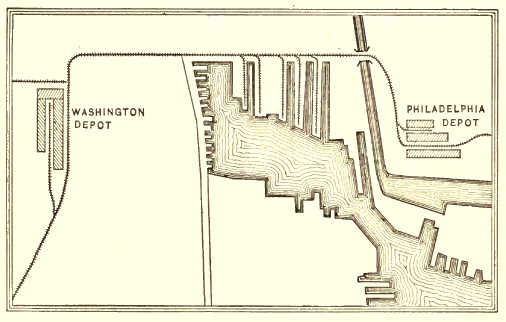
Route of the Sixth Massachusetts Troops through
Baltimore.]
April 15th, President Lincoln issued a call for seventy-five thousand
volunteers, and each free State responded with twice its quota.
Enlisting offices were opened in every town and hamlet, and the roll of
the drum and the tramp of armed men with faces set southward were heard
all over the North. First to march was the Sixth Massachusetts Regiment.
Forming on Boston Common it took cars for Washington on April 17th,
reaching Baltimore on the morning of the 19th.
Maryland was trembling in the balance between Union and disunion. A
determined disunionist minority was working with might and main to drag
the State into secession. Baltimore was white-hot with southern zeal,
determined that the Bay State troops should never reach Washington
through that metropolis. Eight of the cars containing the soldiers were
drawn safely across the city. The next was assailed by a hooting mob,
and the windows smashed in by bricks and paving stones. Some of the
soldiers were wounded by pistol shots, and a scattering fire was
returned. Sand, stones, anchors, and other obstructions were heaped upon
the track. The remaining four companies therefore left the cars and
started to march. They soon met the mob, flying a secession flag. A
melee ensued. The troops moved double-quick toward the Washington depot,
surrounded by a seething mass of infuriated secessionists filling the
air with their brick-bats and stones, while bullets whizzed from
sidewalks and windows. The troops returned the fire, and several in the
crowd fell. The chief of police with fifty officers appeared on the
scene, who, by presenting cocked revolvers, held the rioters in check
for a while, till the distressed troops could join their comrades.
Baltimore was in the hands of this secessionist band for the rest of the
day. The bridges north of that city were also burned, so that no more
troops could reach Washington by this route.
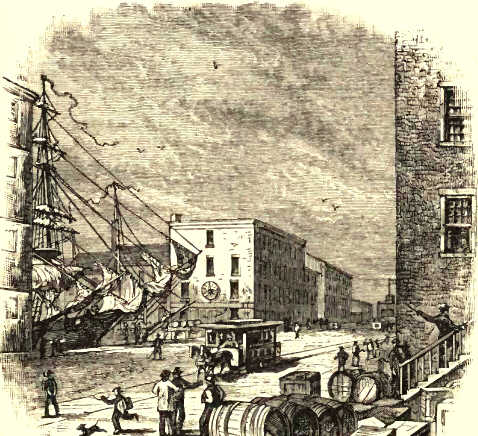
Scene of the First Bloodshed, at Baltimore.
Meanwhile the capital city was in great peril, devotees of the South
being each moment expected to make an attack upon it. Only fifteen
companies of local militia and six of regulars were present at
inauguration time, stationed by General Scott at critical points in the
city. Pickets were posted continually on roads and bridges outside. Four
hundred Pennsylvania troops happily arrived on April 18th, and the next
day came the Sixth Massachusetts. But the city was not yet secure. There
were reports that large bodies of men were gathering in Maryland and
Virginia for a descent upon it. Washington was put in a state of siege,
the public buildings barricaded and provided with sentinels. The
Government seized the Potomac steamers and also all the flour within
reach. Business ceased. Alarmed by rumors of a military impressment,
hundreds of government clerks, besides officers in the army and navy,
came out in their true colors and fled south. Enemies at Baltimore had
cut off telegraphic communication between Washington and the North.
Reports came that re-enforcements were on the way, but day followed day
without witnessing their arrival. The President and all Unionists were
in an agony of suspense.
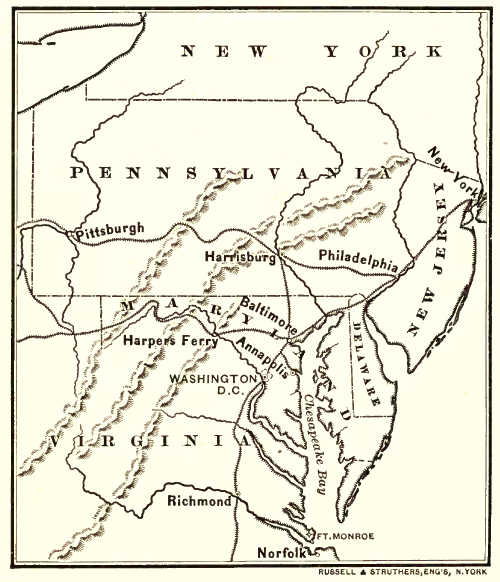
The Routes of Approach to Washington.
Russell & Struthers, Eng's, N. York.
On April 22d the Eighth Massachusetts, under General B. F. Butler, and
the famous Seventh Regiment from New York City, met at Annapolis. Here
they were delayed several days. Governor Hicks had warned them not to
land on Maryland soil. The railroad to Washington had been torn up for
many miles and the engines damaged. Among his troops Butler found the
very machinists who had made the engines. Repairs were promptly
effected, the track re-laid, and about noon of the 25th the gallant New
Yorkers landed in Washington amid the joyful shouts of the loyal
populace. Up Pennsylvania Avenue swept the solid ranks, bands playing
and colors flying, to gladden the heart of the careworn President as he
welcomed them at the White House. A sudden change came over the city.
Secessionists slunk away, the faces of the loyal beamed with joy. The
national capital was safe.
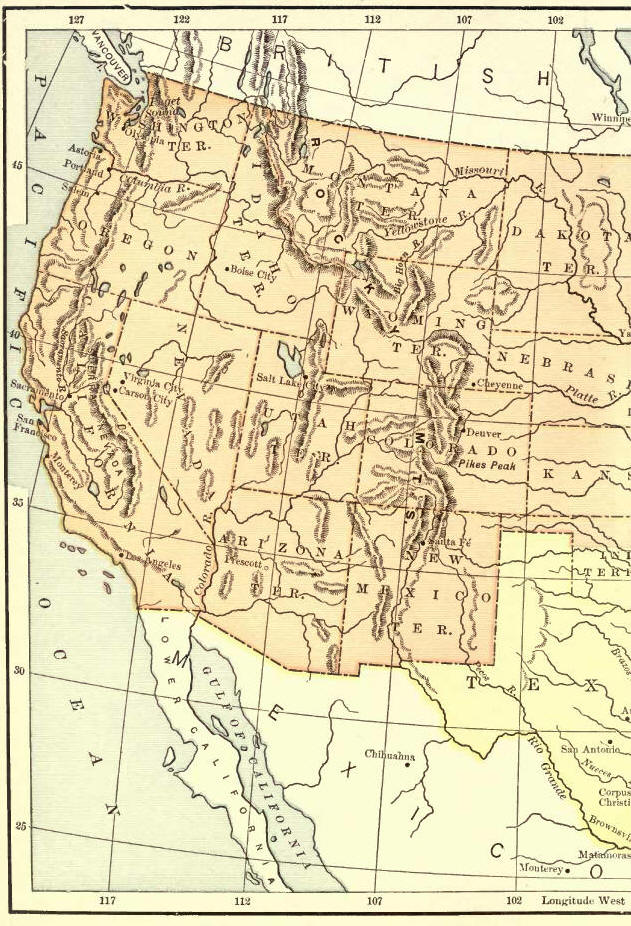
|
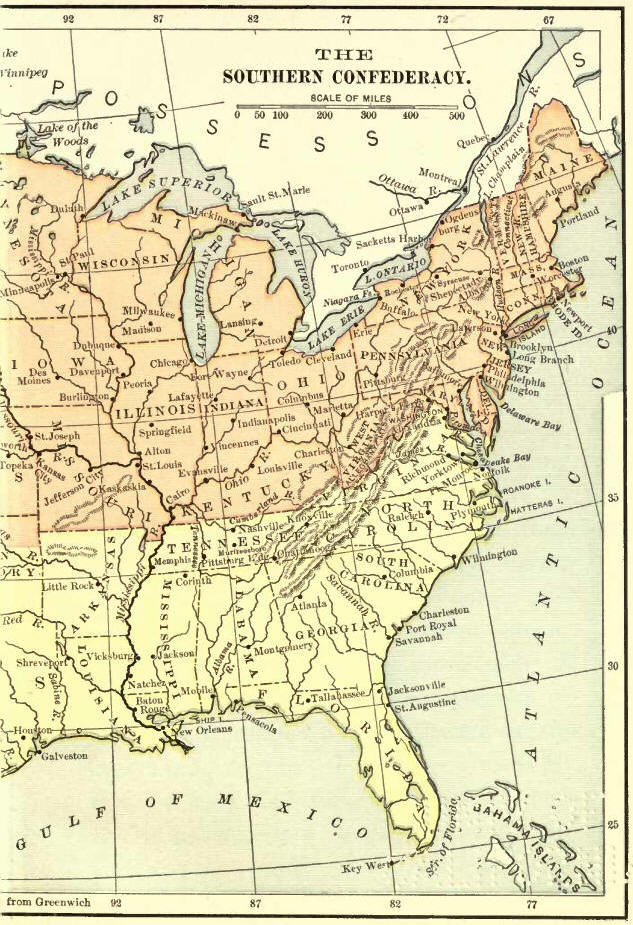
|
CHAPTER IV.
WAR BEGUN
[1861]
It was now apparent to both North and South that war was inevitable. Yet
neither side believed the other in full earnest or dreamed of a long
struggle. Sanguine northerners looked to see the rebellion stamped out
in thirty days. The more cautious allowed three months.
The President, however, soon saw that more troops, enlisted for a longer
term, would be necessary. At the outset the South certainly possessed
decided advantages: greater earnestness, more men of leisure aching for
war and accustomed to saddle and firearms, a militia better organized,
owing to fear of slave insurrections, and now for a long time in special
training, and withal a certain soldierly fire and dash native to the
people. The South also had superior arms. Enlistments there were prompt
and abundant. The troops were ably commanded, 262 of the 951 regular
army officers whom secession found in service, including many very high
in rank, joining their States in the new cause, besides a large number
of West Point graduates from civil life.
Accordingly on May 3d Mr. Lincoln issued a new call for troops, 42,000
volunteers to serve three years or during the war, 23,000 regulars, and
18,000 seamen. It was of first importance to secure Maryland for the
Union. On the night of May 13th, under cover of a thunderstorm, General
Butler suddenly entered rebellious Baltimore with less than 1,000 men,
and entrenched upon Federal Hill. Overawed by this bold move, the
secessionists made no resistance. A political reaction soon set in
throughout the State, which became firmly Unionist. Baltimore was once
more open to the passage of troops, who kept steadily hurrying to the
front.
Meanwhile the Confederate forces were getting uncomfortably close to
Washington. From the White House a secession flag could be seen flying
at Alexandria, which was occupied by a small pro-secession garrison.
There was fear lest that party would occupy Arlington Heights, across
from Washington, and thence pour shot and shell into the city. At two
o'clock on the morning of May 24th, eight regiments crossed the Potomac
and took possession of these hills as far south as Alexandria, and
fortified them. The latter place was entered by Colonel Ellsworth with
his famous New York Zouaves. No resistance was made, as the Confederates
had retired, but Ellsworth was brutally assassinated while hauling down
the secession flag.
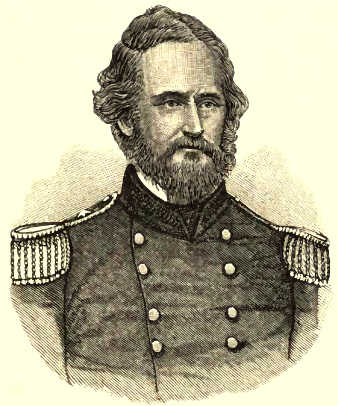
Captain Nathaniel Lyon.
Upon the secession of Virginia the Confederate capital was removed to
Richmond. The main armies of both sides were now encamped on Old
Dominion soil, and at no great distance apart; but the commanders were
busy drilling their raw troops, so that for a time only trifling
engagements occurred. General Butler, with a considerable body of men,
was occupying Fortress Monroe, at the mouth of the James River. June
10th, an expedition sent by him against the Confederates at Big Bethel,
some twelve miles distant, was repulsed after a spirited attack, with a
total loss of sixty-eight. A week later an Ohio regiment took the cars
to make a reconnoissance toward Vienna, a village not far south of
Washington. They were surprised by Confederates, who placed two guns on
the track and fired on the train as it came around a curve. The Ohioans
sprang to the ground, and after some fighting drove their opponents
back.
All this time both North and South were struggling for possession of the
neutral States. Governor Jackson, of Missouri, was straining every nerve
to force his State into secession. Early in May two or three regiments
of militia were got together and drilled in a camp near St. Louis.
Cannon were sent by President Davis, boxed up and marked "marble."
Captain Lyon, of the regular army, who held the St. Louis arsenal with a
few companies, reconnoitred the secessionist camp in female dress. The
next day, May 10th, assisted by local militia, he suddenly surrounded it
and took 1,200 prisoners. A month later he embarked some soldiers on
three swift steamers, sailed up the Missouri to Jefferson City, the
state capital, and raised the Union flag once more over the State House.
Governor Jackson fled. During the next month all the armed disunionists
were driven into the southwestern part of the State.
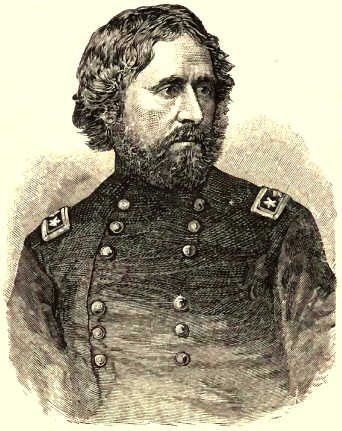
General John C. Fremont.
The last of July a state convention organized a provisional government
and declared for the Union. But the secessionists, under General Price,
continued the struggle. The Union forces, after a brave fight against
great odds at Wilson's Creek, August 10th, in which Lyon was killed, had
to retreat north. General Fremont had shortly before been put at the
head of the Western Department, which included Missouri, Kentucky,
Illinois, and Kansas. His difficulties were great. He was unable to
clear the State of secessionists, who besieged Lexington and took it on
September 20th. Generals Hunter and Halleck, Fremont's successors, were
equally unsuccessful, and the State was harassed by a petty warfare all
the year.
In Kentucky, Governor Magoffin was inclined to secession. The
Legislature leaned the other way, but preferred neutrality to active
participation on either side. September 6th, Brigadier-General U. S.
Grant occupied Paducah, an important strategical point at the junction
of the Ohio and Tennessee rivers. Next day the Confederate General Polk,
advancing from below, took possession of Columbus on the Mississippi.
With both hostile armies thus encamped on her soil, Kentucky could no
longer be neutral. Her decision was quickly taken. The Legislature
demanded of President Davis to withdraw Polk's forces, at the same time
calling upon General Anderson, the hero of Sumter, who had been placed
in charge of the Department of the Cumberland, to take active measures
for the defence of this his native State.
The mountain portion of Virginia belonged to the West rather than to the
South. It contained only 18,000 slaves, against nearly 500,000 in
Eastern Virginia. Union sentiment was therefore strong, and when the old
State seceded from the Union, Western Virginia proceeded to secede from
the State. General Lee sent troops to hold it for the Confederacy.
Thereupon General McClellan, commanding the Department of the Ohio,
threw several regiments across the river into Virginia, and defeated the
foe in minor engagements at Philippi, Rich Mountain, and Carrick's Ford.
By the middle of July he was able to report, "Secession is killed in
this country." Later in the year the Confederates renewed their
attempts, but were finally driven out. West Virginia organized a
separate government, and was subsequently admitted to the Union as a
State by itself.
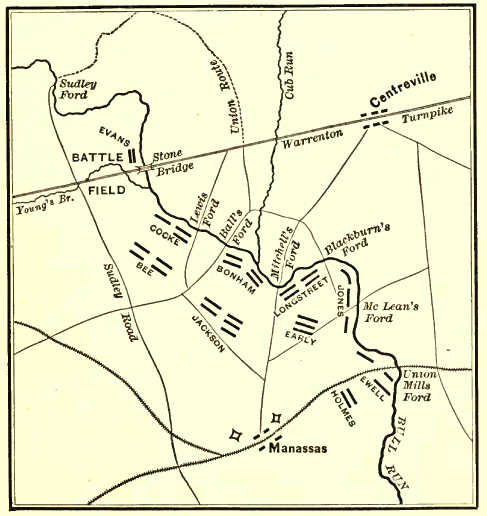
Bull Run--the Field of Strategy.
While these struggles were going on in the border commonwealths, the
Union soldiers lay inactive along the Potomac. Constant drill had
changed the mob into some semblance of an organized army, but the
careful Scott feared to risk a general engagement. The hostile forces
stretched in three pairs of groups across Virginia from northwest to
southeast. In the southeastern part of the State, at Fortress Monroe,
Butler faced the Confederate Magruder. At Manassas, opposite Washington,
and about thirty miles southwest, lay a Confederate army under General
Beauregard. General Patterson, a veteran of the War of 1812, commanded
considerable forces in Southern Pennsylvania. About the middle of June
he advanced against Harper's Ferry, which had been abandoned by the
Unionists the latter part of April and was now occupied by General
Joseph E. Johnston. Johnston evacuated the place upon Patterson's
approach, and retreated up the Shenandoah Valley, in a southwesterly
direction, to Winchester. Patterson followed part way, and the two
armies now lay watching each other.
Anxious to see the rebellion put down by one blow, the North was
becoming impatient. "On to Richmond!" was the ceaseless cry. Yielding to
this, Scott ordered an advance. July 16th, General McDowell, leaving one
division to protect Washington, led forth an army 28,000 strong to
attack the enemy at Manassas. He advanced slowly and with great caution.
The enemy were found posted in a line eight miles long upon the south
bank of Bull Run, a small river three miles east of Manassas, running in
a southeasterly direction. Several days were spent in reconnoitering.
Meanwhile, Johnston, whom Patterson was expected to hold at Winchester,
had stolen away to join Beauregard, their combined forces numbering
about 30,000. McDowell was ignorant of Johnston's movement, supposing
him still at Winchester.
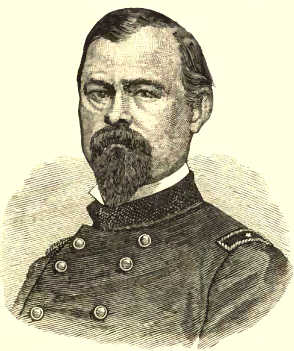
General Irvin McDowell.
On the morning of the 21st McDowell advanced to the attack. Beauregard
held all the lower fords, besides a stone bridge on the Warrenton
turnpike which crosses the river at right angles. Two divisions, under
Hunter and Heintzelman, were set in motion before sunrise to make a
flanking detour and cross Bull Run at Sudley's Ford, some distance
farther up. To distract attention from this movement, Tyler's division
began an attack at the stone bridge. This was held by a regiment and a
half, with four guns, under General Evans. He replied vigorously at
first, but perceiving after a while that Tyler was only feigning, and
learning of the flank movement above, he left four companies at the
bridge and drew up the rest of his forces on a ridge north of Warrenton
turnpike to await Hunter and Heintzelman's approach down the Sudley
road.
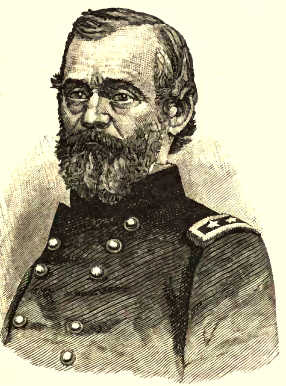
General Samuel P. Heintzelman.
The fight began about ten o'clock. Both sides were soon re-enforced.
After two hours' stubborn fighting the Confederates were driven back
across the pike, beyond Young's Branch of Bull Run, and took up a second
position on a hill each side of the Henry House. The whole Union force
had now crossed Bull Run. Griffin's and Ricketts' powerful batteries
were posted in favorable positions, whence they poured a deadly fire
upon the Confederates. The whole Union line advanced to the turnpike.
About two o'clock the Confederates were forced to abandon their second
position and fall back still farther.
Early in the morning Beauregard and Johnston had given orders for an
attack upon the Union forces across the river, not knowing that McDowell
had assumed the offensive. These orders were now countermanded, and all
available troops hurried up the Sudley road toward the Warrenton pike
front. Till after noon the prospect for the Confederates looked gloomy.
They had been steadily driven back. Some of their regiments had lost
heavily, while all were more or less demoralized. Johnston and
Beauregard gave their personal direction to re-forming the line upon a
second ridge to the south of the Warrenton pike, under cover of a
semicircular piece of woods. Twelve regiments, with twenty-two guns and
two companies of cavalry, concentrated in this favorable position and
awaited the Union advance.
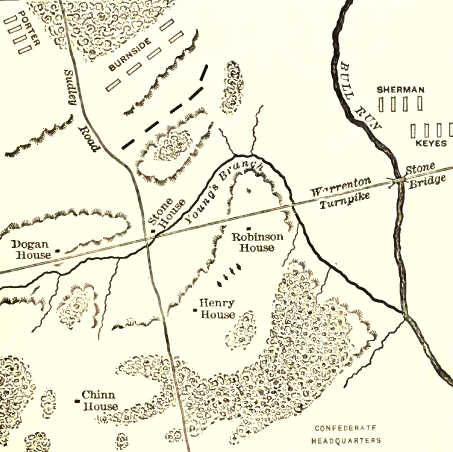
Bull Run-Battle of the Forenoon.
McDowell had fourteen regiments available for the attack. He decided to
hurl them against the Confederate centre and left. About half-past two
Griffin's and Ricketts' batteries took up an advanced position on Henry
Hill. The Confederate guns opened fire, and a short artillery duel took
place. A Confederate regiment now advances to capture the exposed
batteries. They are mistaken for Union re-enforcements and allowed to
come within close range. The muskets are levelled. A terrible volley is
poured into the batteries. The gunners are stricken down. The frantic
horses dash madly down the hill. After a little confusion the Union
troops boldly advance and retake the batteries. The battle surges back
and forth. The guns are three times captured and lost again. The fight
becomes general along the Confederate centre and left. The Union
generals are getting alarmed. So far they have been confident of
victory. Now regiment after regiment is going to pieces in this terrific
melee, and still the "rebels" hold their ground. About half-past four
o'clock General Early arrives by rail with three thousand more of
Johnston's army, and, assisted by a battery and five companies of
cavalry, bursts upon the extreme right flank and rear of McDowell's
line.
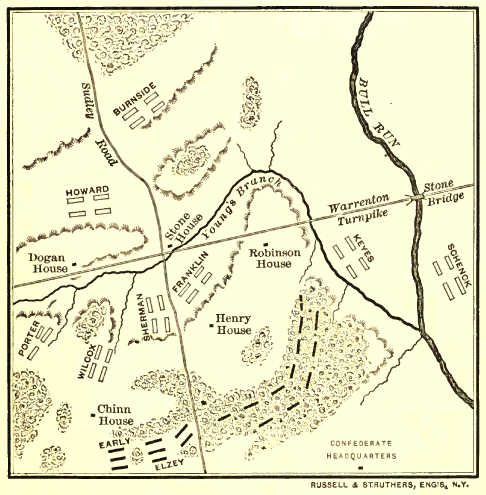
Bull Run--Battle of the Afternoon.
This manoeuvre decided the day. The Union ranks waver, break, flee. The
centre and left soon follow, though in better order. Union and
Confederate generals alike were astonished at the sudden change.
McDowell found it impossible to stem the tide once set in, and gave
orders to fall back across Bull Run to Centreville, where his reserves
were stationed. As the retreat went on it turned to a downright rout.
The Confederates made only a feeble pursuit, but fear of pursuit spread
alarm through the flying ranks, demoralized by long marching and hard
fighting. Baggage and ammunition-wagons, ambulances, private vehicles
which had been standing in the rear, joined the sweeping tide, adding to
the confusion and in some places causing temporary blockade. Frightened
teamsters cut traces and galloped recklessly away. Panic and stampede
resulted, soon reaching the soldiers. Flinging away muskets and
knapsacks, they sought safety in flight. The army entered Centreville a
disorganized mass. Fugitives could not be stayed even there, but
streamed through and on toward Washington. McDowell gave the order to
continue the retreat. The reserve brigades, with the one regiment of
regulars, covered the rear in good order. All that night the crazy
hustle to the rear was kept up, and on Monday the hungry and exhausted
stragglers poured into Washington under a drizzling rain, the people
receiving them with heavy hearts but generous hands.
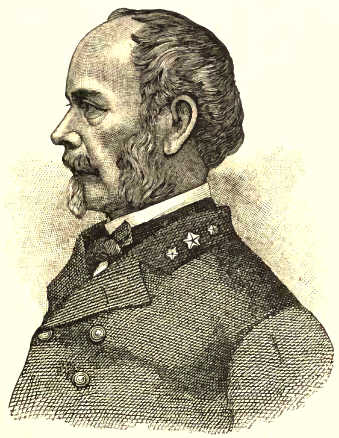
General Joseph E. Johnston.
The Union loss was 481 killed, 1,011 wounded, 1,460 prisoners.
Twenty-five guns were lost, thirteen of them on the retreat. The
Confederate loss was 387 killed, 1,580 wounded. The numbers actively
engaged were about 18,000 on each side. General Sherman pronounced Bull
Run "one of the best planned battles of the war, but one of the worst
fought." The latter fact was but natural. The troops on both sides were
poorly drilled, and most of them had never been under fire before.
Precision of movement, concert of action on any large scale, were
impossible. Neither side needed to be ashamed of this initial trial.
The North was at first much cast down. The faint-hearted considered the
Union hopelessly lost, but pluck and patriotism carried the day. On the
morrow after the battle Congress voted that an army of 500,000 should be
raised, and appropriated $500,000,000 to carry on the war. General
McClellan, whose brilliant campaign in West Virginia had won him easy
fame, was put in command of the Army of the Potomac. The young general
was a West Point graduate and had served with distinction in the Mexican
War. An accomplished military student, a skilful engineer, and a superb
organizer, he threw himself with energy into the task of fortifying
Washington and building up a splendid army. Many of the three-months
volunteers re-enlisted. Thousands of new recruits came flocking to camp,
and before long companies, regiments, and brigades amounting to 150,000
men were drilling daily on the banks of the Potomac, while formidable
works crowned the entire crest of Arlington Heights. In October the aged
General Scott resigned, and McClellan, at the summit of his popularity
with army and people, became commander-in-chief.
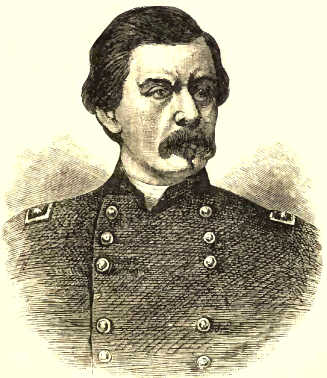
General George B. McClellan.
For several weeks after Bull Run it was feared that Beauregard and his
men would descend upon Washington, then in a defenceless condition; but
they were in no state to attack. They too felt the need of preparation
for the coming struggle, whose magnitude both sides now began to
realize.
A disheartening affair occurred in October. On the night of the 20th two
Massachusetts regiments crossed the Potomac at Ball's Bluff, a few miles
above Washington, to surprise a hostile camp which according to rumor
had been established there. A large force concealed in the woods
attacked and forced them to retreat. They were re-enforced by 1,900 men
under Colonel Baker. The enemy were also re-enforced. Baker was killed
and the Union soldiers driven over the bluff into the river. The boats
were totally inadequate in number, and the men had to make their way
across as best they could, exposed to the Confederate fire. The total
Union loss was 1,000.
On the whole, then, the South had reason to be gratified with the
aggregate result of the first year of war. Bull Run gave the
Confederates a sense of invincibility, and the ready recognition by the
foreign powers of their rights as belligerents, offered hope that
England would soon acknowledge their independence itself. And they
thought that the North had been doing its best when it had only been
getting ready.
END OF VOLUME III.
HISTORY OF THE UNITED STATES
End of the Project Gutenberg EBook of History of the United States, Volume 3
(of 6), by E. Benjamin Andrews
*** END OF THIS PROJECT GUTENBERG EBOOK HISTORY OF THE UNITED STATES ***
***** This file should be named 23748-h.htm or 23748-h.zip *****
This and all associated files of various formats will be found in:
http://www.gutenberg.org/2/3/7/4/23748/
Produced by Don Kostuch
Updated editions will replace the previous one--the old editions
will be renamed.
Creating the works from public domain print editions means that no
one owns a United States copyright in these works, so the Foundation
(and you!) can copy and distribute it in the United States without
permission and without paying copyright royalties. Special rules,
set forth in the General Terms of Use part of this license, apply to
copying and distributing Project Gutenberg-tm electronic works to
protect the PROJECT GUTENBERG-tm concept and trademark. Project
Gutenberg is a registered trademark, and may not be used if you
charge for the eBooks, unless you receive specific permission. If you
do not charge anything for copies of this eBook, complying with the
rules is very easy. You may use this eBook for nearly any purpose
such as creation of derivative works, reports, performances and
research. They may be modified and printed and given away--you may do
practically ANYTHING with public domain eBooks. Redistribution is
subject to the trademark license, especially commercial
redistribution.
*** START: FULL LICENSE ***
THE FULL PROJECT GUTENBERG LICENSE
PLEASE READ THIS BEFORE YOU DISTRIBUTE OR USE THIS WORK
To protect the Project Gutenberg-tm mission of promoting the free
distribution of electronic works, by using or distributing this work
(or any other work associated in any way with the phrase "Project
Gutenberg"), you agree to comply with all the terms of the Full Project
Gutenberg-tm License (available with this file or online at
http://gutenberg.org/license).
Section 1. General Terms of Use and Redistributing Project Gutenberg-tm
electronic works
1.A. By reading or using any part of this Project Gutenberg-tm
electronic work, you indicate that you have read, understand, agree to
and accept all the terms of this license and intellectual property
(trademark/copyright) agreement. If you do not agree to abide by all
the terms of this agreement, you must cease using and return or destroy
all copies of Project Gutenberg-tm electronic works in your possession.
If you paid a fee for obtaining a copy of or access to a Project
Gutenberg-tm electronic work and you do not agree to be bound by the
terms of this agreement, you may obtain a refund from the person or
entity to whom you paid the fee as set forth in paragraph 1.E.8.
1.B. "Project Gutenberg" is a registered trademark. It may only be
used on or associated in any way with an electronic work by people who
agree to be bound by the terms of this agreement. There are a few
things that you can do with most Project Gutenberg-tm electronic works
even without complying with the full terms of this agreement. See
paragraph 1.C below. There are a lot of things you can do with Project
Gutenberg-tm electronic works if you follow the terms of this agreement
and help preserve free future access to Project Gutenberg-tm electronic
works. See paragraph 1.E below.
1.C. The Project Gutenberg Literary Archive Foundation ("the Foundation"
or PGLAF), owns a compilation copyright in the collection of Project
Gutenberg-tm electronic works. Nearly all the individual works in the
collection are in the public domain in the United States. If an
individual work is in the public domain in the United States and you are
located in the United States, we do not claim a right to prevent you from
copying, distributing, performing, displaying or creating derivative
works based on the work as long as all references to Project Gutenberg
are removed. Of course, we hope that you will support the Project
Gutenberg-tm mission of promoting free access to electronic works by
freely sharing Project Gutenberg-tm works in compliance with the terms of
this agreement for keeping the Project Gutenberg-tm name associated with
the work. You can easily comply with the terms of this agreement by
keeping this work in the same format with its attached full Project
Gutenberg-tm License when you share it without charge with others.
1.D. The copyright laws of the place where you are located also govern
what you can do with this work. Copyright laws in most countries are in
a constant state of change. If you are outside the United States, check
the laws of your country in addition to the terms of this agreement
before downloading, copying, displaying, performing, distributing or
creating derivative works based on this work or any other Project
Gutenberg-tm work. The Foundation makes no representations concerning
the copyright status of any work in any country outside the United
States.
1.E. Unless you have removed all references to Project Gutenberg:
1.E.1. The following sentence, with active links to, or other immediate
access to, the full Project Gutenberg-tm License must appear prominently
whenever any copy of a Project Gutenberg-tm work (any work on which the
phrase "Project Gutenberg" appears, or with which the phrase "Project
Gutenberg" is associated) is accessed, displayed, performed, viewed,
copied or distributed:
This eBook is for the use of anyone anywhere at no cost and with
almost no restrictions whatsoever. You may copy it, give it away or
re-use it under the terms of the Project Gutenberg License included
with this eBook or online at www.gutenberg.org
1.E.2. If an individual Project Gutenberg-tm electronic work is derived
from the public domain (does not contain a notice indicating that it is
posted with permission of the copyright holder), the work can be copied
and distributed to anyone in the United States without paying any fees
or charges. If you are redistributing or providing access to a work
with the phrase "Project Gutenberg" associated with or appearing on the
work, you must comply either with the requirements of paragraphs 1.E.1
through 1.E.7 or obtain permission for the use of the work and the
Project Gutenberg-tm trademark as set forth in paragraphs 1.E.8 or
1.E.9.
1.E.3. If an individual Project Gutenberg-tm electronic work is posted
with the permission of the copyright holder, your use and distribution
must comply with both paragraphs 1.E.1 through 1.E.7 and any additional
terms imposed by the copyright holder. Additional terms will be linked
to the Project Gutenberg-tm License for all works posted with the
permission of the copyright holder found at the beginning of this work.
1.E.4. Do not unlink or detach or remove the full Project Gutenberg-tm
License terms from this work, or any files containing a part of this
work or any other work associated with Project Gutenberg-tm.
1.E.5. Do not copy, display, perform, distribute or redistribute this
electronic work, or any part of this electronic work, without
prominently displaying the sentence set forth in paragraph 1.E.1 with
active links or immediate access to the full terms of the Project
Gutenberg-tm License.
1.E.6. You may convert to and distribute this work in any binary,
compressed, marked up, nonproprietary or proprietary form, including any
word processing or hypertext form. However, if you provide access to or
distribute copies of a Project Gutenberg-tm work in a format other than
"Plain Vanilla ASCII" or other format used in the official version
posted on the official Project Gutenberg-tm web site (www.gutenberg.org),
you must, at no additional cost, fee or expense to the user, provide a
copy, a means of exporting a copy, or a means of obtaining a copy upon
request, of the work in its original "Plain Vanilla ASCII" or other
form. Any alternate format must include the full Project Gutenberg-tm
License as specified in paragraph 1.E.1.
1.E.7. Do not charge a fee for access to, viewing, displaying,
performing, copying or distributing any Project Gutenberg-tm works
unless you comply with paragraph 1.E.8 or 1.E.9.
1.E.8. You may charge a reasonable fee for copies of or providing
access to or distributing Project Gutenberg-tm electronic works provided
that
- You pay a royalty fee of 20% of the gross profits you derive from
the use of Project Gutenberg-tm works calculated using the method
you already use to calculate your applicable taxes. The fee is
owed to the owner of the Project Gutenberg-tm trademark, but he
has agreed to donate royalties under this paragraph to the
Project Gutenberg Literary Archive Foundation. Royalty payments
must be paid within 60 days following each date on which you
prepare (or are legally required to prepare) your periodic tax
returns. Royalty payments should be clearly marked as such and
sent to the Project Gutenberg Literary Archive Foundation at the
address specified in Section 4, "Information about donations to
the Project Gutenberg Literary Archive Foundation."
- You provide a full refund of any money paid by a user who notifies
you in writing (or by e-mail) within 30 days of receipt that s/he
does not agree to the terms of the full Project Gutenberg-tm
License. You must require such a user to return or
destroy all copies of the works possessed in a physical medium
and discontinue all use of and all access to other copies of
Project Gutenberg-tm works.
- You provide, in accordance with paragraph 1.F.3, a full refund of any
money paid for a work or a replacement copy, if a defect in the
electronic work is discovered and reported to you within 90 days
of receipt of the work.
- You comply with all other terms of this agreement for free
distribution of Project Gutenberg-tm works.
1.E.9. If you wish to charge a fee or distribute a Project Gutenberg-tm
electronic work or group of works on different terms than are set
forth in this agreement, you must obtain permission in writing from
both the Project Gutenberg Literary Archive Foundation and Michael
Hart, the owner of the Project Gutenberg-tm trademark. Contact the
Foundation as set forth in Section 3 below.
1.F.
1.F.1. Project Gutenberg volunteers and employees expend considerable
effort to identify, do copyright research on, transcribe and proofread
public domain works in creating the Project Gutenberg-tm
collection. Despite these efforts, Project Gutenberg-tm electronic
works, and the medium on which they may be stored, may contain
"Defects," such as, but not limited to, incomplete, inaccurate or
corrupt data, transcription errors, a copyright or other intellectual
property infringement, a defective or damaged disk or other medium, a
computer virus, or computer codes that damage or cannot be read by
your equipment.
1.F.2. LIMITED WARRANTY, DISCLAIMER OF DAMAGES - Except for the "Right
of Replacement or Refund" described in paragraph 1.F.3, the Project
Gutenberg Literary Archive Foundation, the owner of the Project
Gutenberg-tm trademark, and any other party distributing a Project
Gutenberg-tm electronic work under this agreement, disclaim all
liability to you for damages, costs and expenses, including legal
fees. YOU AGREE THAT YOU HAVE NO REMEDIES FOR NEGLIGENCE, STRICT
LIABILITY, BREACH OF WARRANTY OR BREACH OF CONTRACT EXCEPT THOSE
PROVIDED IN PARAGRAPH F3. YOU AGREE THAT THE FOUNDATION, THE
TRADEMARK OWNER, AND ANY DISTRIBUTOR UNDER THIS AGREEMENT WILL NOT BE
LIABLE TO YOU FOR ACTUAL, DIRECT, INDIRECT, CONSEQUENTIAL, PUNITIVE OR
INCIDENTAL DAMAGES EVEN IF YOU GIVE NOTICE OF THE POSSIBILITY OF SUCH
DAMAGE.
1.F.3. LIMITED RIGHT OF REPLACEMENT OR REFUND - If you discover a
defect in this electronic work within 90 days of receiving it, you can
receive a refund of the money (if any) you paid for it by sending a
written explanation to the person you received the work from. If you
received the work on a physical medium, you must return the medium with
your written explanation. The person or entity that provided you with
the defective work may elect to provide a replacement copy in lieu of a
refund. If you received the work electronically, the person or entity
providing it to you may choose to give you a second opportunity to
receive the work electronically in lieu of a refund. If the second copy
is also defective, you may demand a refund in writing without further
opportunities to fix the problem.
1.F.4. Except for the limited right of replacement or refund set forth
in paragraph 1.F.3, this work is provided to you 'AS-IS' WITH NO OTHER
WARRANTIES OF ANY KIND, EXPRESS OR IMPLIED, INCLUDING BUT NOT LIMITED TO
WARRANTIES OF MERCHANTIBILITY OR FITNESS FOR ANY PURPOSE.
1.F.5. Some states do not allow disclaimers of certain implied
warranties or the exclusion or limitation of certain types of damages.
If any disclaimer or limitation set forth in this agreement violates the
law of the state applicable to this agreement, the agreement shall be
interpreted to make the maximum disclaimer or limitation permitted by
the applicable state law. The invalidity or unenforceability of any
provision of this agreement shall not void the remaining provisions.
1.F.6. INDEMNITY - You agree to indemnify and hold the Foundation, the
trademark owner, any agent or employee of the Foundation, anyone
providing copies of Project Gutenberg-tm electronic works in accordance
with this agreement, and any volunteers associated with the production,
promotion and distribution of Project Gutenberg-tm electronic works,
harmless from all liability, costs and expenses, including legal fees,
that arise directly or indirectly from any of the following which you do
or cause to occur: (a) distribution of this or any Project Gutenberg-tm
work, (b) alteration, modification, or additions or deletions to any
Project Gutenberg-tm work, and (c) any Defect you cause.
Section 2. Information about the Mission of Project Gutenberg-tm
Project Gutenberg-tm is synonymous with the free distribution of
electronic works in formats readable by the widest variety of computers
including obsolete, old, middle-aged and new computers. It exists
because of the efforts of hundreds of volunteers and donations from
people in all walks of life.
Volunteers and financial support to provide volunteers with the
assistance they need, is critical to reaching Project Gutenberg-tm's
goals and ensuring that the Project Gutenberg-tm collection will
remain freely available for generations to come. In 2001, the Project
Gutenberg Literary Archive Foundation was created to provide a secure
and permanent future for Project Gutenberg-tm and future generations.
To learn more about the Project Gutenberg Literary Archive Foundation
and how your efforts and donations can help, see Sections 3 and 4
and the Foundation web page at http://www.pglaf.org.
Section 3. Information about the Project Gutenberg Literary Archive
Foundation
The Project Gutenberg Literary Archive Foundation is a non profit
501(c)(3) educational corporation organized under the laws of the
state of Mississippi and granted tax exempt status by the Internal
Revenue Service. The Foundation's EIN or federal tax identification
number is 64-6221541. Its 501(c)(3) letter is posted at
http://pglaf.org/fundraising. Contributions to the Project Gutenberg
Literary Archive Foundation are tax deductible to the full extent
permitted by U.S. federal laws and your state's laws.
The Foundation's principal office is located at 4557 Melan Dr. S.
Fairbanks, AK, 99712., but its volunteers and employees are scattered
throughout numerous locations. Its business office is located at
809 North 1500 West, Salt Lake City, UT 84116, (801) 596-1887, email
business@pglaf.org. Email contact links and up to date contact
information can be found at the Foundation's web site and official
page at http://pglaf.org
For additional contact information:
Dr. Gregory B. Newby
Chief Executive and Director
gbnewby@pglaf.org
Section 4. Information about Donations to the Project Gutenberg
Literary Archive Foundation
Project Gutenberg-tm depends upon and cannot survive without wide
spread public support and donations to carry out its mission of
increasing the number of public domain and licensed works that can be
freely distributed in machine readable form accessible by the widest
array of equipment including outdated equipment. Many small donations
($1 to $5,000) are particularly important to maintaining tax exempt
status with the IRS.
The Foundation is committed to complying with the laws regulating
charities and charitable donations in all 50 states of the United
States. Compliance requirements are not uniform and it takes a
considerable effort, much paperwork and many fees to meet and keep up
with these requirements. We do not solicit donations in locations
where we have not received written confirmation of compliance. To
SEND DONATIONS or determine the status of compliance for any
particular state visit http://pglaf.org
While we cannot and do not solicit contributions from states where we
have not met the solicitation requirements, we know of no prohibition
against accepting unsolicited donations from donors in such states who
approach us with offers to donate.
International donations are gratefully accepted, but we cannot make
any statements concerning tax treatment of donations received from
outside the United States. U.S. laws alone swamp our small staff.
Please check the Project Gutenberg Web pages for current donation
methods and addresses. Donations are accepted in a number of other
ways including checks, online payments and credit card donations.
To donate, please visit: http://pglaf.org/donate
Section 5. General Information About Project Gutenberg-tm electronic
works.
Professor Michael S. Hart is the originator of the Project Gutenberg-tm
concept of a library of electronic works that could be freely shared
with anyone. For thirty years, he produced and distributed Project
Gutenberg-tm eBooks with only a loose network of volunteer support.
Project Gutenberg-tm eBooks are often created from several printed
editions, all of which are confirmed as Public Domain in the U.S.
unless a copyright notice is included. Thus, we do not necessarily
keep eBooks in compliance with any particular paper edition.
Most people start at our Web site which has the main PG search facility:
http://www.gutenberg.org
This Web site includes information about Project Gutenberg-tm,
including how to make donations to the Project Gutenberg Literary
Archive Foundation, how to help produce our new eBooks, and how to
subscribe to our email newsletter to hear about new eBooks.























































































